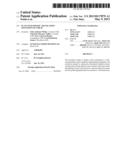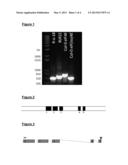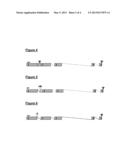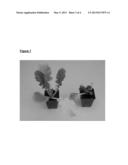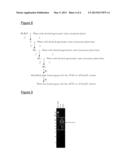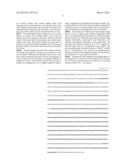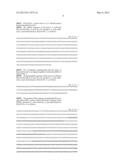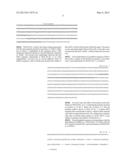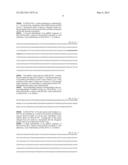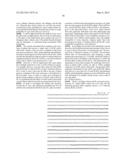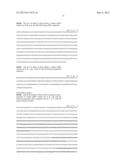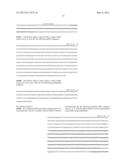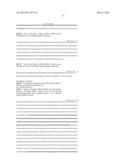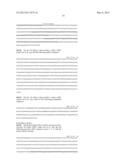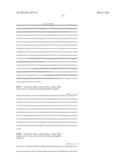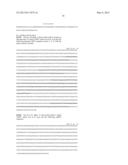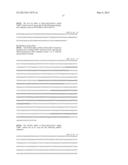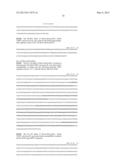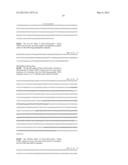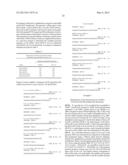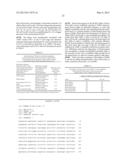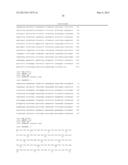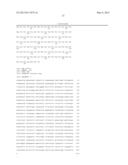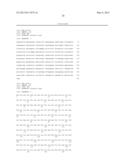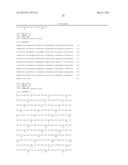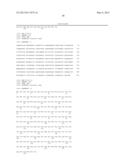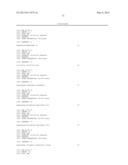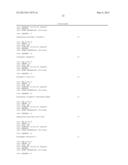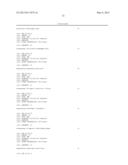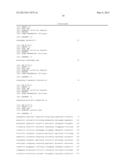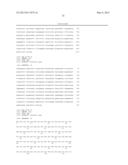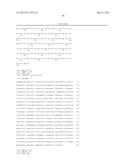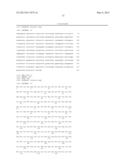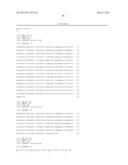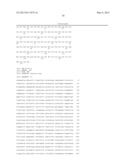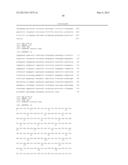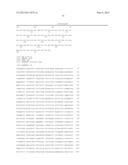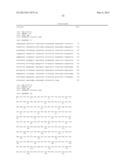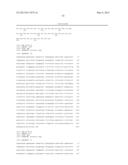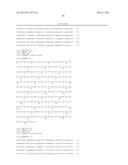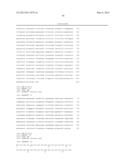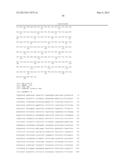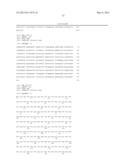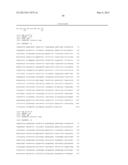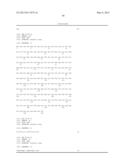Patent application title: Plant Eukaryotic Translation Initiation Factor 4E
Inventors:
John Anthony Walsh (Coventry, GB)
Charlotte Florence Nellist (Coventry, GB)
Guy Cameron Barker (Leamington, GB)
Carol Elizabeth Jenner (Broadway, GB)
Assignees:
Syngenta Participations AG
IPC8 Class: AC07K14415FI
USPC Class:
800265
Class name: Multicellular living organisms and unmodified parts thereof and related processes method of using a plant or plant part in a breeding process which includes a step of sexual hybridization breeding for pathogen or pest resistance or tolerance
Publication date: 2013-05-09
Patent application number: 20130117879
Abstract:
The invention relates to plants, and in particular to virus-resistant
plants, and to methods of generating such plants. The invention extends
to eukaryotic translation initiation factor variants and isoforms
thereof, and to nucleic acids involved in the splicing of such variant
factors, and uses thereof in methods for producing plants that are
resistant to viral infections.Claims:
1. An isolated plant eukaryotic translation initiation factor 4E (eIF4E)
variant or an isoform thereof (eIF(iso)4E), which is non-functional for a
virus, wherein nucleic acid encoding the eIF4E or eIF(iso)4E is
mis-spliced.
2. An isolated plant eukaryotic translation initiation factor 4E (eIF4E) variant or an isoform thereof (eIF(iso)4E) according to claim 1, wherein the mis-spliced gene encoding eIF4E or eIF(iso)4E is caused by a modification in said nucleic acid sequence.
3. An isolated plant eukaryotic translation initiation factor 4E (eIF4E) variant or an isoform thereof (eIF(iso)4E) according to claim 2, wherein the modification occurs in a non-coding region of the gene.
4. An isolated plant eukaryotic translation initiation factor 4E (eIF4E) variant or an isoform thereof (eIF(iso)4E) according to claim 2, wherein the modification occurs in a splice element in the nucleic acid sequence encoding eIF4E or eIF(iso)4E.
5. An isolated plant eukaryotic translation initiation factor 4E (eIF4E) variant or an isoform thereof (eIF(iso)4E) according to claim 2, wherein the modification is located in an intron of the nucleic acid sequence encoding eIF4E or eIF(iso)4E.
6. An isolated plant eukaryotic translation initiation factor 4E (eIF4E) variant or an isoform thereof (eIF(iso)4E) according to claim 2, wherein the modification is located in intron 1.
7. An isolated plant eukaryotic translation initiation factor 4E (eIF4E) variant or an isoform thereof (eIF(iso)4E) according to claim 2, wherein the modification comprises an insertion or a deletion of at least one base.
8. An isolated plant eukaryotic translation initiation factor 4E (eIF4E) variant or an isoform thereof (eIF(iso)4E) according to claim 2, wherein the modification comprises the insertion of at least one guanine.
9. An isolated plant eukaryotic translation initiation factor 4E (eIF4E) variant or an isoform thereof (eIF(iso)4E) according to claim 2, wherein the modification comprises an insertion at position 201 of SEQ ID No. 1, preferably a guanine.
10. An isolated plant eukaryotic translation initiation factor 4E (eIF4E) variant or an isoform thereof (eIF(iso)4E) according to claim 1, comprising an amino acid sequence substantially as set out in SEQ ID No: 6, 8 or 10, or a variant or fragment thereof.
11. An isolated plant eukaryotic translation initiation factor 4E (eIF4E) variant or an isoform thereof (eIF(iso)4E) according to claim 1, wherein the nucleic acid, which encodes the eIF4E or eIF(iso)4E protein, comprises a sequence substantially as set out in SEQ ID No: 4, 5, 7 or 9, or a variant or fragment thereof.
12. An isolated nucleic acid sequence encoding an alternatively spliced variant of a plant eukaryotic translation initiation factor 4E (eIF4E), or an isoform thereof (eIF(iso)4E), wherein the nucleic acid sequence is mis-spliced such that the eIF4E or eIF(iso)4E is non-functional for a virus.
13. An isolated nucleic acid sequence according to claim 12, wherein the mis-spliced nucleic acid sequence is caused by a modification in the nucleic acid sequence.
14. A recombinant vector comprising the nucleic acid sequence according to claim 13.
15. A host cell comprising the vector according to claim 14.
16. A method for detecting, in a test plant, the presence of a plant eukaryotic translation initiation factor 4E (eIF4E) variant, or an isoform thereof (eIF(iso)4E), which is non-functional for a virus, wherein nucleic acid encoding the eIF4E or eIF(iso)4E is mis-spliced, the method comprising the steps of: (i) isolating RNA from a test plant; (ii) producing cDNA from the RNA isolated in step (i) using primers specific for eIF4E or eIF(iso)4E; (iii) determining the sequence of the cDNA produced in step (ii); and (iv) comparing the cDNA sequence determined in step (iii) with the cDNA sequence of wild-type eIF4E or eIF(iso)4E, wherein a variation in the sequence of step (iii) compared to the wild-type sequence indicates that the nucleic acid encoding the eIF4E or eIF(iso)4E in the test plant is mis-spliced and is a variant of eIF4E or eIF(iso)4E.
17. The method according to claim 16, further comprising a step of identifying the modification in the plant genome that causes mis-splicing of eIF4E or eIF(iso)4E, wherein said identification step comprises breeding the test plant such that it is homozygous for a eIF4E or eIF(iso)4E gene.
18. The method according to claim 17, wherein the modification occurs in a non-coding region of the gene encoding eIF4E or eIF(iso)4E.
19. A method for selecting a virus-resistant plant, the method comprising detecting, in a test plant, the presence of:-- (i) a plant eukaryotic initiation factor 4E (eIF4E) variant or an isoform thereof (eIF(iso)4E) according to claim 1; and (ii) at least one copy of wild-type eIF4E or eIF(iso)4E, wherein the wild-type copy of eIF4E or eIF(iso)4E can be used by the plant, but cannot be used by a virus.
20. Use of a plant eukaryotic initiation factor 4E (eIF4E) variant or an isoform thereof (eIF(iso)4E) according to claim 1, or a nucleic acid encoding the same, for inducing viral-resistance in a plant.
21. A method for producing a virus-resistant plant, the method comprising crossing a parent plant that expresses a plant eukaryotic initiation factor 4E (eIF4E) variant or an isoform thereof (eIF(iso)4E) according to claim 1 with a recipient plant, the recipient comprising at least one trait, selected from a group consisting of an agronomic advantage, a commercial advantage, and/or suitability for a particular climate or soil.
22. A virus-resistant plant produced by or obtainable by the method according to claim 21.
23. A virus-resistant plant comprising the plant eukaryotic translation initiation factor 4E (eIF4E) variant or an isoform thereof (eIF(iso)4E) according to claim 1 or a nucleic acid encoding the same.
24. A virus-resistant plant according to claim 22, wherein the plant expresses at least one copy of wild-type eIF4E or eIF(iso)4E, wherein the wild-type copy of eIF4E or eIF(iso)4E can be used by the plant, but not by a virus.
25. A virus-resistant plant according to claim 22, wherein the plant is Brassica spp, preferably B. rapa and/or Brassica oleracea.
26. The method according to claim 16, comprising the use of a transgenic plant.
27. The method according to claim 16, wherein the plant is homozygous for eIF4E and/or eIF(iso)4E, which encodes the alternatively spliced variant of a plant eukaryotic translation initiation factor 4E (eIF4E), or an isoform thereof (eIF(iso)4E), which is non-functional for a virus.
28. The method according to claim 16, wherein, in order to confer virus resistance in plants having multiple copies/loci of eIF4E and/or eIF(iso)4E, the alleles of eIF4E and/or eIF(iso)4E at each of these other loci are also non-functional for the virus.
29. An isolated nucleic acid sequence encoding a plant eukaryotic translation initiation factor 4E (eIF4E), or an isoform thereof (eIF(iso)4E), wherein the eIF4E or eIF(iso)4E is non-functional for a virus, and wherein the nucleic acid sequence comprises a nucleotide sequence substantially as set out in SEQ ID No: 4, 5, 7, 9, 34, 35, 37, 38, 40, 41, 43, 44, 46, 47, 49, 50, 52, 53, 58 or 59, or a variant or fragment thereof.
30. An isolated plant eukaryotic translation initiation factor 4E (eIF4E) variant, or an isoform thereof (eIF(iso)4E), which is non-functional for a virus, wherein the eIF4E or eIF(iso)4E protein variant comprises an amino acid sequence substantially as set out in SEQ ID No: 6, 8, 10, 36, 39, 42, 45, 48, 51, 54 or 60, or a variant or fragment thereof.
31. The vector according to claim 14, comprising a nucleotide sequence substantially as set out in SEQ ID No: 4, 5, 7, 9, 34, 35, 37, 38, 40, 41, 43, 44, 46, 47, 49, 50, 52, 53, 58 or 59, or a variant or fragment thereof.
32. The vector according to claim 14 comprising an eIF4E or eIF(iso)4E protein variant which comprises an amino acid sequence substantially as set out in SEQ ID No: 6, 8, 10, 36, 39, 42, 45, 48, 51, 54 or 60, or a variant or fragment thereof.
33. The vector according to claim 14 comprising the use of a nucleotide sequence substantially as set out in SEQ ID No: 58 or 59, or a variant or fragment thereof, or the use of an eIF4E or eIF(iso)4E protein variant which comprises an amino acid sequence substantially as set out in SEQ ID No: 60, or a variant or fragment thereof.
34. The method according to claim 16, wherein the plant is of the family Solanaceae, such as potato, tomato, pepper or egg plant; Cucurbits, such as melons, squash and cucumbers; Cruciferous crops; Brassica spp; Brassica napus such as oilseed rape; Brassica rapa such as Chinese cabbage; Brassica oleracea such as broccoli, cauliflower, cabbage, savoy cabbage, Brussels sprouts, red cabbage; Brassica oleracea; Fabaceae peas, beans, pulses etc. or a monocotyledonous crop, including rice, maize, wheat, or barley etc.
Description:
[0001] The invention relates to plants, and in particular to
virus-resistant plants, and to methods of generating such plants. The
invention extends to eukaryotic translation initiation factor variants
and isoforms thereof, and to nucleic acids involved in the splicing of
such variant factors, and uses thereof in methods for producing plants
that are resistant to viral infections.
[0002] Viruses present a significant problem in agriculture. For example, plant viruses in the family Potyviridae (potyviruses) represent approximately 30% of plant viruses and are capable of infecting more than 30 different families of plants, leading to extensive crop damage and even death. In particular, the Solanaceae, Cucurbitaceae and Fabaceae plant families are especially sensitive to infection by potyviruses. Currently, in contrast to many bacterial or fungal infections, there are few ways to combat viral infections in plants. Due to the increasing size of the international market for plants and seeds, it is becoming more essential for plant breeders to develop plants that are resistant to infection from viruses, for example those from the Potyviridae family.
[0003] Upon infection of a plant host, plant viruses use some of the host's endogenous proteins to complete their own life cycle. For example, potyviruses, such as Turnip mosaic virus (TuMV), use plant eukaryotic translation initiation factors to bind plant ribosomes to the viral genomic RNA as a pre-requisite to translating their genomes into various viral proteins, including the viral RNA-dependent RNA polymerase that is essential to produce more copies of the virus. Therefore, defects in the plant eukaryotic translation initiation factors may confer viral resistance in plants. However, since the eukaryotic translation initiation factors are vital to the survival of plants, defects in the eukaryotic translation initiation factors are detrimental to plants, often resulting in plants that are non-viable.
[0004] It has been shown in a number of plant-potyvirus interactions that the potyvirus VPg (protein encoded by potyvirus RNA genome) is able to bind to the eIF4E protein and that mutations in members of the eIF4E gene family can confer resistance to potyviruses. Recessive resistance to infections by potyviruses is believed to arise from base changes in the coding region (i.e. the exons) of the genes encoding eIF4E and/or eIF(iso)4E, thereby resulting in eIF4E and/or eIF(iso)4E protein variants.
[0005] For example, Turnip mosaic virus (TuMV), which can normally infect Arabidopsis thaliana, can no longer infect A. thaliana plants that lack a functional eukaryotic translation initiation factor isoform (eIF(iso)4E) protein. Insertional mutagenesis of At.eIF(iso)4E using a defective maize transposon (dSpm) produced a plant line that was able to grow normally, and was resistant to TuMV infection. Additionally, chemically-induced point mutation of the A. thaliana eIF(iso)4E gene using ethylmethane sulphonate (EMS) named isp1 also conferred resistance to TuMV infection.
[0006] Although various mechanisms of viral resistance have been found in certain plants, these are mostly specific to virus strains. Dominant plant R genes predominantly provide strain-specific resistance to plant viruses, for example TuRB01 provides resistance to pathotype 1 isolates of TuMV, but is overcome by TuMV isolates belonging to other pathotypes including, 3, 4 and 12. Most examples of recessive resistance associated with mutations in eIF4E and eIF(iso)4E are also strain-specific and mutations in viral VPg and occasionally other viral proteins result in strains able to overcome such resistance.
[0007] Therefore, there is a need to induce virus resistance in plants that is not specific to any strains, and thereby confer broad spectrum virus resistance. There are some examples of broad spectrum resistance for some viruses but for most viruses in most crop types, there are no sources of broad spectrum resistance. Additionally, viruses are constantly mutating and genotypes able to overcome strain-specific and broad spectrum resistance are generated in susceptible plants and selected for by the cultivation of resistant plants. Most plant viruses have RNA genomes and RNA is known to have a particularly high mutation rate due to infidelity in the proof-reading mechanism. Consequently, new sources of broad spectrum resistance are required, particularly based on new mechanisms, in order to improve the durability of such resistances.
[0008] All previously reported recessive resistance to infection by viruses (such as potyviruses) based on eIF4E or eIF(iso)4E has arisen through base changes in the exons. Such bases changes cause alterations in the sequence of the eIF4E or eIF(iso)4E protein, for example altered amino acid residues in the translated protein, or premature chain termination resulting in a truncated protein. Hence, previous efforts in developing virus-resistant plant species, have focused on generating plant varieties, which harbour mutations in only the exons of either eIF4E or eIF(iso)4E. Surprisingly, however, the inventor has now identified for the first time that plant resistance to viruses, such as potyviruses, may be conferred by plant eIF4E or eIF(iso)4E protein variants that are produced from mis-splicing processes compared to that of the wild-type or native protein.
[0009] Accordingly, in a first aspect of the invention, there is provided an isolated plant eukaryotic translation initiation factor 4E (eIF4E) variant, or an isoform thereof (eIF(iso)4E), which is non-functional for a virus, wherein nucleic acid encoding the eIF4E or eIF(iso)4E is mis-spliced.
[0010] Previous examples of eIF4E and eIF(iso)4E have all involved mutations in the coding region of the genes. The inventors have now provided the first example of variation in the DNA sequence of an intron inducing virus resistance. Most changes in intron DNA sequence would not be predicted to provide resistance as the introns are spliced from the genes prior to translation and hence do not affect the protein. Additionally, mis-splicing of genes usually results in non-functional proteins, and the lack of the functional protein can be lethal, can lead to reduced fitness, or can have other adverse affects.
[0011] The term "eIF4E" is also known as eukaryotic translation initiation factor 4E, which is a key component in the initiation of protein synthesis. As will be known to the skilled technician, in plants, eIF4E forms a complex eIF4F (consisting of eIF4E and eIF4G). The precise biochemical role of a plant eIF4E protein in virus infection has yet to be identified. However, not wishing to be bound to any theory, the plant eIF4E may be capable of binding to the 5' cap structure (or a mimic) of the viral RNA, or the plant eIF4E may interact with the viral RNA directly. Alternatively, eIF4E may be involved in the cell-to-cell movement of the infecting virus in the host plant.
[0012] The term "eIF(iso)4E" refers to an isoform of eIF4E, and eIF(iso)4E has a similar function as eIF4E. eIF4E and eIF(iso)4E proteins from Arabidopsis thaliana are 44%-49% identical at the amino acid level. This is similar to values found for Brassica rapa line R-o-18 (47-50% identity) and Brassica rapa line Chiifu (43-50% identity).
[0013] The virus life cycle is totally dependent on using the host plant's translation machinery to turn viral nucleic acid into proteins. Without the viral proteins produced by the host translation machinery, no viral replicase protein is produced and so no more copies of the virus are made either. A number of viruses have been shown to be dependent on the host plant's translation complex and virus interactions with the plant eIF4E and/or eIF(iso)4E proteins have been demonstrated (the version used depends on the particular combination of virus species and plant species).
[0014] The skilled person will appreciate that mis-splicing can produce the eIF4E or eIF(iso)4E variant of the first aspect, which can therefore be described as being an alternatively spliced variant, compared to the wild-type or native eIF4E or eIF(iso)4E proteins. The genomic sequence of a gene, such as that encoding eIF4E or eIF(iso)4E, comprises coding regions (i.e. exons) and non-coding regions (i.e. introns). The introns and exons are transcribed into RNA termed "primary transcript, precursor to mRNA" (or "pre-mRNA"). The introns must be removed from the pre-mRNA so that the native protein encoded by the exons can be produced. The term "native protein" can mean the naturally occurring, wild-type or functional protein.
[0015] The removal of the introns from the pre-mRNA and subsequent ligation of the exons to each other is carried out in the splicing process. The splicing process usually consists of a series of reactions, mediated by splicing factors, which is carried out on the RNA after transcription, but before translation. Thus, a "pre-mRNA" is an RNA molecule which contains both exons and intron(s), and an "mRNA" is an RNA in which the intron(s) have been removed and the exons have been joined together sequentially so that the protein can then be translated therefrom by the ribosomes.
[0016] Introns are defined by a set of "splice elements" which are relatively short, conserved RNA segments which bind the various splicing factors that carry out the splicing reactions. Thus, each intron is defined by a 5' splice site, a 3' splice site, and a branch point situated there between.
[0017] The inventor has found that the protein variant of the first aspect may be caused by modifications in the splice element of the native DNA and/or pre-mRNA of eIF4E or eIF(iso)4E, which create a new, aberrant, splice element (compared to the wild-type). Therefore, in an embodiment of the invention, the mis-spliced gene encoding eIF4E or eIF(iso)4E may arise from a modification in a splice element, thereby producing an aberrant splice element. The aberrant splice element may cause altered splice patterns of the eIF4E or eIF(iso)4E pre-mRNA, giving rise to altered mRNA. Preferably, the resulting eIF4E protein variant or eIF(iso)4E protein variant of the first aspect is not functional for the virus in a plant, such that the plant is substantially resistant to viral infection.
[0018] The inventor has demonstrated that alterations in an intron of the gene encoding eIF4E or eIF(iso)4E (rather than in an exon) result in mis-splicing occurring, which results in a eIF4E variant or eIF(iso)4E variant protein being produced, which is non-functional for a virus, and thus confers virus resistance when present in a plant.
[0019] In one embodiment, the aberrant splice element may alter the native splice site at the 5'- or 3'-end of the intron (i.e. at the 5' native splice site or at the 3' native splice site of the intron), which creates a new, aberrant, splice site. It would be appreciated that the difference between the genomic DNA sequence and the sequence of mature message RNA defines the introns. The 5' and 3' ends of the introns define the native splice sites of a gene.
[0020] The aberrant splice site may be upstream or downstream of the native splice site. It would be appreciated by the skilled technician that the term "upstream" means towards the 5' end of the DNA or pre-mRNA molecule and may be denoted by the symbol "-". It would also be appreciated by the skilled technician that the term "downstream" means towards the 3' end of the DNA or pre-mRNA molecule, and may be denoted by the symbol "+". Hence, in an embodiment where the aberrant splice site may be 10 nucleotides upstream from the 5' native splice site of intron 1, the aberrant splice site may also be referred to as "-10 bp relative to the 5' splice site of intron 1".
[0021] In embodiments where the aberrant splice site is upstream of the 5' native splice site of an intron, some of the exon that is upstream of the intron may be excised during the splicing process. Therefore, the resulting mRNA may lack nucleotides of the excised exon. In embodiments where the aberrant splice site is downstream of the 5' native splice site of an intron, some of the intron may be retained during the splice event. Therefore, the resulting mRNA may comprise nucleotides of the retained intron.
[0022] In embodiments where the aberrant splice site is downstream of the 3' native splice site of an intron, some of the exon downstream of the intron may be excised during the splicing process. Therefore, the resulting mRNA may lack nucleotides of the excised exon. In embodiments where the aberrant splice site is upstream of the 3' native splice site of an intron, some, or all of the intron may be retained during the splice event. Therefore, the resulting mRNA may contain the retained intron nucleotides.
[0023] In an alternative embodiment, the altered splice pattern may comprise retaining at least one intron. The resultant mRNA molecule (i.e. mRNA variant) may therefore contain RNA sequence that corresponds to the retained intron or introns, and may be larger than the native mRNA molecule.
[0024] The amino acid sequence translated from the retained at least one intron, or part thereof may comprise a stop codon. The resulting protein (i.e. protein variant) may not be translated beyond the first stop codon and, hence, the protein variant may be smaller in size compared to the native protein. The stop codon that is introduced by the retained intron may be referred to as a premature stop codon because it causes translation of the mRNA to cease prematurely (the first wild-type stop codon of the gene being located further downstream). Therefore, the protein variant may have lack of function or an altered function compared to the wild-type or the native protein. The protein variant may be non-functional for a virus.
[0025] The codon reading frame of the retained at least one intron, or part thereof, may be in-frame or out-of-frame with the coding reading frame of the neighbouring exon(s). The resulting mRNA may encode an altered amino acid sequence, and hence, produce a protein variant. The protein variant may have lack of function or an altered function compared to the wild type or the native protein. The protein variant may be non-functional for a virus.
[0026] In an embodiment where the codon reading frame of the retained at least one intron, or part thereof, is out-of-frame with that of the neighbouring exon(s), the resulting protein (i.e. protein variant) may contain altered amino acid sequences may be truncated due to a premature stop codon. The resultant protein variant may have lack of function or an altered function compared to the wild type or the native protein. The protein variant may be non-functional for a virus.
[0027] In an embodiment where at least one exon, or a part thereof, is excised, the resulting mRNA may encode an altered amino acid sequence, and hence, produce a protein variant. The altered amino acid sequence may contain a premature stop codon. The protein variant may have lack of function, or an altered function compared to the wild type or the native protein. The protein variant may be non-functional for a virus.
[0028] The altered function of the eIF4E variant or eIF(iso)4E variant may comprise a decrease in its activity for translation initiation. When the mis-splicing occurs in intron 1, this may result in extremely truncated versions of the protein, or versions where most of the protein is completely different to functional versions. Not bound by theory, this may have a number of consequences, as it is highly unlikely to bind to other components of the eukaryotic initiation complex, particularly eIF4G or eIF(iso)4G and also unlikely to bind to the viral protein VPg, or messenger RNA cap. This will result in lack of translation of messenger RNA and/or viral RNA.
[0029] The inventor has carried out his experiments using Brassica rapa as a plant model, and has surprisingly found that B. rapa contains three eIF(iso)4E loci, and thus, has three protein isoforms of eIF(iso)4E, the protein isoforms being denoted eIF(iso)4E.a, eIF(iso)4E.b and eIF(iso)4E.c. He therefore investigated eIF(iso)4E.a in two plant lines. The first plant line, referred to herein as "R-o-18", is sensitive to infection with a virus (i.e. Turnip Mosaic virus, TuMV), and the second plant line, referred to herein as "RLR22", is resistant to viral infection. The inventor has determined the genomic, mRNA and polypeptide sequences for the eIF(iso)4E.a isoform of B. rapa, as discussed below.
[0030] The genomic DNA sequence encoding the native or wild type Brassica rapa eIF(iso)4E.a isoform, BraA.eIF(iso)4E.a, in line R-o-18 (sensitive to viral infection), is provided herein as SEQ ID No. 1, as follows:
TABLE-US-00001 SEQ ID No: 1 ATGGCGACAGAGGATGTGAACGAAGCCCTTGCGGCGGCGGAAGTACCGGCAACAGAGACGACGGAGAAGC AGCCTGCTCACAAGCTCGAAAGAAAGTGGAGTTTCTGGTTCGATAACCAATCCAAACCAAAGCAAGGCGC CGCCTGGGGAGCCTCCCTTCGCAAAGCCTATACCTTCGACACCGTCCAAGACTTCTGGGGGTTTGTTTGT CTTCTCCTTTTATTTATTGTTAGCGATCTGTAAAGCTAGATCTTCTTTTGCAGTTTGCACGAGACTATAT TCATCCCTAGCAAACTGACGCCGAATGCTGAAATTCACATGTTCAAAGCTGGTGTTGAGCCTAAGTGGGA AGATCCTGAGTGTGCTAATGGGGGAAAGTGGACTTATGTTGTCACCTCCAACCGCAAGCCTGCTTTAGAC AAGGCTTGGCTTGAAACTGTACTCCTCTTCTACCTCTCCTCCTTTTTTCTTTTTTTTTGCATCTGGTAAT GACATGTTTTCTCTGCCAGTTGATGGCTCTTGTCGGAGAGCAATTTGATGAGGCTGATGAGATTTGTGGC GTGGTTGCTAGTGTGCGCCCAAAGCAGGACAAGCTCTCCTTGTGGACAAGGACCAAATCTAATGAAGCTG TTCTGGTATGATGCTTGTCTTCTCTCACTATGTACCTTTGGTGTTGTTTGATAACTGTTTTCTTCTACTT GTTATCCGTTGCGATGTCCCATTATTGTTTGATTATCCTGTTCCAATTTTTTTGTATTGCGTACTGGTGG TTTACGAAGAAGTGTTCTTGTACAATATGTTAGCGTTGTTGAATGTGTTAATTGCTTACTATAGTAAAAC AGTTTAAGCTGTTGACTATGTTAATATTCTCTTCGATACACACACTTAGAATGGATAACTACCTTGTTTC TTTATCCTTTGGAGTTTCACCAGCTTATTATCGATCGAGATACTCCTTCTGATTTGAATTACCATTCAAG ATTAATATTTATATATATTGAAAGTATATGTTTGTTTAACGATATATCTATTAGGCTTGCTTTTTTTAGT TCATTCGCAGTATAAACGTAGCTCTATTTATTAGAGGCTTCTCTTTAGAACTTGGCAGTAATGTAATATG TCGAAGTGTGGTTTATGAATCTGGTTGATGATATTACTAATTTTTTTGTTTGTTATTGTAAATCCAGATG GGTATTGGGAAGAAGTGGAAGGAGATACTTGATGTCACCGACAAGATAACTTTCACTAACCATGTAACTT AACTTTCTCCACATAGAGGCTAATTATCTTTTGTTCTTCTTACGTGGCTTACTAAAATGTGGTCTACTTA TATATATAGGATGATTCTAGAAGAACTAGGTTCACTGTCTGA
[0031] SEQ ID No: 1 shows exons 1 to 5, with the introns being represented in bold.
[0032] The mRNA sequence of the native or wild type BraA.eIF(iso)4E.a in line R-o-18 (sensitive to viral infection), is provided herein as SEQ ID No. 2, as follows:
TABLE-US-00002 SEQ ID No: 2 AUGGCGACAGAGGAUGUGAACGAAGCCCUUGCGGCGGCGGAAGUACCGGCAACAGAGACGACGGAGAAGC AGCCUGCUCACAAGCUCGAAAGAAAGUGGAGUUUCUGGUUCGAUAACCAAUCCAAACCAAAGCAAGGCGC CGCCUGGGGAGCCUCCCUUCGCAAAGCCUAUACCUUCGACACCGUCCAAGACUUCUGGGGUUUGCACGAG ACUAUAUUCAUCCCUAGCAAACUGACGCCGAAUGCUGAAAUUCACAUGUUCAAAGCUGGUGUUGAGCCUA AGUGGGAAGAUCCUGAGUGUGCUAAUGGGGGAAAGUGGACUUAUGUUGUCACCUCCAACCGCAAGCCUGC UUUAGACAAGGCUUGGCUUGAAACUUUGAUGGCUCUUGUCGGAGAGCAAUUUGAUGAGGCUGAUGAGAUU UGUGGCGUGGUUGCUAGUGUGCGCCCAAAGCAGGACAAGCUCUCCUUGUGGACAAGGACCAAAUCUAAUG AAGCUGUUCUGAUGGGUAUUGGGAAGAAGUGGAAGGAGAUACUUGAUGUCACCGACAAGAUAACUUUCAC UAACCAUGAUGAUUCUAGAAGAACUAGGUUCACUGUCUGA
[0033] FIG. 3 illustrates schematically that the exons of BraA.eIF(iso)4E.a are ligated together to form the mRNA of SEQ ID No: 2.
[0034] The polypeptide sequence of the native or wild type BraA.eIF(iso)4E.a in line R-o-18 (sensitive to viral infection), is provided herein as SEQ ID No. 3, as follows:
TABLE-US-00003 SEQ ID No: 3 MATEDVNEALAAAEVPATETTEKQPAHKLERKWSFWFDNQSKPKQGAAWGASLRKAYTFDTVQDFWGLHE TIFIPSKLTPNAEIHMFKAGVEPKWEDPECANGGKWTYVVTSNRKPALDKAWLETLMALVGEQFDEADEI CGVVASVRPKQDKLSLWTRTKSNEAVLMGIGKKWKEILDVTDKITFTNHDDSRRTRFTV.
[0035] The genomic DNA sequence encoding the Brassica raga eIF(iso)4E.a isoform, BraA.eIF(iso)4E.a variant, in line RLR22 (resistant to viral infection), is provided herein as SEQ ID No. 4, as follows:
TABLE-US-00004 SEQ ID No: 4 ATGGCGACAGAGGATGTGAACGAAGCCCTTGCGGCGGCGGAAGTACCGGCAACAGAGACGACGGAGAAGC AGCCTGCTGACAAGCTCGAAAGAAAGTGGAGTTTCTGGTTCGATAACCAATCCAAACCAAAGCAAGGCGC CGCCTGGGGAGCCTCCCTTCGCAAAGCCTATACCTTCGACACCGTCCAAGACTTCTGGGGGGTTTGTTTG TCTTCTCCTTTTACTTATTGTTAGCGATCTGTAAAGCTAGATCTTCTTTTGCAGTTTGCACGAGACTATA TTCATCCCTAGCAAACTGACGCCGAATGCTGAAATTCACATGTTCAAAGCTGGTGTTGAGCCTAAGTGGG AAGATCCTGAGTGTGCTAATGGCGGAAAGTGGACTTTTGTTGTTACCTCCAACCGCAAGCCTGCTTTAGA CAAGGCTTGGCTTGAAACTGTACTCATCTTCTACCTCTCCTCTTTTTTTTTTTAATAGTTTAGACAATTT TGCATCTGGTAATGACATGTTTTATCTGCCAGTTGATGGCTCTTGTCGGAGAGCAATTTGATGAGGCTGA TGAGATCTGTGGGGTGGTTGCTAGTGTGCGCCCAAAGCAGGACAAGCTCTCCTTGTGGACAAGGACCAAA TCTAATGAAGCTGTTCTGGTATGATGCTTCTCTTCTCTCACTATGTACCTTTGGTGTTGTTTTCTTCTAC TTGTTATCCGTTGCGATGTCCCATTATTGTTTGATTATCCTGTTCCAATTTTTCTGTTTTGCGTACTGGT GGTTTACGAAGAAGTATGCTTGTACAATATGTTAGCGTTGTTGAATGTGTTAATTGCTTACTATAGTAAA ACAGTTTAAGCTGTTGACTATGTTAATATTCTCTTCGATACACACACTTAGAATGGATAACTACCTTGTT TCTTTATCCTTTGGAGTTTCACCAGCTTAATATATATTGAAAGTATATGTTTGTTCAACGATATATCTAT TAGGCTTGCTTTTTTTAGTTCATTCGCAGTATAAACATAGCTCTATTTATTAGAGGCCATCTCTTTAGAA CTTGGCAGTACTGTAATATGTCGAAGTGTGGTTTATGAATCTGGCTGATGATATTACTACTTTGTTGTTT GTTATTGTAAATCCAGATGGGTATTGGGAAGAAGTGGAAGGAGATACTTGATGTCACCGACAAGATAACT TTCACTAACCATGTAACTTAACTTTCTCCACATAGAGGCTAATTATCTTTTGTTCTTCTTACGTGGCTTA CTAAAATGTGGTCTACTTATATATATAGGATGATTCTAGAAGAACTCGGTTCACTGTCTGA
[0036] SEQ ID No: 4 shows the introns being represented in bold, and a guanine insertion at position +1 of the 5' splice site of intron 1 (underlined in the sequence above). This mutation is referred to herein as "insertion/deletion" mutation or "indel". The inventor has surprisingly observed that the DNA sequence represented as SEQ ID No. 4, in some embodiments, can give rise to several different forms of mRNA sequence, each of which may produce the variant of the eIF4E or eIF(iso)4E protein of the first aspect. The inventor has named the allele (BraA.eIF(iso)4E.a) from the virus-resistant line (RLR22) "retr01", which is believed to be recessive.
[0037] A first embodiment of an mRNA sequence of BraA.eIF(iso)4E.a variant in line RLR22 (resistant to viral infection), is provided herein as SEQ ID No. 5, as follows:
TABLE-US-00005 SEQ ID No: 5 AUGGCGACAGAGGAUGUGAACGAAGCCCUUGCGGCGGCGGAAGUACCGGCAACAGAGACGACGGAGAAGC AGCCUGCUGACAAGCUCGAAAGAAAGUGGAGUUUCUGGUUCGAUAACCAAUCCAAACCAAAGCAAGGCGC CGCCUGGGGAGCCUCCCUUCGCAAAGCCUAUACCUUCGACACCGUCCAAGACUUCUGGGGGGUUUGUUUG UCUUCUCCUUUUACUUAUUGUUAGCGAUCUGUAAAGCUAGAUCUUCUUUUGCAGUUUGCACGAGACUAUA UUCAUCCCUAGCAAACUGACGCCGAAUGCUGAAAUUCACAUGUUCAAAGCUGGUGUUGAGCCUAAGUGGG AAGAUCCUGAGUGUGCUAAUGGCGGAAAGUGGACUUUUGUUGUUACCUCCAACCGCAAGCCUGCUUUAGA CAAGGCUUGGCUUGAAACUUUGAUGGCUCUUGUCGGAGAGCAAUUUGAUGAGGCUGAUGAGAUCUGUGGG GUGGUUGCUAGUGUGCGCCCAAAGCAGGACAAGCUCUCCUUGUGGACAAGGACCAAAUCUAAUGAAGCUG UUCUGAUGGGUAUUGGGAAGAAGUGGAAGGAGAUACUUGAUGUCACCGACAAGAUAACUUUCACUAACCA UGAUGAUUCUAGAAGAACUCGGUUCACUGUCUGA
[0038] As can be seen, the effect of the nucleic acid modification in SEQ ID No. 4 (i.e. containing the guanine insertion at position +1 of the 5' splice site of intron 1) is that the resultant mRNA shown in SEQ ID No: 5 contains RNA sequence that corresponds to intron 1 which is fully retained, and which is represented in bold. FIG. 4 illustrates schematically that an altered splice pattern of eIF4E DNA or pre-mRNA resulting in the mRNA of SEQ ID No: 5.
[0039] The polypeptide sequence corresponding to the first embodiment of mRNA (i.e. SEQ ID No. 5) of BraA.eIF(iso)4E.a variant in line RLR22, is provided herein as SEQ ID No. 6, as follows:
TABLE-US-00006 SEQ ID No: 6 MATEDVNEALAAAEVPATETTEKQPADKLERKWSFWFDNQSKPKQGAAWGASLRKAYTFDTVQDFWGVCL SSPFTYC.RSVKLDLLLQFARDYIHP.QTDAEC.NSHVQSWC.A.VGRS.VC.WRKVDFCCYLQPQACFR QGLA.NFDGSCRRAI..G..DLWGGC.CAPKAGQALLVDKDQI..SCSDGYWEEVEGDT.CHRQDNFH.P ..F.KNSVHCL
[0040] In SEQ ID No. 6, chain termination is indicated by a ".". As can be seen, translation of the mRNA shown in SEQ ID No: 5, having the whole of intron 1 retained, results in a first premature stop codon at position 88, such that a truncated eIF(iso)4E protein is produced.
[0041] A second embodiment of an mRNA sequence of BraA.eIF(iso)4E.a variant in line RLR22 (resistant to viral infection), is provided herein as SEQ ID No. 7, as follows:
TABLE-US-00007 SEQ ID No: 7 AUGGCGACAGAGGAUGUGAACGAAGCCCUUGCGGCGGCGGAAGUACCGGCAACAGAGACGACGGAGAAGC AGCCUGCUGACAAGCUCGAAAGAAAGUGGAGUUUCUGGUUCGAUAACCAAUCCAAACCAAAGCAAGGCGC CGCCUGGGGAGCCUCCCUUCGCAAAGCCUAUACCUUCGACACCGUCCAAGACUUCUGGGGGAUCUUCUUU UGCAGUUUGCACGAGACUAUAUUCAUCCCUAGCAAACUGACGCCGAAUGCUGAAAUUCACAUGUUCAAAG CUGGUGUUGAGCCUAAGUGGGAAGAUCCUGAGUGUGCUAAUGGCGGAAAGUGGACUUUUGUUGUUACCUC CAACCGCAAGCCUGCUUUAGACAAGGCUUGGCUUGAAACUUUGAUGGCUCUUGUCGGAGAGCAAUUUGAU GAGGCUGAUGAGAUCUGUGGGGUGGUUGCUAGUGUGCGCCCAAAGCAGGACAAGCUCUCCUUGUGGACAA GGACCAAAUCUAAUGAAGCUGUUCUGAUGGGUAUUGGGAAGAAGUGGAAGGAGAUACUUGAUGUCACCGA CAAGAUAACUUUCACUAACCAUGAUGAUUCUAGAAGAACUAGGUUCACUGUCUGA
[0042] The mRNA variant shown in SEQ ID No: 7 results from an altered 3' splice site of intron 1. The altered splice site is at position +48 relative to the 5' end of intron 1 (i.e. 15 bp upstream of the native 3' splice site of intron 1). The retained intron sequence (15 nucleotides) is represented in bold. FIG. 5 illustrates this splice event schematically.
[0043] The polypeptide sequence corresponding to the second embodiment of mRNA variant (i.e. SEQ ID No. 7) of BraA.eIF(iso)4E.a variant in line RLR22, is provided herein as SEQ ID No. 8, as follows:
TABLE-US-00008 SEQ ID No: 8 MATEDVNEALAAAEVPATETTEKQPADKLERKWSFWFDNQSKPKQGAAWGASLRKAYTFDTVQDFWGIFF CSLHETIFIPSKLTPNAEIHMFKAGVEPKWEDPECANGGKWTFVVTSNRKPALDKAWLETLMALVGEQFD EADEICGVVASVRPKQDKLSLWTRTKSNEAVLMGIGKKWKEILDVTDKITFTNHDDSRRTRFTV.
[0044] In SEQ ID No. 8, five new amino acid residues (i.e. IFFCS) are translated as a result of the nucleic modification and are shown in bold. As can be seen, translation of the mRNA shown in SEQ ID No: 7 having part of the intron retained does not result in a frameshift, but the elongated protein may be non-functional for the virus.
[0045] A third embodiment of an mRNA sequence of BraA.eIF(iso)4E.a variant in line RLR22 (resistant to viral infection), is provided herein as SEQ ID No. 9, as follows:
TABLE-US-00009 SEQ ID No: 9 AUGGCGACAGAGGAUGUGAACGAAGCCCUUGCGGCGGCGGAAGUACCGGCAACAGAGACGACGGAGAAGC AGCCUGCUGACAAGCUCGAAAGAAAGUGGAGUUUCUGGUUCGAUAACCAAUCCAAACCAAAGCAAGGCGC CGCCUGGGGAGCCUCCCUUCGCAAAGCCUAUACCUUCGACACCGUCCAAGACUUCUGΔUUUGCACGAG- AC UAUAUUCAUCCCUAGCAAACUGACGCCGAAUGCUGAAAUUCACAUGUUCAAAGCUGGUGUUGAGCCUAAG UGGGAAGAUCCUGAGUGUGCUAAUGGCGGAAAGUGGACUUUUGUUGUUACCUCCAACCGCAAGCCUGCUU UAGACAAGGCUUGGCUUGAAACUUUGAUGGCUCUUGUCGGAGAGCAAUUUGAUGAGGCUGAUGAGAUCUG UGGGGUGGUUGCUAGUGUGCGCCCAAAGCAGGACAAGCUCUCCUUGUGGACAAGGACCAAAUCUAAUGAA GCUGUUCUGAUGGGUAUUGGGAAGAAGUGGAAGGAGAUACUUGAUGUCACCGACAAGAUAACUUUCACUA ACCAUGAUGAUUCUAGAAGAACUCGGUUCACUGUCUGA
[0046] The mRNA variant shown in SEQ ID No: 9 results from an altered 5' splice site of intron 1. The altered splice site is at position-3 (i.e. 3 bp upstream) relative to the 5' native splice site of intron 1. The excised exon sequence (3 nucleotides) is represented by the symbol "Δ". FIG. 6 illustrates this splice event schematically.
[0047] The polypeptide sequence corresponding to the third embodiment of mRNA (i.e. SEQ ID No. 9) of BraA.eIF(iso)4E.a variant in line RLR22, is provided herein as SEQ ID No. 10, as follows:
TABLE-US-00010 SEQ ID No: 10 MATEDVNEALAAAEVPATETTEKQPADKLERKWSFWFDNQSKPKQGAAWGASLRKAYTFDTVQDFCLHET IFIPSKLTPNAEIHMFKAGVEPKWEDPECANGGKWTFVVTSNRKPALDKAWLETLMALVGEQFDEADEIC GVVASVRPKQDKLSLWTRTKSNEAVLMGIGKKWKEILDVTDKITFTNHDDSRRTRFTV.
[0048] In SEQ ID No. 10, a new amino acid residue (i.e. C) is translated as a result of the nucleic modification and is shown in bold. As can be seen, translation of the mRNA shown in SEQ ID No: 9 having part of the intron retained did not result in a frameshift. Comparing SEQ ID No. 9 with SEQ ID No. 3, amino acids: phenylalanine(F)-tryptophan(W)-glycine(G) at positions 75-77 have been replaced by cysteine(C). Having lost one amino acid and had another substituted may result in a protein that is non-functional for the virus.
[0049] Accordingly, the eIF4E or eIF(iso)4E protein variant of the first aspect may comprise an amino acid sequence substantially as set out in SEQ ID No: 6, 8 or 10, or a variant or fragment thereof. The nucleic acid, which encodes the eIF4E or eIF(iso)4E protein, may comprise a sequence substantially as set out in SEQ ID No: 4, 5, 7 or 9, or a variant or fragment thereof.
[0050] In view of the above, it will be appreciated that the mis-splicing of the nucleic acid encoding the eIF4E or eIF(iso)4E protein variant of the first aspect may be caused by a modification in said nucleic acid sequence. It is preferred that the modification occurs in a non-coding region of the gene. The modification may be located in a splice element in the nucleic acid sequence encoding eIF4E or eIF(iso)4E protein to produce an aberrant splice element. The modification may be present upstream or downstream of the exon-intron junction or native splice site. Preferably, the modification is present between the position -10 and +10 of the native splice site. More preferably, the modification is present between the position -5 and +5 of the native splice site. Most preferably, the modification is present at position -1 to +1 of the native splice site. The native splice site may be at or towards the 5'- or 3'-end of an intron.
[0051] The splice element may comprise a 3' splice site, a 5' splice site and a branch site, all of which are required for accurate removal of the intron during production of mature message RNA. Modifications in one, or more of these components may result in failure to remove some, or all of the intron, or removal of exon sequence. This in turn results in truncated or elongated proteins which are highly unlikely to be functional or would be less functional than the native protein.
[0052] The modification may be located in an intron in the nucleic acid sequence encoding eIF4E or eIF(iso)4E protein. The modification may be in intron 1, 2, 3 or 4 of the nucleic acid sequence encoding eIF4E or eIF(iso)4E proteins. Intron 1 corresponds to bases 201 to 263 of SEQ ID No. 1, intron 2 corresponds to bases 439 to 509 of SEQ ID No. 1, intron 3 corresponds to bases 636 to 1187 of SEQ ID No. 1 and intron 4 corresponds to bases 1254 to 1339 of SEQ ID No. 1
[0053] Preferably, the modification is in intron 1 of the nucleic acid sequence encoding eIF4E or eIF(iso)4E protein.
[0054] The modification may comprise an insertion, deletion, substitution or any combination of these, of at least one nucleic acid base anywhere in the nucleic acid sequence encoding eIF4E or eIF(iso)4E protein, preferably in an intron, more preferably in intron 1. The insertion may be a purine (adenine or guanine) or a pyrimidine (cytosine or thymine). Preferably, the modification comprises a guanine insertion. The modification may result in a frameshift of the codon reading frame relative to that of the native protein. The modification may result in the formation of a premature stop codon. The modification may result in no frameshift, or no premature stop codon, but with the addition or deletion of amino acids.
[0055] Preferably, the modification comprises an insertion at position 201 of SEQ ID No. 1, which insertion is preferably a guanine.
[0056] The inventor believes that it may be possible to modify the plant genome to produce mutations that would result in mis-splicing of eIF4E and/or eIF(iso)4E, or other proteins essential for the completion of virus life-cycles by artificial means known in the art. The artificial means may include inducing/promoting recombination, site-directed mutagenesis through a number of means, Targeted Induced Local Lesions in Genomes (TILLING), or other means known in the art.
[0057] The inventor has found that the eIF4E or eIF(iso)4E variant protein of the first aspect is non-functional for Turnip mosaic virus (TuMV). However, the inventor believes that the eIF4E or eIF(iso)4E protein of the first aspect is non-functional for a wide variety of viruses, which can otherwise infect plants. Thus, the eIF4E or eIF(iso)4E may be non-functional for any plant viruses that are dependent on them for completion of their life cycle.
[0058] However, it is preferred that the variant eIF4E or eIF(iso)4E is non-functional for any plant virus, in the family Potyviridae. Examples of suitable potyviruses for which the eIF4E or eIF(iso)4E may be non-functional include Pepper veinal mottle virus (PVMP), Bean common mosaic virus (BCMV), Potato virus Y (PVY), or Azukinin mosaic virus (AzMV), or any other virus that is dependent on eIF4E and/or eIF(iso)4E.
[0059] As described herein, the eIF4E or eIF(iso)4E protein of the first aspect is non-functional for a range of viruses in Brassica rapa. However, the inventor believes that the eIF4E or eIF(iso)4E protein of the first aspect is non-functional for viruses in a wide range of different plant species. Thus, the eIF4E or eIF(iso)4E may be non-functional for a virus in a plant of the family Solanaceae, such as potato (all species), tomato, pepper or egg plant, Cucurbits, such as melons, squash and cucumbers, Cruciferous crops, particularly Brassica napus such as oilseed rape, Brassica rapa such as Chinese cabbage, and even more particularly Brassica oleracea such as broccoli, cauliflower, cabbage, savoy cabbage, Brussels sprouts, red cabbage, and the like etc., Fabaceae peas, beans, pulses etc. and also any monocotyledonous crops, including rice, maize, wheat, barley etc. In one preferred embodiment, the plant may be Brassica spp, preferably B. rapa and/or Brassica oleracea.
[0060] In a second aspect, there is provided an isolated nucleic acid sequence encoding an alternatively spliced variant of a plant eukaryotic translation initiation factor 4E (eIF4E), or an isoform thereof (eIF(iso)4E), wherein the nucleic acid sequence is mis-spliced such that the eIF4E or eIF(iso)4E is non-functional for a virus.
[0061] The isolated nucleic acid sequence of the second aspect may comprise DNA, cDNA, RNA or mRNA.
[0062] The nucleic acid sequence may comprise a nucleotide sequence substantially as set out in any one of SEQ ID No: 4, 5, 7 or 9, or a variant or fragment thereof. The eIF4E or eIF(iso)4E encoded by the nucleic acid sequence may comprise an amino acid sequence substantially as set out in any one of SEQ ID No: 6, 8 or 10, or a variant or fragment thereof.
[0063] In a third aspect, there is provided a recombinant vector comprising the nucleic acid sequence of the second aspect.
[0064] The recombinant vector may be a plasmid, cosmid or phage. Such recombinant vectors are highly useful for transforming host cells with the nucleic acid molecules of the second aspect. The skilled technician will appreciate that genetic constructs of the invention may be combined with many types of backbone vector for expression purposes. The backbone vector may be a binary vector, for example one which can replicate in both E. coli and Agrobacterium tumefaciens. For example, a suitable vector may be a pBIN plasmid, such as pBIN19.
[0065] Recombinant vectors may include a variety of other functional elements in addition to the nucleic acid sequence of the invention, including a promoter. For instance, the recombinant vector may be designed such that it autonomously replicates in the cytosol of a host cell, which may be a plant cell. In this case, elements which induce or regulate DNA replication may be required in the recombinant vector. Alternatively, the recombinant vector may be designed such that it integrates into the genome of a host cell. In this case, DNA sequences which favour targeted integration (e.g. by homologous recombination) are envisaged.
[0066] The recombinant vector may also comprise DNA coding for a gene that may be used as a selectable marker in the cloning process, i.e. to enable selection of cells that have been transfected or transformed, and to enable the selection of cells harbouring vectors incorporating heterologous DNA. Alternatively, the selectable marker gene may be in a different vector to be used simultaneously with vector containing the gene of interest. The vector may also comprise DNA involved with regulating expression of the coding sequence, or for targeting the expressed polypeptide to a certain part of the host cell, e.g. the chloroplast. Hence, the vector of the third aspect may comprise at least one additional element selected from a group consisting of: a selectable marker gene (e.g. an antibiotic resistance gene); a polypeptide termination signal; and a protein targeting sequence (e.g. a chloroplast transit peptide).
[0067] Examples of suitable marker genes include antibiotic resistance genes such as those conferring resistance to Kanamycin, Geneticin (G418) and Hygromycin (npt-II, hyg-B); herbicide resistance genes, such as those conferring resistance to phosphinothricin and sulphonamide based herbicides (bar and suI respectively; EP-A-242246, EP-A-0249637); and screenable markers such as beta-glucuronidase (GB2197653), luciferase and green fluorescent protein (GFP).
[0068] The marker gene may be controlled by a second promoter, which allows expression in cells, which may or may not be in the seed, thereby allowing the selection of cells or tissue containing the marker at any stage of development of the plant. Suitable second promoters are the promoter of nopaline synthase gene of Agrobacterium and the promoter derived from the gene which encodes the 35S cauliflower mosaic virus (CaMV) transcript. However, any other suitable second promoter may be used.
[0069] Various embodiments of the vector of the invention may be prepared using a suitable cloning procedure, and which may be summarised as follows.
[0070] In a fourth aspect, there is provided a host cell comprising the vector of the third aspect.
[0071] The host cell may be a plant cell. Alternatively, the host cell may be a bacterium or a virus. The vector may be transformed into the host cell using techniques known to the skilled technician.
[0072] It would be appreciated that molecular techniques required to introduce the vector of the third aspect into a plant are known in the art, and may be found in textbooks such as Sambrook et al.
[0073] The inventor has found that it is possible to detect plants, which are resistant to infection from viruses.
[0074] In a fifth aspect of the invention, there is provided a method for detecting, in a test plant, the presence of a plant eukaryotic translation initiation factor 4E (eIF4E) variant, or an isoform thereof (eIF(iso)4E), which is non-functional for a virus, wherein nucleic acid encoding the eIF4E or eIF(iso)4E is mis-spliced, the method comprising the steps of:
[0075] (i) isolating RNA from a test plant;
[0076] (ii) producing cDNA from the RNA isolated in step (i) using primers specific for eIF4E or eIF(iso)4E;
[0077] (iii) determining the sequence of the cDNA produced in step (ii); and
[0078] (iv) comparing the cDNA sequence determined in step (iii) with the cDNA sequence of wild-type eIF4E or eIF(iso)4E,
[0079] wherein a variation in the sequence of step (iii) compared to the wild-type sequence indicates that the nucleic acid encoding the eIF4E or eIF(iso)4E in the test plant is mis-spliced and is a variant of eIF4E or eIF(iso)4E.
[0080] It will be appreciated that the detection steps of (i) to (iv) involve molecular techniques that are known in the art, such as in Sambrook et al. The method may comprise a step of obtaining a sample from the test plant, from the RNA may be isolated, preferably mRNA. The cDNA may be obtained by reverse transcription polymerase chain reaction (RT-PCR) of eIF4E and/or eIF(iso)4E RNA utilising primers complementary to these genes. It would be appreciated that the skilled technician would employ techniques known in the art to design the location of the RT-PCR primers. Preferably, the RT-PCR primers are designed such that the resulting amplified product encompasses the complete coding region of the eIF4E or eIF(iso)4E gene.
[0081] For example, the reverse transcription primer may be selected from a group consisting of:
TABLE-US-00011 (SEQ ID No. 13) AAAAAGCAGGCT CGAGGCGACAGAGGATG; (SEQ ID No. 14) AGAAAGCTGGGT TCAGACAGTGAACCTAGTTCTTC; and (SEQ ID No. 15) AGAAAGCTGGGT TCAGACAGTGAACCGAGTTCTTC.
[0082] The method of the fifth aspect may further comprise a step of identifying the modification in the plant genome that causes mis-splicing of eIF4E or eIF(iso)4E, wherein said identification step may comprise breeding the test plant such that it is homozygous for eIF4E or eIF(iso)4E gene. The method may comprise determining the genomic sequence of said gene. The method may comprise comparing the determined genomic sequence with the genomic sequence of wild type eIF4E or eIF(iso)4E to identify the modification that causes mis-splicing of eIF4E or eIF(iso)4E.
[0083] In an embodiment where the test plant is heterozygous for eIF4E or eIF(iso)4E, homozygosity may obtained by self-crossing the test plant.
[0084] The inventor has found that it is possible to generate and select plants, which are resistant to infection from viruses.
[0085] Thus, in a sixth aspect, there is provided a method for selecting a virus-resistant plant, the method comprising detecting, in a test plant, the presence of:--
[0086] (i) a plant eukaryotic initiation factor 4E (eIF4E) variant or an isoform thereof (eIF(iso)4E) of the first aspect; and
[0087] (ii) at least one copy of wild-type eIF4E or eIF(iso)4E, wherein the wild-type copy of eIF4E or eIF(iso)4E can be used by the plant, but cannot be used by a virus.
[0088] In a seventh aspect, there is provided use of a plant eukaryotic initiation factor 4E (eIF4E) variant or an isoform thereof (eIF(iso)4E) of the first aspect or the nucleic acid of the second aspect, for inducing viral-resistance in a plant.
[0089] In an eighth aspect, there is provided a method for producing a virus-resistant plant, the method comprising crossing a parent plant that expresses a plant eukaryotic initiation factor 4E (eIF4E) variant or an isoform thereof (eIF(iso)4E) of the first aspect with a recipient plant, the recipient comprising at least one trait, selected from a group consisting of an agronomic advantage, a commercial advantage, and/or suitability for a particular climate or soil.
[0090] The recipient plant is a commercially useful plant, such as a crop (e.g. rice, wheat etc) or a vegetable (e.g. a tomato etc). As described in the examples and as shown in FIG. 8, the recipient plant (which may be B. rapa) may be crossed with a parent plant which is resistant to viral infections, because it expresses the eIF4E or eIF4(iso)4E variant of the first aspect. The method may further comprise back-crossing the progeny of the first cross with the recipient parent (i.e. recurrent plant line). Between 1 and 10 rounds of back-crossing may be required. The method according to the fifth aspect may be used to ensure that the variant allele of eIF4E or eIF(iso)4E (which confers virus resistance) is present in the non-recurrent plants in each cross. Finally, the method may comprise a step of self-pollinating or selfing virus resistant plants derived from the back-crossing programme. Plants in the subsequent generation that are homozygous for the modified splice site (which confers virus resistance) may then be identified.
[0091] For breeding F1 hybrid plants with viral resistance, two inbred parent plant lines derived from back-crossing programmes and homozygous for the eIF4E or eIF(iso)4E of the first aspect may be used to generate a F1 hybrid. These two inbred parental lines may then be crossed together to generate virus-resistant F1 hybrids homozygous for the eIF4E or eIF(iso)4E of the first aspect.
[0092] It is preferred that the parent plant used in the method may express at least one copy of wild-type eIF4E or eIF(iso)4E, wherein the wild-type copy of eIF4E or eIF(iso)4E may be used by the plant, but not by a virus.
[0093] In a ninth aspect, the invention provides a virus-resistant plant produced by or obtainable by the method of the eighth aspect.
[0094] In a tenth aspect, the invention provides a virus-resistant plant comprising the plant eukaryotic translation initiation factor 4E (eIF4E) variant or an isoform thereof (eIF(iso)4E) of the first aspect, or the nucleic acid encoding an alternatively spliced variant of eIF4E or eIF(iso)4E of the second aspect.
[0095] Preferably, the plant of the ninth and tenth aspects expresses at least one copy of wild-type eIF4E or eIF(iso)4E, wherein the wild-type copy of eIF4E or eIF(iso)4E can be used by the plant but not by a virus. The plant may comprise a modification or mutation in a non-coding region of the gene encoding eIF4E or eIF(iso)4E. The modification may be within a splice-element of eIF4E or eIF(iso)4E nucleic acid.
[0096] The use, method or plant may comprise use of eIF(iso)4E.a, eIF(iso)4E.b or eIF(iso)4E.c, preferably eIF(iso)4E.a.
[0097] The plant may be of the family Solanaceae, such as potato, all species, tomato, pepper or egg plant, Cucurbits, such as melons, squash and cucumbers, Cruciferous crops, particularly Brassica napus such as oilseed rape, Brassica rapa such as Chinese cabbage, and even more particularly Brassica oleracea such as broccoli, cauliflower, cabbage, savoy cabbage, Brussels sprouts, red cabbage, and the like etc., Fabaceae peas, beans, pulses etc. and also any monocotyledonous crops, including rice, maize, wheat, barley etc. In one preferred embodiment, the plant may be Brassica spp, preferably B. rapa and/or Brassica oleracea.
[0098] It will be appreciated that the method of any one of the fifth, sixth or eighth aspects, the use of the seventh aspect, or the plant of the ninth aspect may comprise the use of a transgenic plant. Indeed, any of the plants described herein may be transgenic, i.e. produced using recombinant DNA technology.
[0099] The scenario described above explains virus resistance in plants that possess a single copy of eIF4E and/or eIF(iso)4E, which a virus can use to complete its life-cycle and cause an infection. Thus, in the preferred embodiments, the plant is homozygous for eIF4E and/or eIF(iso)4E, which encodes the alternatively spliced variant of a plant eukaryotic translation initiation factor 4E (eIF4E), or an isoform thereof (eIF(iso)4E), which is non-functional for a virus.
[0100] However, it will be appreciated that some plants have multiple copies/loci of one, or both of these two genes. For example, Brassica rapa has three copies of both eIF4E and eIF(iso)4E (i.e. BraA.eIF4E.a, b and c; and BraA.eIF(iso)4E.a, b and c), and a virus may be able to use any of these genes to complete its life cycle, and cause a viral infection in the host plant. Thus, in order to confer virus resistance in plants having multiple copies/loci of eIF4E and/or eIF(iso)4E, it is preferred that the alleles of eIF4E and/or eIF(iso)4E at each of these other loci are also non-functional for the virus.
[0101] In order to investigate this further, the inventors crossed the B. rapa virus infection-susceptible line R-o-18 and the virus-resistant line RLR22 and an F1 plant was backcrossed to a self from the resistant plant to produce a B1 plant that was homozygous for the RLR22 allele of BraA.eIF(iso)4E.a and the RLR22 allele of BraA.eIF4E.c, but heterozygous at the BraA.eIF(iso)4E.c locus. B1S1 plants derived from this particular individual were then phenotyped and genotyped. Surprisingly, plants homozygous for the RLR22 allele of BraA.eIF(iso)4E.c were completely resistant to Turnip mosaic virus (TuMV), heterozygotes were only slightly susceptible to virus infection, whereas plants that were homozygous for the R-o-18 allele of BraA.eIF(iso)4E.c were completely susceptible to viral infections.
[0102] Accordingly, the inventors have identified a second locus involved in the broad-spectrum resistance to the virus in B. rapa as BraA.eIF(iso)4E.c on chromosome A8. This second locus is referred to herein as ConTR01. The inventors believe that, for broad-spectrum virus resistance, a plant requires the second gene (i.e. ConTR01, the RLR22 allele of BraA.eIF(iso)4E.c) in addition to the first gene (i.e. retr01, the RLR22 allele of BraA.eIF(iso)4E.a). This demonstrates the importance of more than one gene for conferring virus resistance in plants where viruses are able to utilise multiple copies/loci of eIF4E and/or eIF(iso)4E. The genomic DNA sequences determined for the eIF4E and eIF(iso)4E alleles from Brassica rapa lines R-o-18 and RLR22 and predicted mRNA and polypeptide sequences are provided below along with information on whether Turnip mosaic virus is able to use each allele.
R-o-18 BraA.eIF4E.a
[0103] The R-o-18 allele of BraA.eIF4E.a located on chromosome A1, which TuMV cannot use in B. rapa, has the following genomic DNA sequence (exons 1 to 5, with the introns shown in bold):
TABLE-US-00012 (SEQ ID No. 34) ATGGCGGTAGAAGACACACTCAAGCCTAATGTCGCTACGGAAGAATCGAATCCCAATTCTGCAGATCACC CGATCGATCGATACCATGAGGAAGGCGACGATGCCGAGGAAGGAGCGACCGTAGACGAATCGAGCAAATC CGCCGTCCCTGAATCGCATCCGTTGGAGCATTCGTGGACTCTCTGGTTCGATAACCCTTCCGTCAAATCA AAGCAGACGACTTGGGGAAGCTCCTTACGATCCGTCTTCACCTTCTCCACCGTCGAGGAGTTCTGGAGGT TGGTAGCTTTACAACAATCTTTTTCCTTCTTACAGTAATTCCACAATCTGGGTTTTGTTTAGATTTTGAT TTCTCACAGGAAAGTTATCTTCTTTGTTGTTGCTGTTAGAATCTTGTTTGATGTTTGAACAAACAGTTAC TTGTTGGATGCTAGTGTATTGGCTTTGACATTTTACTTTTGATTTGTAGTTTGTACAATAACATTCGGCA CCCGAGCAAGTTAGCTAACGGAGCTGACTTGTACTGTTTCAAACACAATATTGAACCTAAGTGGGAGGAT CCTATCTGTGCCAACGGAGGCAAGTGGACTATGAACTTCTCTAGGGAGAAGTCTGATAAGCCCTTTCTTT ACACCGTATGTAACTTGACATTCATATAGTTCTTGTTTCACACCATCCAGTCTCCAGTCTAATCGGGTTG TTGTTGTTGTtgttgtCACTTGTAGTTGCTTGCTTTGATTGGAGAACAGTTTGACCATGGAGATGAAATC TGTGGAGTTGTTGTTAACGTTAGAGCTAAGCAAGAGAGGATATCTATTTGGACTAAAAACTCTTCCAACG AAGCGGCTCAGGTACAAGACAAAAAAAACCCACATCAAACTGTGTCTCTCTCTCGGTCTGAAGAAAAGAC GTGGAAATTTTATTTTATTTAATGTTACAGGTGAGCATTGGGAGACAGTGGAAGGAGTTTCTTGATTACA ACAGCAGCATTGGTTTCATCATCCATGTAAAGAGCGTTTCTGTTGTTGCTAATTTCTGTTTTTTTTTTCT TTCTATGGATCGCTCACTACTTGTTGTATGTGTGTATTGGTTTGGTTTCTCTTCAGGAGGATGCGaAGaA GCTGGACAGAGGCGCAAAGAGCGCTTACACTGCCTGA
[0104] The R-o-18 allele of BraA.eIF4E.a, which TuMV cannot use in B. rapa, has the following mRNA sequence:
TABLE-US-00013 (SEQ ID No. 35) AUGGCGGUAGAAGACACACUCAAGCCUAAUGUCGCUACGGAAGAAUCGAAUCCCAAUUCUGCAGAUCACC CGAUCGAUCGAUACCAUGAGGAAGGCGACGAUGCCGAGGAAGGAGCGACCGUAGACGAAUCGAGCAAAUC CGCCGUCCCUGAAUCGCAUCCGUUGGAGCAUUCGUGGACUCUCUGGUUCGAUAACCCUUCCGUCAAAUCA AAGCAGACGACUUGGGGAAGCUCCUUACGAUCCGUCUUCACCUUCUCCACCGUCGAGGAGUUCUGGAGUU UGUACAAUAACAUUCGGCACCCGAGCAAGUUAGCUAACGGAGCUGACUUGUACUGUUUCAAACACAAUAU UGAACCUAAGUGGGAGGAUCCUAUCUGUGCCAACGGAGGCAAGUGGACUAUGAACUUCUCUAGGGAGAAG UCUGAUAAGCCCUUUCUUUACACCUUGCUUGCUUUGAUUGGAGAACAGUUUGACCAUGGAGAUGAAAUCU GUGGAGUUGUUGUUAACGUUAGAGCUAAGCAAGAGAGGAUAUCUAUUUGGACUAAAAACUCUUCCAACGA AGCGGCUCAGGUGAGCAUUGGGAGACAGUGGAAGGAGUUUCUUGAUUACAACAGCAGCAUUGGUUUCAUC AUCCAUGAGGAUGCGaAGaAGCUGGACAGAGGCGCAAAGAGCGCUUACACUGCCUGA
[0105] The R-o-18 allele of BraA.eIF4E.a, which TuMV cannot use in B. rapa, codes for the following polypeptide sequence:
TABLE-US-00014 (SEQ ID No. 36) MAVEDTLKPNVATEESNPNSADHPIDRYHEEGDDAEEGATVDESSKSAVPESHPLEHSWTLWFDNPSVKS KQTTWGSSLRSVFTFSTVEEFWSLYNNIRHPSKLANGADLYCFKHNIEPKWEDPICANGGKWTMNFSREK SDKPFLYTLLALIGEQFDHGDEICGVVVNVRAKQERISIWTKNSSNEAAQVSIGRQWKEFLDYNSSIGFI IHEDAKKLDRGAKSAYTA.
RLR22BraA.eIF4E.a
[0106] The RLR22 allele of BraA.eIF4E.a located on chromosome A1 which TuMV cannot use in B. rapa has the following genomic DNA sequence (exons 1 to 5, with the introns shown in bold):
TABLE-US-00015 (SEQ ID No. 37) ATGGCGGTAGAAGACACTCTCAAGCCTAACGTCCCTACGGAAGAATCGAATCCCAATTCTGTAGATCACC CGATCGATCGATACCATGAGGAAGGCGACGATGCCGAGGAAGGAGCGATCGTAGACGAATCGAGCAAATC CGCCGTCCCTGAATCGCATCCGTTGGAGCATTCGTGGACTCTCTGGTTCGATAACCCTTCCGTCAAATCA AAGCAGACGACTTGGGGAAGCTCCTTACGATCCGTCTTCACCTTCTCCACCGTCGAGGAGTTCTGGAGGT TGGTAGCTTTACAACAATCTTTTTCCTTCTTAATGTAATTCCACAATCTGGGTTTTGTTTAGATTTCGAT TTCTCACAGGAAAGTTATCTTCTTTATGGGTGGGTTTAAATCTCATGAAGTCACTGTTCTTCTCTGTCTA TGAAGAATTGCCTGTTTGGTGTTTGAACAAACAGTTACTTGTTGGATGCTATTTTATTGGCTTCTTATTA TATGTGACATTGCAGTTTGTACAATAACATTCGGCATCCGAGCAAGTTAGCTAACGGAGCTGACTTGTAC TATTTCAAACACAATATTGAACCTAAGTGGGAGGATCCTATCTGTGCCAACGGAGGCAAGTGGACTATGA ACTTCTCTAGGGAGAAGTCTGATAAGCCCTTTCTTTACACCGTATGTAACTTGACATTCATATAGTTCTT GTTTCACACCATCCAGTCTCCAGTCTAATCGGGTTGTTGTTGTTGTTGTCACTTATAGTTGCTTGCTTTG ATTGGAGAACAGTTTGACCATGGAGATGAAATCTGTGGAGTTGTTGTTAACGTTAGAGCTAAGCAAGAAA GGATATCTATTTGGACTAAAAACTCTTCCAACGAAGCTGCTCAGGTACAAGACAAAAAAAGAACCCCCAT CGAACTGTATCTCTCTCTCGGTCTGAAGAAAAGACGTGGAAATTTTATATTGTTTAATGTTACAGGTGAG CATTGGGAGACAGTGGAAGGAGTTTCTTGATTACAACAGCAGCATTGGTTTCATCATCCATGTAATAGTA TTTCTGTTGTTGCTAATTTCTTTCTTTTTTTCTTCTATGGATCGCTCACTACTTGTTGTATGTGTGTATT GGTTTGGTTTCTCTTCAGGAGGATGCGAAGAAGCTGGACAGAGGCGCAAAGAGCGCTTACACTGCCTGA
[0107] The RLR22 allele of BraA.eIF4E.a which TuMV cannot use in B. rapa has the following mRNA sequence:
TABLE-US-00016 (SEQ ID No. 38) AUGGCGGUAGAAGACACUCUCAAGCCUAACGUCCCUACGGAAGAAUCGAAUCCCAAUUCUGUAGAUCACC CGAUCGAUCGAUACCAUGAGGAAGGCGACGAUGCCGAGGAAGGAGCGAUCGUAGACGAAUCGAGCAAAUC CGCCGUCCCUGAAUCGCAUCCGUUGGAGCAUUCGUGGACUCUCUGGUUCGAUAACCCUUCCGUCAAAUCA AAGCAGACGACUUGGGGAAGCUCCUUACGAUCCGUCUUCACCUUCUCCACCGUCGAGGAGUUCUGGAGUU UGUACAAUAACAUUCGGCAUCCGAGCAAGUUAGCUAACGGAGCUGACUUGUACUAUUUCAAACACAAUAU UGAACCUAAGUGGGAGGAUCCUAUCUGUGCCAACGGAGGCAAGUGGACUAUGAACUUCUCUAGGGAGAAG UCUGAUAAGCCCUUUCUUUACACGUUGCUUGCUUUGAUUGGAGAACAGUUUGACCAUGGAGAUGAAAUCU GUGGAGUUGUUGUUAACGUUAGAGCUAAGCAAGAAAGGAUAUCUAUUUGGACUAAAAACUCUUCCAACGA AGCUGCUCAGGUGAGCAUUGGGAGACAGUGGAAGGAGUUUCUUGAUUACAACAGCAGCAUUGGUUUCAUC AUCCAUGAGGAUGCGAAGAAGCUGGACAGAGGCGCAAAGAGCGCUUACACUGCCUGA
[0108] The RLR22 allele of BraA.eIF4E.a which TuMV cannot use in B. rapa codes for the following polypeptide sequence:
TABLE-US-00017 (SEQ ID No. 39) MAVEDTLKPNVPTEESNPNSVDHPIDRYHEEGDDAEEGAIVDESSKSAVPESHPLEHSWTLWFDNPSVKS KQTTWGSSLRSVFTFSTVEEFWSLYNNIRHPSKLANGADLYYFKHNIEPKWEDPICANGGKWTMNFSREK SDKPFLYTLLALIGEQFDHGDEICGVVVNVRAKQERISIWTKNSSNEAAQVSIGRQWKEFLDYNSSIGFI IHEDAKKLDRGAKSAYTA.
R-o-18 BraA.eIF4E.b
[0109] R-o-18 BraA.eIF4E.b located on chromosome A3 is non-functional. The R-o-18 allele of BraA.eIF4E.b which is non-functional has the following genomic DNA sequence (exons 1 to 3, with the introns shown in bold and premature stop codons being underlined):
TABLE-US-00018 (SEQ ID No. 40) ATGGCGGTAGAAGACACTTTCAAGCCTGTTGTTGCTATCAaGGAAGCGAAACCTAATTATGTAGAGCATC TGATTGGACCAGGCGACGATGCGGAGGAAGGAGAGATCGTAGACGGAGATGTTGACAAATCTGGAAATCC ACAGTTCCTGAATCGCATTCGTTGGAGCATTTGTGGACTTTCCACAGTTCCTCTTTTTATTCGTTGACTT TCTAACGAAAAGACGACTTGGGGAAGCTCCTTAGATCCGCGTTCACGTTCTCCACGGTCGAGGAGTTCTG GAGGTTGGTGCTTTAAAACAATCTTTTCGTTCTTCCAATAATTCTACAATCTGGGTTTTGGTTTGGATTT AGATTTCTCGAGGAAAGTTATGTTCTTTGTTGATGGGTTAGATCACATGAAGTCATCGTTCTTATCTGTT TCTGAAGAATTGTTTGTTTGATGTTTGAATTTGTAGCTACAAGCTTATATGTTAAGTTTTTAAAAAGATA GCGAAGATATTATATTCGATGTAAATCAATGTTTTACACCTTAGTATTTTTGTTGGTAACAGAAGATGAA CAAAGAGTTATTTGGTTAGTGTTGGATGCTATTGTATTGCTGTGCACTCGTGTGTGTATATGCTTTCTTG TATTCTCCTTTCTTGAGAACCTTTCTCTCAATGGGAATAATGAACTTGTAGTTTGTTCTATTGGGAGACA ATAGAAGGAGTTCCTTGATTACAACAGCTGCATTGGTTTCATCATCCATGTGGGAAGAGTGCTTGTCTTG ATGCTAATTCAAAAGGCTTTTCTTTTGCATTTCTCAGTGTTTATTTTTTTGTCTGTATTGGCTTGTTTTC CCTTCAGGAGGATGCGACGAAGATGAACAAGTACAACCATACTGTTATCGATCTACAATTTGAGTTTTAA
[0110] The R-o-18 allele of BraA.eIF4E.b which is non-functional has the following mRNA sequence:
TABLE-US-00019 (SEQ ID No. 41) AUGGCGGUAGAAGACACUUUCAAGCCUGUUGUUGCUAUCAaGGAAGCGAAACCUAAUUAUGUAGAGCAUC UGAUUGGACCAGGCGACGAUGCGGAGGAAGGAGAGAUCGUAGACGGAGAUGUUGACAAAUCUGGAAAUCC ACAGUUCCUGAAUCGCAUUCGUUGGAGCAUUUGUGGACUUUCCACAGUUCCUCUUUUUAUUCGUUGACUU UCUAACGAAAAGACGACUUGGGGAAGCUCCUUAGAUCCGCGUUCACGUUCUCCACGGUCGAGGAGUUCUG GAGUGGGAGACAAUAGAAGGAGUUCCUUGAUUACAACAGCUGCAUUGGUUUCAUCAUCCAUGAGGAUGCG ACGAAGAUGAACAAGUACAACCAUACUGUUAUCGAUCUACAAUUUGAGUUUUAA
[0111] The R-o-18 allele of BraA.eIF4E.b which is non-functional codes for the following polypeptide sequence:
TABLE-US-00020 (SEQ ID No. 42) MAVEDTFKPVVAIKEAKPNYVEHLIGPGDDAEEGEIVDGDVDKSGNPQFLNRIRWSICGLSTVPLFIR.L SNEKTTWGSSLDPRSRSPRSRSSGVGDNRRSSLITTAALVSSSMRMRRR.TSTTILLSIYNLSF
RLR22BraA.eIF4E.b
[0112] No sequence obtained for the RLR22 allele of BraA.eIF4E.b located on chromosome A3.
R-o-18 BraA.eIF4E.c
[0113] The R-o-18 allele of BraA.eIF4E.c located on chromosome A8 which TuMV cannot use in B. rapa has the following genomic DNA sequence (exons 1 to 5, with the introns shown in bold):
TABLE-US-00021 (SEQ ID No. 43) ATGGCGGTAGAAGACACTTCCAAGCCTGTTGTCGTTGCGGAaGaAGCGAACCCTAACCCCACAGACCATC CGATTGATCGATACCATGAAGAAGGCGACGATGCTGAGGAAGGAGAGATCGCCGGCGGCGAAGGAGACGG AGACGAATCGAGCAAATCCGCCGTTCCGCAGTCGCATCCGTTGGAGCATTCGTGGACTTTCTGGTTCGAT AACCCTTCTGTTAAATTAAAGCAGGCGACTTGGGGAAGCTCCTTGCGATCCGTGTTCACTTTCTCCACCG TCGAGGAGTTCTGGAGGTTAGGGCTTTTTACAAAATCAATAATTTATTCTTACAATTATTATTTCGACAT GGGTTTTAGTTTGGTTTTGTCTAGATTATGTTTTCTCGAAGAAAGTTATGTTCTTTCTTCGTGGGTTAAG TGAATCACTTGTTCTTGTTTGTTTCTGAAATATTGCTTTGCTTGTTTGTTTGGTGTTTGAATTATGGAAA AGGAATCTTTTGTTCTTTCAATGACTATGCGGCATGGGTTTTGGTTTAGTTTTGTTTAGATTGTTATATC TCAAGGAAAGTTATGTTCTTTGTTGGTGGGTTAGATTCCGTGAAGTCACTTGCTCTTGTATGTTTCTGAA GAATCACTTAATTGGTGTTTGAGTTTGTAGCTACTGCTTATATGTTAAGGTCATATTTGTTCGCTTGTTA TCTTCACAAGAGCTAAAACATTGAACCAGGGAATCATCGGTCTTATTCGGTTAATGTTGGATGCTATTGT GTTGTTGCGTGTGTGTATATATACTTTCTTGTGTTCTTCTTTTTGATTTGTGAGTCTCTCTCAAGTCTCA ATGGGATTTAAGGACTTGTCTTTGGCTCTATTGACTTCATCTTACTTTGGTTGCAGTCTGTTCAATAACA TGAGGGGTCCGAGCAAGTTAGCTGGCGGAGCTGACTTCTACTGTTTCAAGCACAATATCGAACCTAAGTG GGAGGATCCTATCTGTGCTAATGGAGGCAAATGGACTATGAACTTCCCGAAGGAGAAGTCTGATAAGCCC TGGCTTTACACCGTATGGTTTTGATTCTTCTTACTTGAACACATGATTCTTGTTTCACCATCCATTCGAG TCTGATTGGGTTTTTGTTTTCTCGATGTAGTTGCTTGCGTTGATTGGAGAACAGTTTGACCATGGAGATG AGATATGCGGAGCTGTTGTCAACGTTAGAGGAAAGCAAGAGAGGATTTCCATTTGGACCAAAAATGCTTC CAACGAAGCTGCTCAGGTAAAAGATCATTTATTGACAAATAAATGTTAAATTGTCTCTCTTCCGGCTAAA AGACCTGAAATTTCTTGTTTCCTTTGATGTTGCAGGTGAGCATTGGGAAACAATGGAAGGAGTTTATTGA TTACAACAACAGCATTGGTTTCATCATCCATGTAAGAAGAGAGCTTTTCTCTTGAATGCTTATTCATAAG TTTTTTTTTAATATCTCACTGTCTGTATTGTTTTTTTTTTCTTCAGGAGGATGCCAAGAAGCTGGACAGG GGCGCGAAGAGCGCTTACACCGCTTGA
[0114] The R-o-18 allele of BraA.eIF4E.c which TuMV cannot use in B. rapa has the following mRNA sequence:
TABLE-US-00022 (SEQ ID No. 44) AUGGCGGUAGAAGACACUUCCAAGCCUGUUGUCGUUGCGGAaGaAGCGAACCCUAACCCCACAGACCAUC CGAUUGAUCGAUACCAUGAAGAAGGCGACGAUGCUGAGGAAGGAGAGAUCGCCGGCGGCGAAGGAGACGG AGACGAAUCGAGCAAAUCCGCCGUUCCGCAGUCGCAUCCGUUGGAGCAUUCGUGGACUUUCUGGUUCGAU AACCCUUCUGUUAAAUUAAAGCAGGCGACUUGGGGAAGCUCCUUGCGAUCCGUGUUCACUUUCUCCACCG UCGAGGAGUUCUGGAGUCUGUUCAAUAACAUGAGGGGUCCGAGCAAGUUAGCUGGCGGAGCUGACUUCUA CUGUUUCAAGCACAAUAUCGAACCUAAGUGGGAGGAUCCUAUCUGUGCUAAUGGAGGCAAAUGGACUAUG AACUUCCCGAAGGAGAAGUCUGAUAAGCCCUGGCUUUACACCUUGCUUGCGUUGAUUGGAGAACAGUUUG ACCAUGGAGAUGAGAUAUGCGGAGCUGUUGUCAACGUUAGAGGAAAGCAAGAGAGGAUUUCCAUUUGGAC CAAAAAUGCUUCCAACGAAGCUGCUCAGGUGAGCAUUGGGAAACAAUGGAAGGAGUUUAUUGAUUACAAC AACAGCAUUGGUUUCAUCAUCCAUGAGGAUGCCAAGAAGCUGGACAGGGGCGCGAAGAGCGCUUACACCG CUUGA
[0115] The R-o-18 allele of BraA.eIF4E.c which TuMV cannot use in B. rapa codes for the following polypeptide sequence:
TABLE-US-00023 (SEQ ID No. 45) MAVEDTSKPVVVAEEANPNPTDHPIDRYHEEGDDAEEGEIAGGEGDGDESSKSAVPQSHPLEHSWTFWFD NPSVKLKQATWGSSLRSVFTFSTVEEFWSLFNNMRGPSKLAGGADFYCFKHNIEPKWEDPICANGGKWTM NFPKEKSDKPWLYTLLALIGEQFDHGDEICGAVVNVRGKQERISIWTKNASNEAAQVSIGKQWKEFIDYN NSIGFIIHEDAKKLDRGAKSAYTA.
RLR22BraA.eIF4E.c
[0116] The RLR22 allele of BraA.eIF4E.c located on chromosome A8 which TuMV cannot use in B. rapa has the following genomic DNA sequence (exons 1 to 5, with the introns shown in bold):
TABLE-US-00024 (SEQ ID No. 46) ATGGCGGTAGAAGACACTTCCAAGCCTGTTGTCGTTGCGGAAGAAGCGAACCCTAACCCCACAGACCATC CGATTGATCGATACCATGAAGAAGGCGACGATGTTGAGGAAGGAGAGATCGCCGGCGGCGAAACAGACGG AGACGAATCGAGCAAATCCGCCGTTCCGCAGTCGCATCCGTTGGAGCATTCGTGGACCTTCTGGTTCGAT AACCCTTCTGTTAAATTAAAGCAGGCGACTTGGGGAAGCTCCTTGCGATCCGTGTTCACTTTCTCCACCG TCGAGGAGTTCTGGAGGTTAGGGCTTTTTACAAAATCAATAATTTATTCTTGCAATGATTATTTCGACAT GGGTTTTAGTTTGGTTTTGTCTAGATTATGTTTTCTCGAGGAAAGTTATGTTCTTTCTTCGTGGGTTAAG TCAAGTCACTTGTTCTTGTCTGTTTCTGAAGTATGACTTGTTTGGTGTTTGAATTATGGAGGTCAGGCCT TACAAAACAATCTTTTGTTCTTCTTCTGATTATTTCGACATGGGTTTTAGTTTGGTTTTGTCTAGATTAT GTTTTCTCGAGGAAAGTTATGTTCTTTCTTGTTGGGTTAAGTGAAGTCACTTGCTCTTGTCTGTTTCTGA AATATTACTTGTTTGGTGTTTGAAATTGTAGCTACTGCTTATATGTTAAGGTCATATTTGTTCACTTCTA ATCTTCACAAGAGCTAAAACATTGAACTAGGGAATCATTGGTCTTATTTGGTTAATGTTGGATGCTATTG TGTTGTTGCGTGTGTGTATATATACTTTCTTGTGTTCTTCTTTTTGATTTGTGAGTCTCTCTCAAGTCTC AATGGGATTTAAGGACTTGTCTTTGGCTCTATTGACTTCATCTTACTTTGGTTGCAGTCTGTTCAATAAC ATGAAGGGTCCGAGCAAGTTAGCTGGCGGAGCTGACTTCTACTGTTTCAAGCACAATATCGAACCTAAGT GGGAGGATCCTATCTGTGCTAATGGAGGCAAATGGACTATGAACTTCCCGAAGGAGAAGTCTGATAAGCC CTGGCTTTACACTGTATGGTTTTGATTCTTCTTACTTGAACACATGATTCTTGTTTCACCATCCATTCGA GTCTGATTGGGTTTTTGTTTTTTCCATGTAGTTGCTTGCGTTGATTGGAGAACAGTTTGACCACGGAGAT GAGATATGCGGAGCTGTTGTCAACGTTAGAGGAAAGCAAGAGAGGATTTCCATTTGGACCAAAAATGCTT CCAACGAAGCTGCTCAGGTAAAAGATCATTTATTGACAAATAAATGTTAAATTGTCTCTCTTCCGGCTAA AAGACCTGAAATTTCTTGTTTCCTTTGATGTTGCAGGTGAGCATTGGGAAACAATGGAAGGAGTTtATTG ATTACAACAACAGCATTGGTTTCATCATCCATGTAAGAAGAGAGCTTTTCTCTTGAATGCTTATTCATAA GTTTTTTTTTAATATCTCACTGTCTGTTTTGTTTTTTTTTTCTTCAGGAGGATGCCAAGAAGCTGGACAG GGGCGCGAAGAGCGCTTACACCGCTTGA
[0117] The RLR22 allele of BraA.eIF4E.c which TuMV cannot use in B. rapa has the following mRNA sequence:
TABLE-US-00025 (SEQ ID No. 47) AUGGCGGUAGAAGACACUUCCAAGCCUGUUGUCGUUGCGGAAGAAGCGAACCCUAACCCCACAGACCAUC CGAUUGAUCGAUACCAUGAAGAAGGCGACGAUGUUGAGGAAGGAGAGAUCGCCGGCGGCGAAACAGACGG AGACGAAUCGAGCAAAUCCGCCGUUCCGCAGUCGCAUCCGUUGGAGCAUUCGUGGACCUUCUGGUUCGAU AACCCUUCUGUUAAAUUAAAGCAGGCGACUUGGGGAAGCUCCUUGCGAUCCGUGUUCACUUUCUCCACCG UCGAGGAGUUCUGGAGUCUGUUCAAUAACAUGAAGGGUCCGAGCAAGUUAGCUGGCGGAGCUGACUUCUA CUGUUUCAAGCACAAUAUCGAACCUAAGUGGGAGGAUCCUAUCUGUGCUAAUGGAGGCAAAUGGACUAUG AACUUCCCGAAGGAGAAGUCUGAUAAGCCCUGGCUUUACACUUUGCUUGCGUUGAUUGGAGAACAGUUUG ACCACGGAGAUGAGAUAUGCGGAGCUGUUGUCAACGUUAGAGGAAAGCAAGAGAGGAUUUCCAUUUGGAC CAAAAAUGCUUCCAACGAAGCUGCUCAGGUGAGCAUUGGGAAACAAUGGAAGGAGUUuAUUGAUUACAAC AACAGCAUUGGUUUCAUCAUCCAUGAGGAUGCCAAGAAGCUGGACAGGGGCGCGAAGAGCGCUUACACCG CUUGA
[0118] The RLR22 allele of BraA.eIF4E.c which TuMV cannot use in B. rapa codes for the following polypeptide sequence:
TABLE-US-00026 (SEQ ID No. 48) MAVEDTSKPVVVAEEANPNPTDHPIDRYHEEGDDVEEGEIAGGETDGDESSKSAVPQSHPLEHSWTFWFD NPSVKLKQATWGSSLRSVFTFSTVEEFWSLFNNMKGPSKLAGGADFYCFKHNIEPKWEDPICANGGKWTM NFPKEKSDKPWLYTLLALIGEQFDHGDEICGAVVNVRGKQERISIWTKNASNEAAQVSIGKQWKEFIDYN NSIGFIIHEDAKKLDRGAKSAYTA.
R-o-18 BraA.eIF(iso)4E.b
[0119] The R-o-18 allele of BraA.eIF(iso)4E.b located on chromosome A5 which TuMV cannot use in B. rapa has the following genomic DNA sequence (exons 1 to 5, with the introns shown in bold):
TABLE-US-00027 (SEQ ID No. 49) ATGGCGACGGAGGATGTGAACGAAGCCCTTGCGGCGGCGGAAGTACCGATAGAGTCGACAACGGAGAAGC AGCCTCATAAGCTGGAAAGAAAATGGTGTTTCTGGTTCGATAACCAATCTAAGCCAAAGCAAGGCGCCGC CTGGGGAGCTTCCCTTCGTAAAGCCTCTACCTTCGACACTGTCGAAGATTTCTGGGGGTGTGTCGTGTCT TCTTCTCCTCCTCATTTTTAGATTTCTTCGATTAACTTCTTCTGGCATGCGTTTTTGCAGTTTGCACGAG ACTATATTCATTCCCAGCAAATTGACACCCAATGCTGATATCCACTTGTTCAAAGCTGGCGTTGAGCCCA AGTGGGAAGATCCTGAGTGTGCTCACGGCGGAAAGTGGACTTTTGTTGTCACCAACAACAGGAAGCAAGC TTTAGACAAGGCTTGGCTTGAAACTGTAATACCGTCTTCCCTTTTACTGTTTTTGTCTTTAGACAATTGT GGCTTATGTCCTAATGTCTGTTTCTTCTCTCTCTCTCTCGTAATTGGGCGGCAGTTGATGGCTTTGATTG GAGAGCAATTCGATGAGGCAGATGAGATTTGTGGTGTTGTTGCTAGTGTGCGCCTAAAGCAAGACAAGCT CTCCTTGTGGACACGGACTAAATCAAATGAAGCTGTCCTGGTTAGATTACGAATCATGTTTTCTTCTAGT TGTCtTTTTTTTTTTTTTTTTTCATTTTCTTGCTTTTTGGTGGTGTGCGATGAGATGCCCAAGTACTATT CACTAGCTTCCTTTGTTGAACGTGTTGATTGCTTTCTACAGTAAAATAGCATAAGCTGTTTAATATATCA ATAACGCTACTCTAAATTATCAACGAAAGATGTAGAGAGGTTTTTTATAATGAGTTAAATTAGTTTTTAT ACTGAAGGTTTATAGGTTCGTTTAACTATTCATATTTCTGTGATACCTGCTTTTATAGTTTACGCTCTAT AAACATAGCATTTGACAGCTCTTTAGAACATGGCAGTATCTAGATGCTAAAAGACTAGTTTCTGAATCTG TCTGCTTAAATTACTGCTTTGTTGTTTGTTATGGTAAATTCAGATGGGTATTGGAAAGAAGTGGAAGGCG CTACTTGACGTCACCGACAAGATAACTTTCACTAACCATGTAATTAACGTTCTCCTATAGAAGCTAATAT TACTTTTGTTCATGTTTATCCTTTCACGTGCTTACTAAAATCTGGTCTACTTACTTGCAGGATGATTCTA GAAGAAGTCGGTTCACTGTCTGA
[0120] The R-o-18 allele of BraA.eIF(iso)4E.b which TuMV cannot use in B. rapa has the following mRNA sequence:
TABLE-US-00028 (SEQ ID No. 50) AUGGCGACGGAGGAUGUGAACGAAGCCCUUGCGGCGGCGGAAGUACCGAUAGAGUCGACAACGGAGAAGC AGCCUCAUAAGCUGGAAAGAAAAUGGUGUUUCUGGUUCGAUAACCAAUCUAAGCCAAAGCAAGGCGCCGC CUGGGGAGCUUCCCUUCGUAAAGCCUCUACCUUCGACACUGUCGAAGAUUUCUGGGGUUUGCACGAGACU AUAUUCAUUCCCAGCAAAUUGACACCCAAUGCUGAUAUCCACUUGUUCAAAGCUGGCGUUGAGCCCAAGU GGGAAGAUCCUGAGUGUGCUCACGGCGGAAAGUGGACUUUUGUUGUCACCAACAACAGGAAGCAAGCUUU AGACAAGGCUUGGCUUGAAACUUUGAUGGCUUUGAUUGGAGAGCAAUUCGAUGAGGCAGAUGAGAUUUGU GGUGUUGUUGCUAGUGUGCGCCUAAAGCAAGACAAGCUCUCCUUGUGGACACGGACUAAAUCAAAUGAAG CUGUCCUGAUGGGUAUUGGAAAGAAGUGGAAGGCGCUACUUGACGUCACCGACAAGAUAACUUUCACUAA CCAUGAUGAUUCUAGAAGAAGUCGGUUCACUGUCUGA
[0121] The R-o-18 allele of BraA.eIF(iso)4E.b which TuMV cannot use in B. rapa codes for the following polypeptide sequence (same as RLR22BraA.eIF(iso)4E.b):
TABLE-US-00029 (SEQ ID No. 51) MATEDVNEALAAAEVPIESTTEKQPHKLERKWCFWFDNQSKPKQGAAWGASLRKASTFDTVEDFWGLHET IFIPSKLTPNADIHLFKAGVEPKWEDPECAHGGKWTFVVTNNRKQALDKAWLETLMALIGEQFDEADEIC GVVASVRLKQDKLSLWTRTKSNEAVLMGIGKKWKALLDVTDKITFTNHDDSRRSRFTV.
RLR22BraA.eIF(iso)4E.b
[0122] The RLR22 allele of BraA.eIF(iso)4E.b located on chromosome A5 which TuMV cannot use in B. rapa has the following genomic DNA sequence (exons 1 to 5, with the introns shown in bold):
TABLE-US-00030 (SEQ ID No. 52) ATGGCGACGGAGGATGTGAACGAAGCCCTTGCGGCGGCGGAAGTACCGATAGAGTCGACAACGGAGAAGC AGCCTCATAAGCTGGAAAGAAAATGGTGTTTCTGGTTCGATAACCAATCTAAGCCAAAGCAAGGCGCCGC CTGGGGAGCTTCCCTTCGTAAAGCCTCTACCTTCGACACTGTCGAAGATTTCTGGGGGTGTGTCGTGTCT TCTTCTCCTCCTCATTTTTAGATTTCTTCGATTAACTTCTTCTGGCATGCGTTTTTGCAGTTTGCACGAG ACTATATTCATTCCCAGCAAATTGACACCCAATGCTGATATCCACTTGTTCAAAGCTGGCGTTGAGCCCA AGTGGGAAGATCCTGAGTGTGCTCACGGCGGAAAGTGGACTTTTGTTGTCACCAACAACAGGAAGCAAGC TTTAGACAAGGCTTGGCTTGAAACTGTAATACCGTCTTCCCTTTTACTGTTTTTGTCTTTAGACAATTGT GGCTTATGTCCTAATGTCTGTTTCTTCTCTCTCTCTCTCGTAATTGGGCGGCAGTTGATGGCTTTGATTG GAGAGCAATTCGATGAGGCAGATGAGATTTGTGGTGTTGTTGCTAGTGTGCGCCTAAAGCAAGACAAGCT CTCCTTGTGGACACGGACTAAATCAAATGAAGCTGTCCTGGTTAGATTACGAATCATGTTTTCTTCTAGT TGTCTTTTTTTTTTTTTTTTTTCATTTTCTTGCTTTTTGGTGGTGTGCGATGAGATGCCCAAGTACTATT CACTAGCTTCCTTTGTTGAACGTGTTGATTGCTTTCTACAGTAAAATAGCATAAGCTGTTTAATATATCA ATAACGCTACTCTAAATTATCAACGAAAGATGTAGAGAGGTTTTTTATAATGAGTTAAATTAGTTTTTAT ACTGAAGGTTTATAGGTTCGTTTAACTATTCATATTTCTGTGATACCTGCTTTTATAGTTTACGCTCTAT AAACATAGCATTTGACAGCTCTTTAGAACATGGCAGTATCTAGATGCTAAAAGACTAGTTTCTGAATCTG TCTGCTTAAATTACTGCTTTGTTGTTTGTTATGGTAAATTCAGATGGGTATTGGAAAGAAGTGGAAGGCG CTACTTGACGTCACCGACAAGATAACTTTCACTAACCATGTAATTAACGTTCTCCTATAGAAGCTAATAT TACTTTTGTTCATGTTTATCCTTTCACGTGCTTACTAAAATCTGGTCTACTTACTTGCAGGATGATTCTA GAAGAAGTCGGTTCACTGTCTGA
[0123] The RLR22 allele of BraA.eIF(iso)4E.b which TuMV cannot use in B. rapa has the following mRNA sequence:
TABLE-US-00031 (SEQ ID No. 53) AUGGCGACGGAGGAUGUGAACGAAGCCCUUGCGGCGGCGGAAGUACCGAUAGAGUCGACAACGGAGAAGC AGCCUCAUAAGCUGGAAAGAAAAUGGUGUUUCUGGUUCGAUAACCAAUCUAAGCCAAAGCAAGGCGCCGC CUGGGGAGCUUCCCUUCGUAAAGCCUCUACCUUCGACACUGUCGAAGAUUUCUGGGGUUUGCACGAGACU AUAUUCAUUCCCAGCAAAUUGACACCCAAUGCUGAUAUCCACUUGUUCAAAGCUGGCGUUGAGCCCAAGU GGGAAGAUCCUGAGUGUGCUCACGGCGGAAAGUGGACUUUUGUUGUCACCAACAACAGGAAGCAAGCUUU AGACAAGGCUUGGCUUGAAACUUUGAUGGCUUUGAUUGGAGAGCAAUUCGAUGAGGCAGAUGAGAUUUGU GGUGUUGUUGCUAGUGUGCGCCUAAAGCAAGACAAGCUCUCCUUGUGGACACGGACUAAAUCAAAUGAAG CUGUCCUGAUGGGUAUUGGAAAGAAGUGGAAGGCGCUACUUGACGUCACCGACAAGAUAACUUUCACUAA CCAUGAUGAUUCUAGAAGAAGUCGGUUCACUGUCUGA
[0124] The RLR22 allele of BraA.eIF(iso)4E.b which TuMV cannot use in B. rapa codes for the following polypeptide sequence (same as R-o-18 BraA.eIF(iso)4E.b):
TABLE-US-00032 (SEQ ID No. 54) MATEDVNEALAAAEVPIESTTEKQPHKLERKWCFWFDNQSKPKQGAAWGASLRKASTFDTVEDFWGLHET IFIPSKLTPNADIHLFKAGVEPKWEDPECAHGGKWTFVVTNNRKQALDKAWLETLMALIGEQFDEADEIC GVVASVRLKQDKLSLWTRTKSNEAVLMGIGKKWKALLDVTDKITFTNHDDSRRSRFTV.
R-o-18 BraA.eIF(iso)4E.c
[0125] The R-o-18 allele of BraA.eIF(iso)4E.c located on chromosome A8 which TuMV can use in B. rapa and confers susceptibility on plants has the following genomic DNA sequence (exons 1 to 5, with the introns shown in bold):
TABLE-US-00033 (SEQ ID No. 55) ATGGCGACAGAGGATGTGAACGAAGCCCTTGCGGCGGCGGAGGTAACGGCGATAGAATCGACGGAGAAGC AGCAGCCTCCTCACAAGCTCGAAAGAAAGTGGAGTCTCTGGTTCGATAACCAATCGAAACCCAAGCAAGG CGCCGCCTGGGGAGTTTCCCTCCGTAAAGCATGTACCTTCGATACCGTCGAAGACTTCTGGGGGTTTGTC TTTTTCTTCTTCGATCTAAGATTTTCTGTGAAGTTATACTAATAAGGGTGTGTGTATTGTTGCAGTTTGC ACGAGACTATCTTCGTTCCCAGCAGATTGACACCCAACGCTGACATTCACATGTTCAAAGCTGGTGTTGA GCCCAAGTGGGAAGATCCTGAGTGTGCTAACGGCGGAAAGTGGACTTATGTTGTTACCAACAACAGGAAG CAAGCTTTAGACAAGGCTTGGCTTGAAACTGTACTCTTCTTCTTCTTCTAACCCTTTTTACTCTTCTGTT TTCTGACTTAATAATTTTATCTCTTGTGTTTGGCAGTTGATGGCTTTAGTTGGAGAGCAGTTTGATGAGG CAGATGAGATCTGTGGTGTGGTTGCTAGTGTCCGCCAAAAGCAAGACAAGCTCTCCTTGTGGACTAGGAC TAAATCTAATGAAGCTGTTCTGGTATCATGCTTCTCTTCTCCCTTATATATGTTTGTTTGACAGTTTTTT AAACCACCTTTTGATACTTTGCTGACAGTATAATCATAAGCTATATTTGCCAAAGGATATATATATATCA GTTTAGAACATGTTAGTATGTCAAAGATGGTTTATGAATCTATCTATCGGATGAAATTGCTGCTTGTTGT TTGTTTATTGTTATTATGTTTTATATTGGTTTATGATCCTATCTGATGAGATTTCTACTCTGCTGTATAT TTAGATTGATTTATGAATTTATCTGATGAAACTACTACACTTTGTTGTaAACCTAGATGGGTATTGGGAA GAAGTGGAAGGAGATACTTGATGTCACTGACAAGATATCTTTCACTAACCATGTAATTACTACTTCCCCA CGTAAAAAGCTAATAAATCATCCTTTTGTTAGTTCCTTTTTAAACTGTGGTCTAAATATATGCAGGATGA TGCAAGAAGAAGTCGATTTAGTGTCTAA
[0126] The R-o-18 allele of BraA.eIF(iso)4E.c which TuMV can use in B. rapa and confers susceptibility on plants has the following mRNA sequence:
TABLE-US-00034 (SEQ ID No. 56) AUGGCGACAGAGGAUGUGAACGAAGCCCUUGCGGCGGCGGAGGUAACGGCGAUAGAAUCGACGGAGAAGC AGCAGCCUCCUCACAAGCUCGAAAGAAAGUGGAGUCUCUGGUUCGAUAACCAAUCGAAACCCAAGCAAGG CGCCGCCUGGGGAGUUUCCCUCCGUAAAGCAUGUACCUUCGAUACCGUCGAAGACUUCUGGGGUUUGCAC GAGACUAUCUUCGUUCCCAGCAGAUUGACACCCAACGCUGACAUUCACAUGUUCAAAGCUGGUGUUGAGC CCAAGUGGGAAGAUCCUGAGUGUGCUAACGGCGGAAAGUGGACUUAUGUUGUUACCAACAACAGGAAGCA AGCUUUAGACAAGGCUUGGCUUGAAACUUUGAUGGCUUUAGUUGGAGAGCAGUUUGAUGAGGCAGAUGAG AUCUGUGGUGUGGUUGCUAGUGUCCGCCAAAAGCAAGACAAGCUCUCCUUGUGGACUAGGACUAAAUCUA AUGAAGCUGUUCUGAUGGGUAUUGGGAAGAAGUGGAAGGAGAUACUUGAUGUCACUGACAAGAUAUCUUU CACUAACCAUGAUGAUGCAAGAAGAAGUCGAUUUAGUGUCUAA
[0127] The R-o-18 allele of BraA.eIF(iso)4E.c which TuMV can use in B. rapa and confers susceptibility on plants codes for the following polypeptide sequence:
TABLE-US-00035 (SEQ ID No. 57) MATEDVNEALAAAEVTAIESTEKQQPPHKLERKWSLWFDNQSKPKQGAAWGVSLRKACTFDTVEDFWGLH ETIFVPSRLTPNADIHMFKAGVEPKWEDPECANGGKWTYVVTNNRKQALDKAWLETLMALVGEQFDEADE ICGVVASVRQKQDKLSLWTRTKSNEAVLMGIGKKWKEILDVTDKISFTNHDDARRSRFSV.
RLR22BraA.eIF(iso)4E.c
[0128] The RLR22 allele of BraA.eIF(iso)4E.c located on chromosome A8 which TuMV cannot use in B. rapa and is necessary for resistance has the following genomic DNA sequence (exons 1 to 5, with the introns shown in bold):
TABLE-US-00036 (SEQ ID No. 58) ATGGCGACAGAGGATGTGAACGAAGCCCTTGCGGCGGCGGAGGTAACGGCGATAGAATCGACGGAGAAGC AGCAGCCTCCTCACAAGCTCGAAAGAAAGTGGAGTTTCTGGTTCGATAACCAATCGAAACCCAAGCAAGG CGCCGCCTGGGGAGCTTCCCTCCGTAAAGCATGTACCTTCGATACCGTCGAAGACTTCTGGGGGTTTGTC TTTTTCTTCTTCGATCTAAGATTTTCTGTGAAGTTATACTAATAGGGGTGTGTGTATTGTTGCAGTTTGC ACGAGACTATCTTCGTTCCCAGCAGATTGATACCCAACGCTGACATTCACATGTTCAAAGCTGGTGTTGA GCCCAAGTGGGAAGATCCTGAGTGTGCTAACGGCGGAAAGTGGACTTATGTTGTTACCAACAACAGGAAG CAAGCTTTAGACAAGGCTTGGCTTGAAACTGTACTCTTCTTCTTCTTCTAACCCTTTTTACTCTTCTGTT TTCTGACTTAATAATTTTATCTCTTGTGTTTGGCAGTTGATGGCTTTAGTTGGAGAGCAGTTTGATGAGG CAGATGAGATCTGTGGTGTGGTTGCTAGTGTCCGCCCAAAGCAAGACAAGCTCTCCTTGTGGACTAGGAC TAAATCTAATGAAGCTGTTCTGGTATCATGCTTCTCTTCTCCCTTATATATGTTTGTTTGACAGTTTTTT AAACCACCTTTTGATACTTTGCTGACAGTATAATCATAAGCTATATTTGCCAAAGGATATGTTAGTATGT CAAAGATGGTTTATGAATCTATATATCTGATGAAATTGTTGTTTGTTGTTTGTTTATTGTTATTATGTTT TATATTGGTTTATGATCCTATCTGATGAGATTTCTACTCTGCTATATATTTAGATTGGTTTATGAATTTA TCTGACGAAACTAATACACTTTGTTTGTAAACCTAGATGGGTATTGGGAAGAAGTGGAAGGAGATACTTG ATGTCACCGACAAGATATCTTTCACTAACCATGTAATTACTACTTCCCCACGTAAAAAGCTAATCAATCA TCCTTTTGTTAGTGCCTTTTTAAACTGTGGTCTATGTATATGCAGGATGATGCAAGAAGAAGTCGATTTA GTGTCTGA
[0129] The RLR22 allele of BraA.eIF(iso)4E.c which TuMV cannot use in B. rapa and is necessary for resistance has the following mRNA sequence:
TABLE-US-00037 (SEQ ID No. 59) AUGGCGACAGAGGAUGUGAACGAAGCCCUUGCGGCGGCGGAGGUAACGGCGAUAGAAUCGACGGAGAAGC AGCAGCCUCCUCACAAGCUCGAAAGAAAGUGGAGUUUCUGGUUCGAUAACCAAUCGAAACCCAAGCAAGG CGCCGCCUGGGGAGCUUCCCUCCGUAAAGCAUGUACCUUCGAUACCGUCGAAGACUUCUGGGGUUUGCAC GAGACUAUCUUCGUUCCCAGCAGAUUGAUACCCAACGCUGACAUUCACAUGUUCAAAGCUGGUGUUGAGC CCAAGUGGGAAGAUCCUGAGUGUGCUAACGGCGGAAAGUGGACUUAUGUUGUUACCAACAACAGGAAGCA AGCUUUAGACAAGGCUUGGCUUGAAACUUUGAUGGCUUUAGUUGGAGAGCAGUUUGAUGAGGCAGAUGAG AUCUGUGGUGUGGUUGCUAGUGUCCGCCCAAAGCAAGACAAGCUCUCCUUGUGGACUAGGACUAAAUCUA AUGAAGCUGUUCUGAUGGGUAUUGGGAAGAAGUGGAAGGAGAUACUUGAUGUCACCGACAAGAUAUCUUU CACUAACCAUGAUGAUGCAAGAAGAAGUCGAUUUAGUGUCUGA
[0130] The RLR22 allele of BraA.eIF(iso)4E.c which TuMV cannot use in B. rapa and necessary for resistance codes for the following polypeptide sequence:
TABLE-US-00038 (SEQ ID No. 60) MATEDVNEALAAAEVTAIESTEKQQPPHKLERKWSFWFDNQSKPKQGAAWGASLRKACTFDTVEDFWGLH ETIFVPSRLIPNADIHMFKAGVEPKWEDPECANGGKWTYVVTNNRKQALDKAWLETLMALVGEQFDEADE ICGVVASVRPKQDKLSLWTRTKSNEAVLMGIGKKWKEILDVTDKISFTNHDDARRSRFSV.
[0131] Accordingly, in a tenth aspect, there is provided an isolated nucleic acid sequence encoding a plant eukaryotic translation initiation factor 4E (eIF4E), or an isoform thereof (eIF(iso)4E), wherein the eIF4E or eIF(iso)4E is non-functional for a virus, and wherein the nucleic acid sequence comprises a nucleotide sequence substantially as set out in SEQ ID No: 4, 5, 7, 9, 34, 35, 37, 38, 40, 41, 43, 44, 46, 47, 49, 50, 52, 53, 58 or 59, or a variant or fragment thereof.
[0132] In an eleventh aspect, there is provided an isolated plant eukaryotic translation initiation factor 4E (eIF4E) variant, or an isoform thereof (eIF(iso)4E), which is non-functional for a virus, wherein the eIF4E or eIF(iso)4E protein variant comprises an amino acid sequence substantially as set out in SEQ ID No: 6, 8, 10, 36, 39, 42, 45, 48, 51, 54 or 60, or a variant or fragment thereof.
[0133] It will be appreciated that the vector of the third aspect, the host cell of the fourth aspect, the method of any one of the fifth, sixth or eighth aspects, the use of the seventh aspect or the plant of the ninth aspect may comprise any of the sequences described herein which are non-functional for a virus, i.e. as defined in the tenth aspect. For example, in one embodiment, the vectors, cells, methods, uses or plants of the invention may comprise a nucleotide sequence substantially as set out in SEQ ID No: 4, 5, 7, 9, 34, 35, 37, 38, 40, 41, 43, 44, 46, 47, 49, 50, 52, 53, 58 or 59, or a variant or fragment thereof.
[0134] In another embodiment, the vectors, cells, methods, uses or plants of the invention may comprise an eIF4E or eIF(iso)4E protein variant, as defined in the eleventh aspect. Preferably, therefore, the vectors, cells, methods, uses or plants comprise an eIF4E or eIF(iso)4E protein variant which comprises an amino acid sequence substantially as set out in SEQ ID No: 6, 8, 10, 36, 39, 42, 45, 48, 51, 54 or 60, or a variant or fragment thereof.
[0135] It is preferred that the vectors, cells, methods, uses or plants of the invention comprise the use of a nucleotide sequence substantially as set out in SEQ ID No: 58 or 59, or a variant or fragment thereof, or the use of an eIF4E or eIF(iso)4E protein variant which comprises an amino acid sequence substantially as set out in SEQ ID No: 60, or a variant or fragment thereof.
[0136] It will be appreciated that the invention extends to any nucleic acid or peptide or variant, derivative or analogue thereof, which comprises substantially the amino acid or nucleic acid sequences of any of the sequences referred to herein, including (functional) variants or (functional) fragments thereof. The terms "substantially the amino acid/polynucleotide/polypeptide sequence", "(functional) variant" and "(functional) fragment", can be a sequence that has at least 40% sequence identity with the amino acid/polynucleotide/polypeptide sequences of any one of the sequences referred to herein.
[0137] Amino acid/polynucleotide/polypeptide sequences with a sequence identity which is greater than 65%, more preferably greater than 70%, even more preferably greater than 75%, and still more preferably greater than 80% sequence identity to any of the sequences referred to are also envisaged. Preferably, the amino acid/polynucleotide/polypeptide sequence has at least 85% identity with any of the sequences referred to, more preferably at least 90% identity, even more preferably at least 92% identity, even more preferably at least 95% identity, even more preferably at least 97% identity, even more preferably at least 98% identity and, most preferably at least 99% identity with any of the sequences referred to herein.
[0138] The skilled technician will appreciate how to calculate the percentage identity between two amino acid/polynucleotide/polypeptide sequences. In order to calculate the percentage identity between two amino acid/polynucleotide/polypeptide sequences, an alignment of the two sequences must first be prepared, followed by calculation of the sequence identity value. The percentage identity for two sequences may take different values depending on:--(i) the method used to align the sequences, for example, ClustalW, BLAST, FASTA, Smith-Waterman (implemented in different programs), or structural alignment from 3D comparison; and (ii) the parameters used by the alignment method, for example, local vs global alignment, the pair-score matrix used (e.g. BLOSUM62, PAM250, Gonnet etc.), and gap-penalty, e.g. functional form and constants.
[0139] Having made the alignment, there are many different ways of calculating percentage identity between the two sequences. For example, one may divide the number of identities by: (i) the length of shortest sequence; (ii) the length of alignment; (iii) the mean length of sequence; (iv) the number of non-gap positions; or (iv) the number of equivalenced positions excluding overhangs. Furthermore, it will be appreciated that percentage identity is also strongly length dependent. Therefore, the shorter a pair of sequences is, the higher the sequence identity one may expect to occur by chance.
[0140] Hence, it will be appreciated that the accurate alignment of protein or DNA sequences is a complex process. The popular multiple alignment program ClustalW (Thompson et al., 1994, Nucleic Acids Research, 22, 4673-4680; Thompson et al., 1997, Nucleic Acids Research, 24, 4876-4882) is a preferred way for generating multiple alignments of proteins or DNA in accordance with the invention. Suitable parameters for ClustalW may be as follows: For DNA alignments: Gap Open Penalty=15.0, Gap Extension Penalty=6.66, and Matrix=Identity. For protein alignments: Gap Open Penalty=10.0, Gap Extension Penalty=0.2, and Matrix=Gonnet. For DNA and Protein alignments: ENDGAP=-1, and GAPDIST=4. Those skilled in the art will be aware that it may be necessary to vary these and other parameters for optimal sequence alignment.
[0141] Preferably, calculation of percentage identities between two amino acid/polynucleotide/polypeptide sequences may then be calculated from such an alignment as (N/T)*100, where N is the number of positions at which the sequences share an identical residue, and T is the total number of positions compared including gaps but excluding overhangs. Hence, a most preferred method for calculating percentage identity between two sequences comprises (i) preparing a sequence alignment using the ClustalW program using a suitable set of parameters, for example, as set out above; and (ii) inserting the values of N and T into the following formula:--Sequence Identity=(N/T)*100.
[0142] Alternative methods for identifying similar sequences will be known to those skilled in the art. For example, a substantially similar nucleotide sequence will be encoded by a sequence which hybridizes to the sequences shown in SEQ ID No's: 1, 2, 4, 5, 7 or 9, or their complements under stringent conditions. By stringent conditions, we mean the nucleotide hybridises to filter-bound DNA or RNA in 3× sodium chloride/sodium citrate (SSC) at approximately 45° C. followed by at least one wash in 0.2×SSC/0.1% SDS at approximately 20-65° C. Alternatively, a substantially similar polypeptide may differ by at least 1, but less than 5, 10, 20, 50 or 100 amino acids from the sequences shown in SEQ ID No: 3, 6, 8 or 10. A skilled technician will be familiar with highly sensitive techniques for identifying single nucleotide variations or mutations in a nucleic acid sequence.
[0143] Due to the degeneracy of the genetic code, it is clear that any nucleic acid sequence described herein could be varied or changed without substantially affecting the sequence of the protein encoded thereby, to provide a (functional) variant thereof. Suitable nucleotide variants are those having a sequence altered by the substitution of different codons that encode the same amino acid within the sequence, thus producing a silent change. Other suitable variants are those having homologous nucleotide sequences but comprising all, or portions of sequence, which are altered by the substitution of different codons that encode an amino acid with a side chain of similar biophysical properties to the amino acid it substitutes, to produce a conservative change. For example small non-polar, hydrophobic amino acids include glycine, alanine, leucine, isoleucine, valine, proline, and methionine. Large non-polar, hydrophobic amino acids include phenylalanine, tryptophan and tyrosine. The polar neutral amino acids include serine, threonine, cysteine, asparagine and glutamine. The positively charged (basic) amino acids include lysine, arginine and histidine. The negatively charged (acidic) amino acids include aspartic acid and glutamic acid. It will therefore be appreciated which amino acids may be replaced with an amino acid having similar biophysical properties, and the skilled technician will known the nucleotide sequences encoding these amino acids.
[0144] All of the features described herein (including any accompanying claims, abstract and drawings), and/or all of the steps of any method or process so disclosed, may be combined with any of the above aspects in any combination, except combinations where at least some of such features and/or steps are mutually exclusive.
[0145] For a better understanding of the invention, and to show how embodiments of the same may be carried into effect, reference will now be made, by way of example, to the accompanying diagrammatic drawings, in which:--
[0146] FIG. 1 shows an electrophoretic gel on which RT-PCT products of the Brassica rapa eIF(iso)4E mRNA and Arabidopsis thaliana eIF(iso)4E and eIF(iso)4E mRNA have been separated. R-o-18 corresponds to a B. rapa line which is susceptible to infection by TuMV, whereas B. rapa line RLR22 is resistant to infection by TuMV. The mRNA from virus-resistant line RLR22 (SEQ ID No. 5) is larger than that of the susceptible line R-o-18 (SEQ ID No. 2). Col-0 eIF4E and Col-0 eIF(iso)4E are controls and correspond to wild-type Arabidopsis thaliana eIF4E and eIF(iso)4E, respectively;
[0147] FIG. 2 is a schematic representation of the gene encoding Brassica rapa eIF(iso)4E.a. The exons are shown as black boxes, and are numbered, and the introns are shown as white boxes and are not numbered;
[0148] FIG. 3 is a schematic representation of the mRNA of Brassica rapa eIF(iso)4E.a in line R-o-18, which can be infected by TuMV. The arrow above exon 1 corresponds to the start codon, and the arrow above exon 5 corresponds to the stop codon;
[0149] FIG. 4 is a schematic representation of one embodiment (the most common variant) of the mRNA of Brassica rapa eIF(iso)4E.a in line RLR22 (SEQ ID No. 5), which is resistant to viral infection. The start and stop codons are represented by arrows. The mis-splicing results in the retention of the whole of intron 1 in the mature message RNA and the introduction of a premature stop codon indicated by the red arrow on the left;
[0150] FIG. 5 is a schematic representation of another embodiment of the mRNA of Brassica rapa eIF(iso)4E.a in line RLR22 (SED ID No. 7), which is resistant to viral infection. The start and stop codons are represented by arrows. The mis-splicing results in partial removal of the intron, with only the first 48 nucleotides removed;
[0151] FIG. 6 is a schematic representation of another embodiment of the mRNA of Brassica rapa eIF(iso)4E.a in line RLR22 (SEQ ID No. 9), which is resistant to viral infection. The start and stop codons are represented by arrows. The mis-splicing results in the excision of the last three nucleotides of exon 1 along with the whole of intron 1;
[0152] FIG. 7 shows a photo of a plant having a modification in intron 1 of Brassica rapa eIF(iso)4E.a in line RLR22, which is resistant to TuMV infection (left) and a Brassica rapa plant lacking this modification which is extremely susceptible to TuMV (right);
[0153] FIG. 8 is a schematic representation of a breeding program to generate a plant line that is homozygous for the eIF4E or eIF(iso)4E variant of the invention; and
[0154] FIG. 9 shows an electrophoretic gel showing the PCR products obtained from DNA of plants R-o-18 and RLR22 using primers BR2 and BR14.
EXAMPLES
Example 1
Analysis of eIF(iso)4E Sequence Conferring Virus-Resistance and Isolation of A First Locus Conferring Virus-Resistance, retr01
[0155] The inventor investigated in B. rapa with the aim of identifying genes and mechanisms involved in conferring plant resistance against TuMV.
Materials and Methods
[0156] The B. rapa line R-o-18 is an inbred line susceptible to infection by TuMV. Line RLR22, however, has broad-spectrum resistance to all TuMV isolates tested so far. Total genomic DNA was extracted from young leaves of lines R-o-18 and RLR22 using a DNeasy plant mini kit (Qiagen) followed by amplification using the GenomiPhi system (GE Healthcare). The majority of the genomic coding region of the BraA.eIF(iso)4E.a gene was amplified with standard PCR using Tag DNA polymerase (Invitrogen) and the following primers:--
TABLE-US-00039 (SEQ ID No. 11) PCR1 (ATGGCGACAGAGGATGTGAACG) and (SEQ ID No. 12) PCR2 (TCTCCTTCCACTTCTTCCCAATAC).
[0157] The largest amplification product, corresponding to the eIF(iso)4E locus a, was purified using agarose gels and the Qiaquick gel extraction kit (Qiagen). The PCR products were then labelled with 32P dCTP using the RediPrime®II DNA labelling system (GE Healthcare) to form probes. These radio-labelled probes were then hybridised to filters printed with 36864 colonies of the JBr BAC library (line R-o-18) or a fosmid library of line RLR22 (Warwick Plant Genome Libraries, UK) to identify colonies containing plasmids with BraA.eIF(iso)4E.a OBr043O19 and RLR021G13, respectively). Sections of these plasmids were sequenced, using the BigDye Terminator system and an ABI Prism 3130xl Genetics Analyzer (Applied Biosystems), in a step-wise manner to determine the complete genomic sequence of the two alleles.
[0158] Total RNA was extracted from young leaves of both plant lines using an RNeasy kit (Qiagen). Some samples of total RNA were treated with DNaseI (Roche) to remove any remnants of genomic DNA. The RT-FOR and RT-REV primers encompass the complete coding region of the BraA.eIF(iso)4E.a gene (start and stop codons are shown in bold; an adapter for cloning is in italics).
TABLE-US-00040 RT-FOR: (SEQ ID No. 13) AAAAAGCAGGCT CGATGGCGACAGAGGATG RT-REV (R-o-18): (SEQ ID No. 14) AGAAAGCTGGGT TCAGACAGTGAACCTAGTTCTTC RT-REV (RLR22): (SEQ ID No. 15) AGAAAGCTGGGT TCAGACAGTGAACCGAGTTCTTC
[0159] Total RNA (about 10 μg RNA, with and without DNaseI treatment) was converted to cDNA with standard reverse transcription reactions using Superscript II (Invitrogen) and the appropriate RT-REV primer. cDNA was amplified with standard PCR using Tag DNA polymerase (Invitrogen) or KOD polymerase (Novagen) and the appropriate RT-FOR and RT-REV primer combination. RT-PCR products were separated using agarose gel electrophoresis, and extracted from the gel using a Qiaquick gel extraction kit (Qiagen). Products were cloned into plasmid pDONR221 using BP clonase (Invitrogen). Plasmids were amplified using the TempliPhi reaction (GE Healthcare) and then sequenced.
Results
[0160] The inventor identified a B. rapa line, RLR22, which has resistance against a range of TuMV isolates from different parts of the world and representing different genetic groups. FIG. 8 illustrates that a plant homozygous for the RLR22 allele of eIF(iso)4E.a is resistant to TuMV infection (left) whereas plants homozygous, or heterozygous for the B. rapa R-o-18 allele of eIF(iso)4E.a, are susceptible to TuMV infection (right).
[0161] Firstly, the inventor found that the viral resistance phenotype is linked to the eIF(iso)E locus. Using a cross between a susceptible line (R-o-18) and the resistant line (RLR22), the inventor confirmed that B. rapa contains three eIF(iso)4E loci.
[0162] Secondly, the sequences of genomic and mRNA versions of BraA.eIF(iso)4E.a in line R-o-18 and RLR22 were compared. FIG. 1 shows an electrophoretic gel of RT-PCR products of the Brassica rapa eIF(iso)4E.a mRNA, and as controls, Arabidopsis thaliana eIF4E and eIF(iso)4E mRNA. As can be seen in the gel, the mRNA of BraA.eIF(iso)4E.a from virus-resistant line, RLR22, is larger than the mRNA of BraA.eIF(iso)4E.a obtained from the infected line, R-o-18.
[0163] The genomic sequence of BraA.eIF(iso)4E.a in line R-o-18 is provided as SEQ ID No. 1, and the genomic sequence of RLR22 is provided as SEQ ID No. 4. Following sequencing of the BraA.eIF(iso)4E.a, the inventor has found that the two alleles (in R-o-18 and RLR22) differ by a base insertion/deletion (i.e. an "indel") at the exon/intron junction. In the virus-susceptible line R-o-18, a single mRNA sequence of the eIF(iso)4E.a allele was found and the mRNA sequence is provided as SEQ ID No. 2. The mRNA was capable of producing a full-length protein, as represented by the schematic shown in FIG. 3, and the protein sequence is provided as SEQ ID No. 3.
[0164] However, in the virus-resistant line RLR22, several splice variants of mRNA of eIF(iso)4E.a were found. The mRNA of eIF(iso)4E.a mainly consisted of a product (denoted as SEQ ID No. 5) with the first intron still present in the expressed DNA, forming a longer eIF(iso)4E.a protein, and this explains why the fragment is larger in the RLR22 shown in FIG. 1. Other rarer splice variants of eIF(iso)4E.a were also identified: SEQ ID No. 7 had most of the first intron removed except for the 3' terminal 15 bases which were retained, as represented in FIG. 5. SEQ ID No. 9 had all of the first intron removed, and also the 3' terminal 3 bases of exon 1 removed, as represented in FIG. 6. None of these splicing variants would be capable of producing a full-length `correct` eIF(iso)4E.a protein, i.e. producing the full length protein as if splicing had occurred correctly, as in line R-o-18, which is susceptible to viral infection. The amino acid sequences translated from SEQ ID Nos. 5, 7 and 9 are shown as SEQ ID Nos. 6, 8 and 10, respectively. The inventor believes that none of the modified proteins would be functional for TuMV.
[0165] Until now, reported recessive resistance to potyviruses based on eIF(iso)4E have arisen through base changes only in the coding region of the gene (exons), causing changed protein sequences (altered amino acid residues or premature chain termination). In the case of virus-resistant line RLR22, however, the resistance is surprisingly related to alterations in a non-coding region of the gene (introns). The inventor has shown that the "indel" in the eIF(iso)4E.a allele would disrupt correct splicing in line RLR22 and result in no (or greatly reduced) functional eIF(iso)4Ea protein for viral genome translation, and ultimately viral infection. The inventors have named the allele, BraA.eIF(iso)4E.a, from the virus-resistant line, RLR22, retr01.
Example 2
Breeding Plants Resistant to TuMV Infection
[0166] B. rapa plants that are resistant to TuMV may be obtained from the following breeding programme and the breeding programme is illustrated in FIG. 8.
[0167] Referring to FIG. 8, the recipient B. rapa plants with desired agronomic traits are crossed with a virus-resistant RLR22 plant and the progeny (F1) are backcrossed with the recipient parent (recurrent) plant line. Molecular techniques (e.g. PCR and sequencing or other specific PCR-based methods to distinguish BraA.eIF(iso)4E.a alleles) are used to ensure that the allele of BraA.eIF(iso)4E.a derived from RLR22 (which confers virus resistance) is present in the non-recurrent plants in each cross. Finally, plants derived from the backcrossing programme that possessed the RLR22 allele of BraA.eIF(iso)4E.a are selfed (i.e. self-pollinated). Plants in the subsequent generation that are homozygous for the RLR22 allele of BraA.eIF(iso)4E.a are identified by molecular techniques as described above.
[0168] For breeding F1 hybrid plants with the viral resistance, two plant lines derived from separate backcrossing programmes must be homozygous for the eIF4E or eIF(iso)4E of the first aspect. These lines are then crossed to generate the F1 hybrid which would in turn be homozygous for the eIF4E or eIF(iso)4E of the first aspect.
Example 3
Breeding Plants Resistant to Potyvirus Infection
[0169] Plants that are resistant to a particular potyvirus may be obtained from the following breeding programme.
[0170] The recipient plant is crossed with plants defective for splicing of eIF4E and/or eIF(iso)4E and the progeny is backcrossed with the recipient parent (recurrent) plant line. Molecular techniques (PCR and sequencing or other specific PCR-based tests) are used to ensure that the allele(s) of eIF4E and/or eIF(so)4E that is/are defective in splicing and conferring resistance is/are present in the non-recurrent plants for each cross. Plants derived from the backcrossing programme possessing the eIF4E and/or eIF(so)4E allele that is/are defective in splicing and conferring resistance are selfed. Plants in the subsequent generation that are homozygous for the allele of eIF4E and/or eIF(so)4E that is/are defective in splicing are identified using the molecular techniques described above. Finally these plants are selfed to give lines/families that are homozygous for the desired eIF4E/eIF(so)4E alleles.
[0171] For breeding F1 hybrid plants with the viral resistance, two plant lines derived from separate backcrossing programmes must be homozygous for the eIF4E or eIF(iso)4E of the first aspect. These lines are then crossed to generate the F1 hybrid, which would in turn be homozygous for the eIF4E or eIF(iso)4E of the first aspect.
Example 4
Isolation of a Second Locus Conferring Virus-Resistance, ConTR01
[0172] The scenario described in Examples 1-3 is sufficient to explain virus resistance in plants that possess just one copy of eIF4E and/or eIF(so)4E, which a particular virus is able to utilise to complete its life-cycle. However, some plants have multiple copies/loci of one, or both of these two genes. For example, Brassica rapa has three copies of both eIF4E and eIF(iso)4E, and a virus may be able to use any of these genes to complete its life cycle. Thus, in order to confer virus resistance in plants having multiple copies/loci of eIF4E and/or eIF(so)4E, it is necessary that the alleles of eIF4E and/or eIF(so)4E at each of these other loci are non-functional for the virus.
[0173] Using the cross discussed above between the B. rapa TuMV-susceptible line R-o-18 and the TuMV-resistant line RLR22, a B1 plant that was homozygous for the RLR22 allele of BraA.eIF(iso)4E.a and the RLR22 allele of BraA.eIF4E.c, but heterozygous at the BraA.eIF(iso)4E.c locus, was identified. B1S1 plants derived from this particular individual were then phenotyped and genotyped. Plants homozygous for the RLR22 allele of BraA.eIF(iso)4E.c were completely resistant to systemic spread of TuMV, heterozygotes were only slightly susceptible to virus infection, whereas plants that were homozygous for the R-o-18 allele of BraA.eIF(iso)4E.c were completely susceptible.
[0174] The second locus involved in the broad-spectrum resistance to TuMV in B. rapa has now been identified as BraA.eIF(iso)4E.c on chromosome A8, and is referred to herein as ConTR01. This confirms the necessity for the second gene (ConTR01, the RLR22 allele of BraA.eIF(iso)4E.c) in addition to retr01 (the RLR22 allele of BraA.eIF(iso)4E.a) for broad-spectrum resistance to TuMV in B. rapa, and demonstrates the importance of more than one gene to confer resistance in plants where viruses are able to utilise multiple copies/loci of eIF4E and/or eIF(iso)4E.
Materials and Methods
[0175] Total genomic DNA was extracted from young leaves of lines R-o-18 and RLR22 using a DNeasy plant mini kit (Qiagen) followed by amplification using the GenomiPhi system (GE Healthcare). The genomic coding region of the BraA.eIF4E.a, BraA.eIF4E.b (R-o-18 only), BraA.eIF4E.c, BraA.eIF(iso)4E.b and BraA.eIF(iso)4E.c genes were amplified with standard PCR using Tag DNA polymerase (Invitrogen) and the primers listed below. Sections of these products were sequenced, using the BigDye Terminator system and an ABI Prism 3130xl Genetics Analyzer (Applied Biosystems), in a step-wise manner to determine the complete genomic sequence of the alleles. BraA.eIF4E.b was not sequenced from RLR22, as it is non-functional. A summary of sequences obtained are listed in Table 1.
TABLE-US-00041 TABLE 1 Sequencing of eIF4E and eIF(iso)4E alleles in Brassica rapa lines RLR22 and R-o-18 Sequence obtained for plant line Allele RLR22 R-o-18 BraA.eIF4E.a Yes Yes BraA.eIF4E.b No Yes BraA.eIF4E.c Yes Yes BraA.eIF(iso)4E.b Yes Yes BraA.eIF(iso)4E.c Yes Yes
Primers Used to Amplify or Sequence eIF4E and eIF(iso)4E Alleles from Brassica rapa Lines R-o-18 and RLR22:
TABLE-US-00042 R-o-18 BraA.eIF4E.a: (SEQ ID No. 16) AAAAAGCAGGCTTTTGGTCTGCAGTTATGTTATTAG REVERSE (BR58): (SEQ ID No. 17) AGAAAGCTGGGTAAAAAGGCTTGCGAGTCA R-o-18 BraA.eIF4E.b: FORWARD (BR71): (SEQ ID No. 18) CAATGGCGGTAGAAGACACT REVERSE (BR50): (SEQ ID No. 19) AGTTGAGTTTTTCTTCTTAC R-o-18 BraA.eIF4E.c: FORWARD (BR59): (SEQ ID No. 20) AAAAAGCAGGCTTAGGACAAATGATATGGGGAGAGT REVERSE (BR60): (SEQ ID No. 21) AGAAAGCTGGGTAGCTTGGCGACCTTTTGA R-o-18 BraA.eIF(iso)4E.b: FORWARD (BR73): (SEQ ID No. 22) TGAAAGGGGCGAAAAACACAT REVERSE (BR74): (SEQ ID No. 23) GCAAACCGACAAAATAAGGAAGAA R-o-18 BraA.eIF(iso)4E.c: FORWARD (BR63): (SEQ ID No. 24) AAAAAGCAGGCTTTTTTAAGAATGGAGGGAGTAT REVERSE (BR64): (SEQ ID No. 25) AGAAAGCTGGGTGAAGCGCGGGTCAAAAT RLR22 BraA.eIF4E.a: FORWARD (BR68): (SEQ ID No. 26) AAAAAGCAGGCTTTTGGTCTGCAATTATCTTATTAG REVERSE (BR58): (SEQ ID No. 27) AGAAAGCTGGGTAAAAAGGCTTGCGAGTCA RLR22 BraA.eIF4E.c: FORWARD (59): (SEQ ID No. 28) AAAAAGCAGGCTTAGGACAAATGATATGGGGAGAGT REVERSE (60): (SEQ ID No. 29) AGAAAGCTGGGTAGCTTGGCGACCTTTTGA RLR22 BraA.eIF(iso)4E.b: FORWARD (BR73): (SEQ ID No. 30) TGAAAGGGGCGAAAAACACAT REVERSE (BR74): (SEQ ID No. 31) GCAAACCGACAAAATAAGGAAGAA RLR22 BraA.eIF(iso)4E.c: FORWARD (BR80): (SEQ ID No. 32) AAAAAGCAGGCTCGAAGAAGTCCGCATAAAGC REVERSE (BR81): (SEQ ID No. 33) AGAAAGCTGGGTACCCGTCCGTGGATTAAATA
Example 5
Identification of the Second Gene (ConTR01) Involved in the Broad-Spectrum Resistance
[0176] B. rapa line R-o-18 is an inbred line susceptible to TuMV. Line RLR22, resistant to TuMV, has broad-spectrum resistance to all TuMV isolates tested so far (Walsh et al. 2002, European Journal of Plant Pathology 108, 15-20). From the cross between the B. rapa TuMV-susceptible line R-o-18 and the TuMV-resistant line RLR22 (Rusholme et al. 2007, Journal of General Virology 88, 3177-3186). B1 plant 16 was identified as homozygous for the RLR22 alleles of BraA.eIF(iso)4E.a and BraA.eIF4E.c, but heterozygous at the BraA.eIF(iso)4E.c locus. RLR22 and R-o-18 have the same allele at the BraA.eIF(iso)4E.b locus and the R-o-18 allele at BraA.eIF4E.b is a pseudogene giving a much truncated polypeptide, and so these alleles were not determined for this plant.
[0177] B1S1 seed derived from B1 plant 16 was sown. Total genomic DNA was extracted from young leaves of the plants that germinated using a DNeasy plant mini kit (Qiagen), followed by amplification using the GenomiPhi system (GE Healthcare). Plants were then genotyped at the BraA.eIF(iso)4E.c locus using the primers BR2 (TCTCCTTCCACTTCTTCCCAATAC--SEQ ID No: 61) and BR14 (TAGACAAGGCTTGGCTTGAAACTG--SEQ ID No: 62). These primers produce products of three sizes (see FIG. 9) for RLR22 and three sizes for R-o-18. The largest product corresponds to BraA.eIF(iso)4E.a for both plants, the middle-sized product corresponds to BraA.eIF(iso)4E.b and the smallest product BraA.eIF(iso)4E.c for both plants. The product for the R-o-18 allele of BraA.eIF(iso)4E.c (566 bp) is larger than the product for the RLR22 allele (546 bp) and easily distinguished (see FIG. 9). As can be seen in the gel, the PCR product for BrA.eIF(iso)4Ec from the susceptible plant R-o-18, is bigger than that of the resistant plant RLR22.
[0178] The plants were mechanically inoculated with TuMV isolate CDN 1 at the 3-5 leaf stage and infection/resistance phenotypes determined by visual assessment and ELISA as described by Rusholme et al. (2007). The genotypes, phenotypes and ELISA values for the plants are given in Table 2.
TABLE-US-00043 TABLE 2 The phenotypes of Brassica rapa plants segregating for BraA.eIF(iso)4E.c from B1S1 family 16, derived from a cross between the Turnip mosaic virus (TuMV)-resistant plant RLR22 and the TuMV-susceptible plant R-o-18 Genotype of plants at BraA.eIF(iso)4E.c locus Phenotypes of plants (all homozygous for RLR22 following challenge Mean A405 from allele of BraA.eIF(iso)4E.a with TuMV as ELISA on and RLR22 allele of determined by uninoculated BraA.eIF4E.c) visual assessment leaves Heterozygous Limited/some systemic 0.05 spread1 of TuMV Heterozygous Resistant, no systemic 0.02 spread of TuMV Homozygous for R-o-18 Susceptible, systemic 0.30 allele spread of TuMV Homozygous for RLR22 Resistant, no systemic 0.02 allele spread of TuMV Control uninfected plants No virus inoculated 0.04 1Systemic spread = spread of TuMV infection from inoculated to uninoculated leaves.
[0179] Plants homozygous for the RLR22 allele of BraA.eIF(iso)4E.c were completely resistant to TuMV, heterozygotes showed either no detectable infection, or were only slightly susceptible with the virus spreading from the inoculated leaves to a limited number of uninoculated leaves but then no further. Plants that were homozygous for the R-o-18 allele of BraA.eIF(iso)4E.c were completely susceptible. The results show that TuMV is able to use the R-o-18 allele of BraA.eIF(iso)4E.c and that plants need to be homozygous for this allele in order to establish a full systemic infection. Results from inoculation of plants that were heterozygous at this locus show that one copy of the R-o-18 allele is not sufficient for TuMV to establish a full-blown systemic infection. Differences between the phenotypes of heterozygotes (not susceptible or limited susceptibility) probably relate to the necessity for the virus to establish a high enough titre in inoculated leaves in order for systemic spread to take place.
[0180] Table 3 provides a summary of the ability of TuMV to use the six alleles described herein. BraA.eIF(iso)4E.a is retr01, and BraA.eIF(iso)4E.c is ConTR01.
TABLE-US-00044 TABLE 3 The ability of Turnip mosaic virus (TuMV) to use the different eIF4E and eIF(iso)4E alleles in Brassica rapa lines RLR22 and R-o-18 to complete its life cycle Ability of TuMV to use allele from B. rapa line Allele RLR22 R-o-18 BraA.eIF4E.a No No BraA.eIF4E.b No No BraA.eIF4E.c No No BraA.eIF(iso)4E.a No Yes BraA.eIF(iso)4E.b No No BraA.eIF(iso)4E.c No Yes
Sequence CWU
1
1
6211372DNABrassica rapa 1atggcgacag aggatgtgaa cgaagccctt gcggcggcgg
aagtaccggc aacagagacg 60acggagaagc agcctgctca caagctcgaa agaaagtgga
gtttctggtt cgataaccaa 120tccaaaccaa agcaaggcgc cgcctgggga gcctcccttc
gcaaagccta taccttcgac 180accgtccaag acttctgggg gtttgtttgt cttctccttt
tatttattgt tagcgatctg 240taaagctaga tcttcttttg cagtttgcac gagactatat
tcatccctag caaactgacg 300ccgaatgctg aaattcacat gttcaaagct ggtgttgagc
ctaagtggga agatcctgag 360tgtgctaatg ggggaaagtg gacttatgtt gtcacctcca
accgcaagcc tgctttagac 420aaggcttggc ttgaaactgt actcctcttc tacctctcct
ccttttttct ttttttttgc 480atctggtaat gacatgtttt ctctgccagt tgatggctct
tgtcggagag caatttgatg 540aggctgatga gatttgtggc gtggttgcta gtgtgcgccc
aaagcaggac aagctctcct 600tgtggacaag gaccaaatct aatgaagctg ttctggtatg
atgcttgtct tctctcacta 660tgtacctttg gtgttgtttg ataactgttt tcttctactt
gttatccgtt gcgatgtccc 720attattgttt gattatcctg ttccaatttt tttgtattgc
gtactggtgg tttacgaaga 780agtgttcttg tacaatatgt tagcgttgtt gaatgtgtta
attgcttact atagtaaaac 840agtttaagct gttgactatg ttaatattct cttcgataca
cacacttaga atggataact 900accttgtttc tttatccttt ggagtttcac cagcttatta
tcgatcgaga tactccttct 960gatttgaatt accattcaag attaatattt atatatattg
aaagtatatg tttgtttaac 1020gatatatcta ttaggcttgc tttttttagt tcattcgcag
tataaacgta gctctattta 1080ttagaggctt ctctttagaa cttggcagta atgtaatatg
tcgaagtgtg gtttatgaat 1140ctggttgatg atattactaa tttttttgtt tgttattgta
aatccagatg ggtattggga 1200agaagtggaa ggagatactt gatgtcaccg acaagataac
tttcactaac catgtaactt 1260aactttctcc acatagaggc taattatctt ttgttcttct
tacgtggctt actaaaatgt 1320ggtctactta tatatatagg atgattctag aagaactagg
ttcactgtct ga 13722600RNABrassica rapa 2auggcgacag aggaugugaa
cgaagcccuu gcggcggcgg aaguaccggc aacagagacg 60acggagaagc agccugcuca
caagcucgaa agaaagugga guuucugguu cgauaaccaa 120uccaaaccaa agcaaggcgc
cgccugggga gccucccuuc gcaaagccua uaccuucgac 180accguccaag acuucugggg
uuugcacgag acuauauuca ucccuagcaa acugacgccg 240aaugcugaaa uucacauguu
caaagcuggu guugagccua agugggaaga uccugagugu 300gcuaaugggg gaaaguggac
uuauguuguc accuccaacc gcaagccugc uuuagacaag 360gcuuggcuug aaacuuugau
ggcucuuguc ggagagcaau uugaugaggc ugaugagauu 420uguggcgugg uugcuagugu
gcgcccaaag caggacaagc ucuccuugug gacaaggacc 480aaaucuaaug aagcuguucu
gauggguauu gggaagaagu ggaaggagau acuugauguc 540accgacaaga uaacuuucac
uaaccaugau gauucuagaa gaacuagguu cacugucuga 6003199PRTBrassica rapa
3Met Ala Thr Glu Asp Val Asn Glu Ala Leu Ala Ala Ala Glu Val Pro 1
5 10 15 Ala Thr Glu Thr
Thr Glu Lys Gln Pro Ala His Lys Leu Glu Arg Lys 20
25 30 Trp Ser Phe Trp Phe Asp Asn Gln Ser
Lys Pro Lys Gln Gly Ala Ala 35 40
45 Trp Gly Ala Ser Leu Arg Lys Ala Tyr Thr Phe Asp Thr Val
Gln Asp 50 55 60
Phe Trp Gly Leu His Glu Thr Ile Phe Ile Pro Ser Lys Leu Thr Pro 65
70 75 80 Asn Ala Glu Ile His
Met Phe Lys Ala Gly Val Glu Pro Lys Trp Glu 85
90 95 Asp Pro Glu Cys Ala Asn Gly Gly Lys Trp
Thr Tyr Val Val Thr Ser 100 105
110 Asn Arg Lys Pro Ala Leu Asp Lys Ala Trp Leu Glu Thr Leu Met
Ala 115 120 125 Leu
Val Gly Glu Gln Phe Asp Glu Ala Asp Glu Ile Cys Gly Val Val 130
135 140 Ala Ser Val Arg Pro Lys
Gln Asp Lys Leu Ser Leu Trp Thr Arg Thr 145 150
155 160 Lys Ser Asn Glu Ala Val Leu Met Gly Ile Gly
Lys Lys Trp Lys Glu 165 170
175 Ile Leu Asp Val Thr Asp Lys Ile Thr Phe Thr Asn His Asp Asp Ser
180 185 190 Arg Arg
Thr Arg Phe Thr Val 195 41321DNABrassica rapa
4atggcgacag aggatgtgaa cgaagccctt gcggcggcgg aagtaccggc aacagagacg
60acggagaagc agcctgctga caagctcgaa agaaagtgga gtttctggtt cgataaccaa
120tccaaaccaa agcaaggcgc cgcctgggga gcctcccttc gcaaagccta taccttcgac
180accgtccaag acttctgggg ggtttgtttg tcttctcctt ttacttattg ttagcgatct
240gtaaagctag atcttctttt gcagtttgca cgagactata ttcatcccta gcaaactgac
300gccgaatgct gaaattcaca tgttcaaagc tggtgttgag cctaagtggg aagatcctga
360gtgtgctaat ggcggaaagt ggacttttgt tgttacctcc aaccgcaagc ctgctttaga
420caaggcttgg cttgaaactg tactcatctt ctacctctcc tctttttttt tttaatagtt
480tagacaattt tgcatctggt aatgacatgt tttatctgcc agttgatggc tcttgtcgga
540gagcaatttg atgaggctga tgagatctgt ggggtggttg ctagtgtgcg cccaaagcag
600gacaagctct ccttgtggac aaggaccaaa tctaatgaag ctgttctggt atgatgcttc
660tcttctctca ctatgtacct ttggtgttgt tttcttctac ttgttatccg ttgcgatgtc
720ccattattgt ttgattatcc tgttccaatt tttctgtttt gcgtactggt ggtttacgaa
780gaagtatgct tgtacaatat gttagcgttg ttgaatgtgt taattgctta ctatagtaaa
840acagtttaag ctgttgacta tgttaatatt ctcttcgata cacacactta gaatggataa
900ctaccttgtt tctttatcct ttggagtttc accagcttaa tatatattga aagtatatgt
960ttgttcaacg atatatctat taggcttgct ttttttagtt cattcgcagt ataaacatag
1020ctctatttat tagaggccat ctctttagaa cttggcagta ctgtaatatg tcgaagtgtg
1080gtttatgaat ctggctgatg atattactac tttgttgttt gttattgtaa atccagatgg
1140gtattgggaa gaagtggaag gagatacttg atgtcaccga caagataact ttcactaacc
1200atgtaactta actttctcca catagaggct aattatcttt tgttcttctt acgtggctta
1260ctaaaatgtg gtctacttat atatatagga tgattctaga agaactcggt tcactgtctg
1320a
13215664RNABrassica rapa 5auggcgacag aggaugugaa cgaagcccuu gcggcggcgg
aaguaccggc aacagagacg 60acggagaagc agccugcuga caagcucgaa agaaagugga
guuucugguu cgauaaccaa 120uccaaaccaa agcaaggcgc cgccugggga gccucccuuc
gcaaagccua uaccuucgac 180accguccaag acuucugggg gguuuguuug ucuucuccuu
uuacuuauug uuagcgaucu 240guaaagcuag aucuucuuuu gcaguuugca cgagacuaua
uucaucccua gcaaacugac 300gccgaaugcu gaaauucaca uguucaaagc ugguguugag
ccuaaguggg aagauccuga 360gugugcuaau ggcggaaagu ggacuuuugu uguuaccucc
aaccgcaagc cugcuuuaga 420caaggcuugg cuugaaacuu ugauggcucu ugucggagag
caauuugaug aggcugauga 480gaucuguggg gugguugcua gugugcgccc aaagcaggac
aagcucuccu uguggacaag 540gaccaaaucu aaugaagcug uucugauggg uauugggaag
aaguggaagg agauacuuga 600ugucaccgac aagauaacuu ucacuaacca ugaugauucu
agaagaacuc gguucacugu 660cuga
6646201PRTBrassica rapa 6Met Ala Thr Glu Asp Val
Asn Glu Ala Leu Ala Ala Ala Glu Val Pro 1 5
10 15 Ala Thr Glu Thr Thr Glu Lys Gln Pro Ala Asp
Lys Leu Glu Arg Lys 20 25
30 Trp Ser Phe Trp Phe Asp Asn Gln Ser Lys Pro Lys Gln Gly Ala
Ala 35 40 45 Trp
Gly Ala Ser Leu Arg Lys Ala Tyr Thr Phe Asp Thr Val Gln Asp 50
55 60 Phe Trp Gly Val Cys Leu
Ser Ser Pro Phe Thr Tyr Cys Arg Ser Val 65 70
75 80 Lys Leu Asp Leu Leu Leu Gln Phe Ala Arg Asp
Tyr Ile His Pro Gln 85 90
95 Thr Asp Ala Glu Cys Asn Ser His Val Gln Ser Trp Cys Ala Val Gly
100 105 110 Arg Ser
Val Cys Trp Arg Lys Val Asp Phe Cys Cys Tyr Leu Gln Pro 115
120 125 Gln Ala Cys Phe Arg Gln Gly
Leu Ala Asn Phe Asp Gly Ser Cys Arg 130 135
140 Arg Ala Ile Gly Asp Leu Trp Gly Gly Cys Cys Ala
Pro Lys Ala Gly 145 150 155
160 Gln Ala Leu Leu Val Asp Lys Asp Gln Ile Ser Cys Ser Asp Gly Tyr
165 170 175 Trp Glu Glu
Val Glu Gly Asp Thr Cys His Arg Gln Asp Asn Phe His 180
185 190 Pro Phe Lys Asn Ser Val His Cys
Leu 195 200 7615RNABrassica rapa 7auggcgacag
aggaugugaa cgaagcccuu gcggcggcgg aaguaccggc aacagagacg 60acggagaagc
agccugcuga caagcucgaa agaaagugga guuucugguu cgauaaccaa 120uccaaaccaa
agcaaggcgc cgccugggga gccucccuuc gcaaagccua uaccuucgac 180accguccaag
acuucugggg gaucuucuuu ugcaguuugc acgagacuau auucaucccu 240agcaaacuga
cgccgaaugc ugaaauucac auguucaaag cugguguuga gccuaagugg 300gaagauccug
agugugcuaa uggcggaaag uggacuuuug uuguuaccuc caaccgcaag 360ccugcuuuag
acaaggcuug gcuugaaacu uugauggcuc uugucggaga gcaauuugau 420gaggcugaug
agaucugugg ggugguugcu agugugcgcc caaagcagga caagcucucc 480uuguggacaa
ggaccaaauc uaaugaagcu guucugaugg guauugggaa gaaguggaag 540gagauacuug
augucaccga caagauaacu uucacuaacc augaugauuc uagaagaacu 600agguucacug
ucuga
6158204PRTBrassica rapa 8Met Ala Thr Glu Asp Val Asn Glu Ala Leu Ala Ala
Ala Glu Val Pro 1 5 10
15 Ala Thr Glu Thr Thr Glu Lys Gln Pro Ala Asp Lys Leu Glu Arg Lys
20 25 30 Trp Ser Phe
Trp Phe Asp Asn Gln Ser Lys Pro Lys Gln Gly Ala Ala 35
40 45 Trp Gly Ala Ser Leu Arg Lys Ala
Tyr Thr Phe Asp Thr Val Gln Asp 50 55
60 Phe Trp Gly Ile Phe Phe Cys Ser Leu His Glu Thr Ile
Phe Ile Pro 65 70 75
80 Ser Lys Leu Thr Pro Asn Ala Glu Ile His Met Phe Lys Ala Gly Val
85 90 95 Glu Pro Lys Trp
Glu Asp Pro Glu Cys Ala Asn Gly Gly Lys Trp Thr 100
105 110 Phe Val Val Thr Ser Asn Arg Lys Pro
Ala Leu Asp Lys Ala Trp Leu 115 120
125 Glu Thr Leu Met Ala Leu Val Gly Glu Gln Phe Asp Glu Ala
Asp Glu 130 135 140
Ile Cys Gly Val Val Ala Ser Val Arg Pro Lys Gln Asp Lys Leu Ser 145
150 155 160 Leu Trp Thr Arg Thr
Lys Ser Asn Glu Ala Val Leu Met Gly Ile Gly 165
170 175 Lys Lys Trp Lys Glu Ile Leu Asp Val Thr
Asp Lys Ile Thr Phe Thr 180 185
190 Asn His Asp Asp Ser Arg Arg Thr Arg Phe Thr Val 195
200 9597RNABrassica rapa 9auggcgacag
aggaugugaa cgaagcccuu gcggcggcgg aaguaccggc aacagagacg 60acggagaagc
agccugcuga caagcucgaa agaaagugga guuucugguu cgauaaccaa 120uccaaaccaa
agcaaggcgc cgccugggga gccucccuuc gcaaagccua uaccuucgac 180accguccaag
acuucuguuu gcacgagacu auauucaucc cuagcaaacu gacgccgaau 240gcugaaauuc
acauguucaa agcugguguu gagccuaagu gggaagaucc ugagugugcu 300aauggcggaa
aguggacuuu uguuguuacc uccaaccgca agccugcuuu agacaaggcu 360uggcuugaaa
cuuugauggc ucuugucgga gagcaauuug augaggcuga ugagaucugu 420ggggugguug
cuagugugcg cccaaagcag gacaagcucu ccuuguggac aaggaccaaa 480ucuaaugaag
cuguucugau ggguauuggg aagaagugga aggagauacu ugaugucacc 540gacaagauaa
cuuucacuaa ccaugaugau ucuagaagaa cucgguucac ugucuga
59710198PRTBrassica rapa 10Met Ala Thr Glu Asp Val Asn Glu Ala Leu Ala
Ala Ala Glu Val Pro 1 5 10
15 Ala Thr Glu Thr Thr Glu Lys Gln Pro Ala Asp Lys Leu Glu Arg Lys
20 25 30 Trp Ser
Phe Trp Phe Asp Asn Gln Ser Lys Pro Lys Gln Gly Ala Ala 35
40 45 Trp Gly Ala Ser Leu Arg Lys
Ala Tyr Thr Phe Asp Thr Val Gln Asp 50 55
60 Phe Cys Leu His Glu Thr Ile Phe Ile Pro Ser Lys
Leu Thr Pro Asn 65 70 75
80 Ala Glu Ile His Met Phe Lys Ala Gly Val Glu Pro Lys Trp Glu Asp
85 90 95 Pro Glu Cys
Ala Asn Gly Gly Lys Trp Thr Phe Val Val Thr Ser Asn 100
105 110 Arg Lys Pro Ala Leu Asp Lys Ala
Trp Leu Glu Thr Leu Met Ala Leu 115 120
125 Val Gly Glu Gln Phe Asp Glu Ala Asp Glu Ile Cys Gly
Val Val Ala 130 135 140
Ser Val Arg Pro Lys Gln Asp Lys Leu Ser Leu Trp Thr Arg Thr Lys 145
150 155 160 Ser Asn Glu Ala
Val Leu Met Gly Ile Gly Lys Lys Trp Lys Glu Ile 165
170 175 Leu Asp Val Thr Asp Lys Ile Thr Phe
Thr Asn His Asp Asp Ser Arg 180 185
190 Arg Thr Arg Phe Thr Val 195
1122DNAArtificial SequencePCR primer 11atggcgacag aggatgtgaa cg
221224DNAArtificial SequencePCR Primer
12tctccttcca cttcttccca atac
241330DNAArtificial SequenceRT-PCT Primer 13aaaaagcagg ctcgatggcg
acagaggatg 301435DNAArtificial
SequenceRT-PCT Primer 14agaaagctgg gttcagacag tgaacctagt tcttc
351535DNAArtificial SequenceRT-PCR Primer
15agaaagctgg gttcagacag tgaaccgagt tcttc
351636DNAArtificial SequencePCR Primer 16aaaaagcagg cttttggtct gcagttatgt
tattag 361730DNAArtificial SequencePCR
Primer 17agaaagctgg gtaaaaaggc ttgcgagtca
301820DNAArtificial SequencePCR Primer 18caatggcggt agaagacact
201920DNAArtificial SequencePCR
Primer 19agttgagttt ttgttcttac
202036DNAArtificial SequencePCR Primer 20aaaaagcagg cttaggacaa
atgatatggg gagagt 362130DNAArtificial
SequencePCR Primer 21agaaagctgg gtagcttggc gaccttttga
302221DNAArtificial SequencePCR Primer 22tgaaaggggc
gaaaaacaca t
212324DNAArtificial SequencePCR Primer 23gcaaaccgac aaaataagga agaa
242434DNAArtificial SequencePCR
Primer 24aaaaagcagg cttttttaag aatggaggga gtat
342529DNAArtificial SequencePCR Primer 25agaaagctgg gtgaagcgcg
ggtcaaaat 292636DNAArtificial
SequencePCR Primer 26aaaaagcagg cttttggtct gcaattatct tattag
362730DNAArtificial SequencePCR Primer 27agaaagctgg
gtaaaaaggc ttgcgagtca
302836DNAArtificial SequencePCR Primer 28aaaaagcagg cttaggacaa atgatatggg
gagagt 362930DNAArtificial SequencePCR
Primer 29agaaagctgg gtagcttggc gaccttttga
303021DNAArtificial SequencePCR Primer 30tgaaaggggc gaaaaacaca t
213124DNAArtificial SequencePCR
Primer 31gcaaaccgac aaaataagga agaa
243232DNAArtificial SequencePCR Primer 32aaaaagcagg ctcgaagaag
tccgcataaa gc 323332DNAArtificial
SequencePCR Primer 33agaaagctgg gtacccgtcc gtggattaaa ta
32341157DNABrassica rapa 34atggcggtag aagacacact
caagcctaat gtcgctacgg aagaatcgaa tcccaattct 60gcagatcacc cgatcgatcg
ataccatgag gaaggcgacg atgccgagga aggagcgacc 120gtagacgaat cgagcaaatc
cgccgtccct gaatcgcatc cgttggagca ttcgtggact 180ctctggttcg ataacccttc
cgtcaaatca aagcagacga cttggggaag ctccttacga 240tccgtcttca ccttctccac
cgtcgaggag ttctggaggt tggtagcttt acaacaatct 300ttttccttct tacagtaatt
ccacaatctg ggttttgttt agattttgat ttctcacagg 360aaagttatct tctttgttgt
tgctgttaga atcttgtttg atgtttgaac aaacagttac 420ttgttggatg ctagtgtatt
ggctttgaca ttttactttt gatttgtagt ttgtacaata 480acattcggca cccgagcaag
ttagctaacg gagctgactt gtactgtttc aaacacaata 540ttgaacctaa gtgggaggat
cctatctgtg ccaacggagg caagtggact atgaacttct 600ctagggagaa gtctgataag
ccctttcttt acaccgtatg taacttgaca ttcatatagt 660tcttgtttca caccatccag
tctccagtct aatcgggttg ttgttgttgt tgttgtcact 720tgtagttgct tgctttgatt
ggagaacagt ttgaccatgg agatgaaatc tgtggagttg 780ttgttaacgt tagagctaag
caagagagga tatctatttg gactaaaaac tcttccaacg 840aagcggctca ggtacaagac
aaaaaaaacc cacatcaaac tgtgtctctc tctcggtctg 900aagaaaagac gtggaaattt
tattttattt aatgttacag gtgagcattg ggagacagtg 960gaaggagttt cttgattaca
acagcagcat tggtttcatc atccatgtaa agagcgtttc 1020tgttgttgct aatttctgtt
ttttttttct ttctatggat cgctcactac ttgttgtatg 1080tgtgtattgg tttggtttct
cttcaggagg atgcgaagaa gctggacaga ggcgcaaaga 1140gcgcttacac tgcctga
115735687RNABrassica rapa
35auggcgguag aagacacacu caagccuaau gucgcuacgg aagaaucgaa ucccaauucu
60gcagaucacc cgaucgaucg auaccaugag gaaggcgacg augccgagga aggagcgacc
120guagacgaau cgagcaaauc cgccgucccu gaaucgcauc cguuggagca uucguggacu
180cucugguucg auaacccuuc cgucaaauca aagcagacga cuuggggaag cuccuuacga
240uccgucuuca ccuucuccac cgucgaggag uucuggaguu uguacaauaa cauucggcac
300ccgagcaagu uagcuaacgg agcugacuug uacuguuuca aacacaauau ugaaccuaag
360ugggaggauc cuaucugugc caacggaggc aaguggacua ugaacuucuc uagggagaag
420ucugauaagc ccuuucuuua caccuugcuu gcuuugauug gagaacaguu ugaccaugga
480gaugaaaucu guggaguugu uguuaacguu agagcuaagc aagagaggau aucuauuugg
540acuaaaaacu cuuccaacga agcggcucag gugagcauug ggagacagug gaaggaguuu
600cuugauuaca acagcagcau ugguuucauc auccaugagg augcgaagaa gcuggacaga
660ggcgcaaaga gcgcuuacac ugccuga
68736228PRTBrassica rapa 36Met Ala Val Glu Asp Thr Leu Lys Pro Asn Val
Ala Thr Glu Glu Ser 1 5 10
15 Asn Pro Asn Ser Ala Asp His Pro Ile Asp Arg Tyr His Glu Glu Gly
20 25 30 Asp Asp
Ala Glu Glu Gly Ala Thr Val Asp Glu Ser Ser Lys Ser Ala 35
40 45 Val Pro Glu Ser His Pro Leu
Glu His Ser Trp Thr Leu Trp Phe Asp 50 55
60 Asn Pro Ser Val Lys Ser Lys Gln Thr Thr Trp Gly
Ser Ser Leu Arg 65 70 75
80 Ser Val Phe Thr Phe Ser Thr Val Glu Glu Phe Trp Ser Leu Tyr Asn
85 90 95 Asn Ile Arg
His Pro Ser Lys Leu Ala Asn Gly Ala Asp Leu Tyr Cys 100
105 110 Phe Lys His Asn Ile Glu Pro Lys
Trp Glu Asp Pro Ile Cys Ala Asn 115 120
125 Gly Gly Lys Trp Thr Met Asn Phe Ser Arg Glu Lys Ser
Asp Lys Pro 130 135 140
Phe Leu Tyr Thr Leu Leu Ala Leu Ile Gly Glu Gln Phe Asp His Gly 145
150 155 160 Asp Glu Ile Cys
Gly Val Val Val Asn Val Arg Ala Lys Gln Glu Arg 165
170 175 Ile Ser Ile Trp Thr Lys Asn Ser Ser
Asn Glu Ala Ala Gln Val Ser 180 185
190 Ile Gly Arg Gln Trp Lys Glu Phe Leu Asp Tyr Asn Ser Ser
Ile Gly 195 200 205
Phe Ile Ile His Glu Asp Ala Lys Lys Leu Asp Arg Gly Ala Lys Ser 210
215 220 Ala Tyr Thr Ala 225
371189DNABrassica rapa 37atggcggtag aagacactct caagcctaac
gtccctacgg aagaatcgaa tcccaattct 60gtagatcacc cgatcgatcg ataccatgag
gaaggcgacg atgccgagga aggagcgatc 120gtagacgaat cgagcaaatc cgccgtccct
gaatcgcatc cgttggagca ttcgtggact 180ctctggttcg ataacccttc cgtcaaatca
aagcagacga cttggggaag ctccttacga 240tccgtcttca ccttctccac cgtcgaggag
ttctggaggt tggtagcttt acaacaatct 300ttttccttct taatgtaatt ccacaatctg
ggttttgttt agatttcgat ttctcacagg 360aaagttatct tctttatggg tgggtttaaa
tctcatgaag tcactgttct tctctgtcta 420tgaagaattg cctgtttggt gtttgaacaa
acagttactt gttggatgct attttattgg 480cttcttatta tatgtgacat tgcagtttgt
acaataacat tcggcatccg agcaagttag 540ctaacggagc tgacttgtac tatttcaaac
acaatattga acctaagtgg gaggatccta 600tctgtgccaa cggaggcaag tggactatga
acttctctag ggagaagtct gataagccct 660ttctttacac cgtatgtaac ttgacattca
tatagttctt gtttcacacc atccagtctc 720cagtctaatc gggttgttgt tgttgttgtc
acttatagtt gcttgctttg attggagaac 780agtttgacca tggagatgaa atctgtggag
ttgttgttaa cgttagagct aagcaagaaa 840ggatatctat ttggactaaa aactcttcca
acgaagctgc tcaggtacaa gacaaaaaaa 900gaacccccat cgaactgtat ctctctctcg
gtctgaagaa aagacgtgga aattttatat 960tgtttaatgt tacaggtgag cattgggaga
cagtggaagg agtttcttga ttacaacagc 1020agcattggtt tcatcatcca tgtaatagta
tttctgttgt tgctaatttc tttctttttt 1080tcttctatgg atcgctcact acttgttgta
tgtgtgtatt ggtttggttt ctcttcagga 1140ggatgcgaag aagctggaca gaggcgcaaa
gagcgcttac actgcctga 118938687RNABrassica rapa 38auggcgguag
aagacacucu caagccuaac gucccuacgg aagaaucgaa ucccaauucu 60guagaucacc
cgaucgaucg auaccaugag gaaggcgacg augccgagga aggagcgauc 120guagacgaau
cgagcaaauc cgccgucccu gaaucgcauc cguuggagca uucguggacu 180cucugguucg
auaacccuuc cgucaaauca aagcagacga cuuggggaag cuccuuacga 240uccgucuuca
ccuucuccac cgucgaggag uucuggaguu uguacaauaa cauucggcau 300ccgagcaagu
uagcuaacgg agcugacuug uacuauuuca aacacaauau ugaaccuaag 360ugggaggauc
cuaucugugc caacggaggc aaguggacua ugaacuucuc uagggagaag 420ucugauaagc
ccuuucuuua cacguugcuu gcuuugauug gagaacaguu ugaccaugga 480gaugaaaucu
guggaguugu uguuaacguu agagcuaagc aagaaaggau aucuauuugg 540acuaaaaacu
cuuccaacga agcugcucag gugagcauug ggagacagug gaaggaguuu 600cuugauuaca
acagcagcau ugguuucauc auccaugagg augcgaagaa gcuggacaga 660ggcgcaaaga
gcgcuuacac ugccuga
68739228PRTBrassica rapa 39Met Ala Val Glu Asp Thr Leu Lys Pro Asn Val
Pro Thr Glu Glu Ser 1 5 10
15 Asn Pro Asn Ser Val Asp His Pro Ile Asp Arg Tyr His Glu Glu Gly
20 25 30 Asp Asp
Ala Glu Glu Gly Ala Ile Val Asp Glu Ser Ser Lys Ser Ala 35
40 45 Val Pro Glu Ser His Pro Leu
Glu His Ser Trp Thr Leu Trp Phe Asp 50 55
60 Asn Pro Ser Val Lys Ser Lys Gln Thr Thr Trp Gly
Ser Ser Leu Arg 65 70 75
80 Ser Val Phe Thr Phe Ser Thr Val Glu Glu Phe Trp Ser Leu Tyr Asn
85 90 95 Asn Ile Arg
His Pro Ser Lys Leu Ala Asn Gly Ala Asp Leu Tyr Tyr 100
105 110 Phe Lys His Asn Ile Glu Pro Lys
Trp Glu Asp Pro Ile Cys Ala Asn 115 120
125 Gly Gly Lys Trp Thr Met Asn Phe Ser Arg Glu Lys Ser
Asp Lys Pro 130 135 140
Phe Leu Tyr Thr Leu Leu Ala Leu Ile Gly Glu Gln Phe Asp His Gly 145
150 155 160 Asp Glu Ile Cys
Gly Val Val Val Asn Val Arg Ala Lys Gln Glu Arg 165
170 175 Ile Ser Ile Trp Thr Lys Asn Ser Ser
Asn Glu Ala Ala Gln Val Ser 180 185
190 Ile Gly Arg Gln Trp Lys Glu Phe Leu Asp Tyr Asn Ser Ser
Ile Gly 195 200 205
Phe Ile Ile His Glu Asp Ala Lys Lys Leu Asp Arg Gly Ala Lys Ser 210
215 220 Ala Tyr Thr Ala 225
40910DNABrassica rapa 40atggcggtag aagacacttt caagcctgtt
gttgctatca aggaagcgaa acctaattat 60gtagagcatc tgattggacc aggcgacgat
gcggaggaag gagagatcgt agacggagat 120gttgacaaat ctggaaatcc acagttcctg
aatcgcattc gttggagcat ttgtggactt 180tccacagttc ctctttttat tcgttgactt
tctaacgaaa agacgacttg gggaagctcc 240ttagatccgc gttcacgttc tccacggtcg
aggagttctg gaggttggtg ctttaaaaca 300atcttttcgt tcttccaata attctacaat
ctgggttttg gtttggattt agatttctcg 360aggaaagtta tgttctttgt tgatgggtta
gatcacatga agtcatcgtt cttatctgtt 420tctgaagaat tgtttgtttg atgtttgaat
ttgtagctac aagcttatat gttaagtttt 480taaaaagata gcgaagatat tatattcgat
gtaaatcaat gttttacacc ttagtatttt 540tgttggtaac agaagatgaa caaagagtta
tttggttagt gttggatgct attgtattgc 600tgtgcactcg tgtgtgtata tgctttcttg
tattctcctt tcttgagaac ctttctctca 660atgggaataa tgaacttgta gtttgttcta
ttgggagaca atagaaggag ttccttgatt 720acaacagctg cattggtttc atcatccatg
tgggaagagt gcttgtcttg atgctaattc 780aaaaggcttt tcttttgcat ttctcagtgt
ttattttttt gtctgtattg gcttgttttc 840ccttcaggag gatgcgacga agatgaacaa
gtacaaccat actgttatcg atctacaatt 900tgagttttaa
91041404RNABrassica rapa 41auggcgguag
aagacacuuu caagccuguu guugcuauca aggaagcgaa accuaauuau 60guagagcauc
ugauuggacc aggcgacgau gcggaggaag gagagaucgu agacggagau 120guugacaaau
cuggaaaucc acaguuccug aaucgcauuc guuggagcau uuguggacuu 180uccacaguuc
cucuuuuuau ucguugacuu ucuaacgaaa agacgacuug gggaagcucc 240uuagauccgc
guucacguuc uccacggucg aggaguucug gagugggaga caauagaagg 300aguuccuuga
uuacaacagc ugcauugguu ucaucaucca ugaggaugcg acgaagauga 360acaaguacaa
ccauacuguu aucgaucuac aauuugaguu uuaa
40442132PRTBrassica rapa 42Met Ala Val Glu Asp Thr Phe Lys Pro Val Val
Ala Ile Lys Glu Ala 1 5 10
15 Lys Pro Asn Tyr Val Glu His Leu Ile Gly Pro Gly Asp Asp Ala Glu
20 25 30 Glu Gly
Glu Ile Val Asp Gly Asp Val Asp Lys Ser Gly Asn Pro Gln 35
40 45 Phe Leu Asn Arg Ile Arg Trp
Ser Ile Cys Gly Leu Ser Thr Val Pro 50 55
60 Leu Phe Ile Arg Leu Ser Asn Glu Lys Thr Thr Trp
Gly Ser Ser Leu 65 70 75
80 Asp Pro Arg Ser Arg Ser Pro Arg Ser Arg Ser Ser Gly Val Gly Asp
85 90 95 Asn Arg Arg
Ser Ser Leu Ile Thr Thr Ala Ala Leu Val Ser Ser Ser 100
105 110 Met Arg Met Arg Arg Arg Thr Ser
Thr Thr Ile Leu Leu Ser Ile Tyr 115 120
125 Asn Leu Ser Phe 130 431567DNABrassica
rapa 43atggcggtag aagacacttc caagcctgtt gtcgttgcgg aagaagcgaa ccctaacccc
60acagaccatc cgattgatcg ataccatgaa gaaggcgacg atgctgagga aggagagatc
120gccggcggcg aaggagacgg agacgaatcg agcaaatccg ccgttccgca gtcgcatccg
180ttggagcatt cgtggacttt ctggttcgat aacccttctg ttaaattaaa gcaggcgact
240tggggaagct ccttgcgatc cgtgttcact ttctccaccg tcgaggagtt ctggaggtta
300gggcttttta caaaatcaat aatttattct tacaattatt atttcgacat gggttttagt
360ttggttttgt ctagattatg ttttctcgaa gaaagttatg ttctttcttc gtgggttaag
420tgaatcactt gttcttgttt gtttctgaaa tattgctttg cttgtttgtt tggtgtttga
480attatggaaa aggaatcttt tgttctttca atgactatgc ggcatgggtt ttggtttagt
540tttgtttaga ttgttatatc tcaaggaaag ttatgttctt tgttggtggg ttagattccg
600tgaagtcact tgctcttgta tgtttctgaa gaatcactta attggtgttt gagtttgtag
660ctactgctta tatgttaagg tcatatttgt tcgcttgtta tcttcacaag agctaaaaca
720ttgaaccagg gaatcatcgg tcttattcgg ttaatgttgg atgctattgt gttgttgcgt
780gtgtgtatat atactttctt gtgttcttct ttttgatttg tgagtctctc tcaagtctca
840atgggattta aggacttgtc tttggctcta ttgacttcat cttactttgg ttgcagtctg
900ttcaataaca tgaggggtcc gagcaagtta gctggcggag ctgacttcta ctgtttcaag
960cacaatatcg aacctaagtg ggaggatcct atctgtgcta atggaggcaa atggactatg
1020aacttcccga aggagaagtc tgataagccc tggctttaca ccgtatggtt ttgattcttc
1080ttacttgaac acatgattct tgtttcacca tccattcgag tctgattggg tttttgtttt
1140ctcgatgtag ttgcttgcgt tgattggaga acagtttgac catggagatg agatatgcgg
1200agctgttgtc aacgttagag gaaagcaaga gaggatttcc atttggacca aaaatgcttc
1260caacgaagct gctcaggtaa aagatcattt attgacaaat aaatgttaaa ttgtctctct
1320tccggctaaa agacctgaaa tttcttgttt cctttgatgt tgcaggtgag cattgggaaa
1380caatggaagg agtttattga ttacaacaac agcattggtt tcatcatcca tgtaagaaga
1440gagcttttct cttgaatgct tattcataag ttttttttta atatctcact gtctgtattg
1500tttttttttt cttcaggagg atgccaagaa gctggacagg ggcgcgaaga gcgcttacac
1560cgcttga
156744705RNABrassica rapa 44auggcgguag aagacacuuc caagccuguu gucguugcgg
aagaagcgaa cccuaacccc 60acagaccauc cgauugaucg auaccaugaa gaaggcgacg
augcugagga aggagagauc 120gccggcggcg aaggagacgg agacgaaucg agcaaauccg
ccguuccgca gucgcauccg 180uuggagcauu cguggacuuu cugguucgau aacccuucug
uuaaauuaaa gcaggcgacu 240uggggaagcu ccuugcgauc cguguucacu uucuccaccg
ucgaggaguu cuggagucug 300uucaauaaca ugaggggucc gagcaaguua gcuggcggag
cugacuucua cuguuucaag 360cacaauaucg aaccuaagug ggaggauccu aucugugcua
auggaggcaa auggacuaug 420aacuucccga aggagaaguc ugauaagccc uggcuuuaca
ccuugcuugc guugauugga 480gaacaguuug accauggaga ugagauaugc ggagcuguug
ucaacguuag aggaaagcaa 540gagaggauuu ccauuuggac caaaaaugcu uccaacgaag
cugcucaggu gagcauuggg 600aaacaaugga aggaguuuau ugauuacaac aacagcauug
guuucaucau ccaugaggau 660gccaagaagc uggacagggg cgcgaagagc gcuuacaccg
cuuga 70545234PRTBrassica rapa 45Met Ala Val Glu Asp
Thr Ser Lys Pro Val Val Val Ala Glu Glu Ala 1 5
10 15 Asn Pro Asn Pro Thr Asp His Pro Ile Asp
Arg Tyr His Glu Glu Gly 20 25
30 Asp Asp Ala Glu Glu Gly Glu Ile Ala Gly Gly Glu Gly Asp Gly
Asp 35 40 45 Glu
Ser Ser Lys Ser Ala Val Pro Gln Ser His Pro Leu Glu His Ser 50
55 60 Trp Thr Phe Trp Phe Asp
Asn Pro Ser Val Lys Leu Lys Gln Ala Thr 65 70
75 80 Trp Gly Ser Ser Leu Arg Ser Val Phe Thr Phe
Ser Thr Val Glu Glu 85 90
95 Phe Trp Ser Leu Phe Asn Asn Met Arg Gly Pro Ser Lys Leu Ala Gly
100 105 110 Gly Ala
Asp Phe Tyr Cys Phe Lys His Asn Ile Glu Pro Lys Trp Glu 115
120 125 Asp Pro Ile Cys Ala Asn Gly
Gly Lys Trp Thr Met Asn Phe Pro Lys 130 135
140 Glu Lys Ser Asp Lys Pro Trp Leu Tyr Thr Leu Leu
Ala Leu Ile Gly 145 150 155
160 Glu Gln Phe Asp His Gly Asp Glu Ile Cys Gly Ala Val Val Asn Val
165 170 175 Arg Gly Lys
Gln Glu Arg Ile Ser Ile Trp Thr Lys Asn Ala Ser Asn 180
185 190 Glu Ala Ala Gln Val Ser Ile Gly
Lys Gln Trp Lys Glu Phe Ile Asp 195 200
205 Tyr Asn Asn Ser Ile Gly Phe Ile Ile His Glu Asp Ala
Lys Lys Leu 210 215 220
Asp Arg Gly Ala Lys Ser Ala Tyr Thr Ala 225 230
461568DNABrassica rapa 46atggcggtag aagacacttc caagcctgtt
gtcgttgcgg aagaagcgaa ccctaacccc 60acagaccatc cgattgatcg ataccatgaa
gaaggcgacg atgttgagga aggagagatc 120gccggcggcg aaacagacgg agacgaatcg
agcaaatccg ccgttccgca gtcgcatccg 180ttggagcatt cgtggacctt ctggttcgat
aacccttctg ttaaattaaa gcaggcgact 240tggggaagct ccttgcgatc cgtgttcact
ttctccaccg tcgaggagtt ctggaggtta 300gggcttttta caaaatcaat aatttattct
tgcaatgatt atttcgacat gggttttagt 360ttggttttgt ctagattatg ttttctcgag
gaaagttatg ttctttcttc gtgggttaag 420tcaagtcact tgttcttgtc tgtttctgaa
gtatgacttg tttggtgttt gaattatgga 480ggtcaggcct tacaaaacaa tcttttgttc
ttcttctgat tatttcgaca tgggttttag 540tttggttttg tctagattat gttttctcga
ggaaagttat gttctttctt gttgggttaa 600gtgaagtcac ttgctcttgt ctgtttctga
aatattactt gtttggtgtt tgaaattgta 660gctactgctt atatgttaag gtcatatttg
ttcacttcta atcttcacaa gagctaaaac 720attgaactag ggaatcattg gtcttatttg
gttaatgttg gatgctattg tgttgttgcg 780tgtgtgtata tatactttct tgtgttcttc
tttttgattt gtgagtctct ctcaagtctc 840aatgggattt aaggacttgt ctttggctct
attgacttca tcttactttg gttgcagtct 900gttcaataac atgaagggtc cgagcaagtt
agctggcgga gctgacttct actgtttcaa 960gcacaatatc gaacctaagt gggaggatcc
tatctgtgct aatggaggca aatggactat 1020gaacttcccg aaggagaagt ctgataagcc
ctggctttac actgtatggt tttgattctt 1080cttacttgaa cacatgattc ttgtttcacc
atccattcga gtctgattgg gtttttgttt 1140tttccatgta gttgcttgcg ttgattggag
aacagtttga ccacggagat gagatatgcg 1200gagctgttgt caacgttaga ggaaagcaag
agaggatttc catttggacc aaaaatgctt 1260ccaacgaagc tgctcaggta aaagatcatt
tattgacaaa taaatgttaa attgtctctc 1320ttccggctaa aagacctgaa atttcttgtt
tcctttgatg ttgcaggtga gcattgggaa 1380acaatggaag gagtttattg attacaacaa
cagcattggt ttcatcatcc atgtaagaag 1440agagcttttc tcttgaatgc ttattcataa
gttttttttt aatatctcac tgtctgtttt 1500gttttttttt tcttcaggag gatgccaaga
agctggacag gggcgcgaag agcgcttaca 1560ccgcttga
156847705RNABrassica rapa 47auggcgguag
aagacacuuc caagccuguu gucguugcgg aagaagcgaa cccuaacccc 60acagaccauc
cgauugaucg auaccaugaa gaaggcgacg auguugagga aggagagauc 120gccggcggcg
aaacagacgg agacgaaucg agcaaauccg ccguuccgca gucgcauccg 180uuggagcauu
cguggaccuu cugguucgau aacccuucug uuaaauuaaa gcaggcgacu 240uggggaagcu
ccuugcgauc cguguucacu uucuccaccg ucgaggaguu cuggagucug 300uucaauaaca
ugaagggucc gagcaaguua gcuggcggag cugacuucua cuguuucaag 360cacaauaucg
aaccuaagug ggaggauccu aucugugcua auggaggcaa auggacuaug 420aacuucccga
aggagaaguc ugauaagccc uggcuuuaca cuuugcuugc guugauugga 480gaacaguuug
accacggaga ugagauaugc ggagcuguug ucaacguuag aggaaagcaa 540gagaggauuu
ccauuuggac caaaaaugcu uccaacgaag cugcucaggu gagcauuggg 600aaacaaugga
aggaguuuau ugauuacaac aacagcauug guuucaucau ccaugaggau 660gccaagaagc
uggacagggg cgcgaagagc gcuuacaccg cuuga
70548234PRTBrassica rapa 48Met Ala Val Glu Asp Thr Ser Lys Pro Val Val
Val Ala Glu Glu Ala 1 5 10
15 Asn Pro Asn Pro Thr Asp His Pro Ile Asp Arg Tyr His Glu Glu Gly
20 25 30 Asp Asp
Val Glu Glu Gly Glu Ile Ala Gly Gly Glu Thr Asp Gly Asp 35
40 45 Glu Ser Ser Lys Ser Ala Val
Pro Gln Ser His Pro Leu Glu His Ser 50 55
60 Trp Thr Phe Trp Phe Asp Asn Pro Ser Val Lys Leu
Lys Gln Ala Thr 65 70 75
80 Trp Gly Ser Ser Leu Arg Ser Val Phe Thr Phe Ser Thr Val Glu Glu
85 90 95 Phe Trp Ser
Leu Phe Asn Asn Met Lys Gly Pro Ser Lys Leu Ala Gly 100
105 110 Gly Ala Asp Phe Tyr Cys Phe Lys
His Asn Ile Glu Pro Lys Trp Glu 115 120
125 Asp Pro Ile Cys Ala Asn Gly Gly Lys Trp Thr Met Asn
Phe Pro Lys 130 135 140
Glu Lys Ser Asp Lys Pro Trp Leu Tyr Thr Leu Leu Ala Leu Ile Gly 145
150 155 160 Glu Gln Phe Asp
His Gly Asp Glu Ile Cys Gly Ala Val Val Asn Val 165
170 175 Arg Gly Lys Gln Glu Arg Ile Ser Ile
Trp Thr Lys Asn Ala Ser Asn 180 185
190 Glu Ala Ala Gln Val Ser Ile Gly Lys Gln Trp Lys Glu Phe
Ile Asp 195 200 205
Tyr Asn Asn Ser Ile Gly Phe Ile Ile His Glu Asp Ala Lys Lys Leu 210
215 220 Asp Arg Gly Ala Lys
Ser Ala Tyr Thr Ala 225 230
491283DNABrassica rapa 49atggcgacgg aggatgtgaa cgaagccctt gcggcggcgg
aagtaccgat agagtcgaca 60acggagaagc agcctcataa gctggaaaga aaatggtgtt
tctggttcga taaccaatct 120aagccaaagc aaggcgccgc ctggggagct tcccttcgta
aagcctctac cttcgacact 180gtcgaagatt tctgggggtg tgtcgtgtct tcttctcctc
ctcattttta gatttcttcg 240attaacttct tctggcatgc gtttttgcag tttgcacgag
actatattca ttcccagcaa 300attgacaccc aatgctgata tccacttgtt caaagctggc
gttgagccca agtgggaaga 360tcctgagtgt gctcacggcg gaaagtggac ttttgttgtc
accaacaaca ggaagcaagc 420tttagacaag gcttggcttg aaactgtaat accgtcttcc
cttttactgt ttttgtcttt 480agacaattgt ggcttatgtc ctaatgtctg tttcttctct
ctctctctcg taattgggcg 540gcagttgatg gctttgattg gagagcaatt cgatgaggca
gatgagattt gtggtgttgt 600tgctagtgtg cgcctaaagc aagacaagct ctccttgtgg
acacggacta aatcaaatga 660agctgtcctg gttagattac gaatcatgtt ttcttctagt
tgtctttttt tttttttttt 720ttcattttct tgctttttgg tggtgtgcga tgagatgccc
aagtactatt cactagcttc 780ctttgttgaa cgtgttgatt gctttctaca gtaaaatagc
ataagctgtt taatatatca 840ataacgctac tctaaattat caacgaaaga tgtagagagg
ttttttataa tgagttaaat 900tagtttttat actgaaggtt tataggttcg tttaactatt
catatttctg tgatacctgc 960ttttatagtt tacgctctat aaacatagca tttgacagct
ctttagaaca tggcagtatc 1020tagatgctaa aagactagtt tctgaatctg tctgcttaaa
ttactgcttt gttgtttgtt 1080atggtaaatt cagatgggta ttggaaagaa gtggaaggcg
ctacttgacg tcaccgacaa 1140gataactttc actaaccatg taattaacgt tctcctatag
aagctaatat tacttttgtt 1200catgtttatc ctttcacgtg cttactaaaa tctggtctac
ttacttgcag gatgattcta 1260gaagaagtcg gttcactgtc tga
128350597RNABrassica rapa 50auggcgacgg aggaugugaa
cgaagcccuu gcggcggcgg aaguaccgau agagucgaca 60acggagaagc agccucauaa
gcuggaaaga aaaugguguu ucugguucga uaaccaaucu 120aagccaaagc aaggcgccgc
cuggggagcu ucccuucgua aagccucuac cuucgacacu 180gucgaagauu ucugggguuu
gcacgagacu auauucauuc ccagcaaauu gacacccaau 240gcugauaucc acuuguucaa
agcuggcguu gagcccaagu gggaagaucc ugagugugcu 300cacggcggaa aguggacuuu
uguugucacc aacaacagga agcaagcuuu agacaaggcu 360uggcuugaaa cuuugauggc
uuugauugga gagcaauucg augaggcaga ugagauuugu 420gguguuguug cuagugugcg
ccuaaagcaa gacaagcucu ccuuguggac acggacuaaa 480ucaaaugaag cuguccugau
ggguauugga aagaagugga aggcgcuacu ugacgucacc 540gacaagauaa cuuucacuaa
ccaugaugau ucuagaagaa gucgguucac ugucuga 59751198PRTBrassica rapa
51Met Ala Thr Glu Asp Val Asn Glu Ala Leu Ala Ala Ala Glu Val Pro 1
5 10 15 Ile Glu Ser Thr
Thr Glu Lys Gln Pro His Lys Leu Glu Arg Lys Trp 20
25 30 Cys Phe Trp Phe Asp Asn Gln Ser Lys
Pro Lys Gln Gly Ala Ala Trp 35 40
45 Gly Ala Ser Leu Arg Lys Ala Ser Thr Phe Asp Thr Val Glu
Asp Phe 50 55 60
Trp Gly Leu His Glu Thr Ile Phe Ile Pro Ser Lys Leu Thr Pro Asn 65
70 75 80 Ala Asp Ile His Leu
Phe Lys Ala Gly Val Glu Pro Lys Trp Glu Asp 85
90 95 Pro Glu Cys Ala His Gly Gly Lys Trp Thr
Phe Val Val Thr Asn Asn 100 105
110 Arg Lys Gln Ala Leu Asp Lys Ala Trp Leu Glu Thr Leu Met Ala
Leu 115 120 125 Ile
Gly Glu Gln Phe Asp Glu Ala Asp Glu Ile Cys Gly Val Val Ala 130
135 140 Ser Val Arg Leu Lys Gln
Asp Lys Leu Ser Leu Trp Thr Arg Thr Lys 145 150
155 160 Ser Asn Glu Ala Val Leu Met Gly Ile Gly Lys
Lys Trp Lys Ala Leu 165 170
175 Leu Asp Val Thr Asp Lys Ile Thr Phe Thr Asn His Asp Asp Ser Arg
180 185 190 Arg Ser
Arg Phe Thr Val 195 521283DNABrassica rapa
52atggcgacgg aggatgtgaa cgaagccctt gcggcggcgg aagtaccgat agagtcgaca
60acggagaagc agcctcataa gctggaaaga aaatggtgtt tctggttcga taaccaatct
120aagccaaagc aaggcgccgc ctggggagct tcccttcgta aagcctctac cttcgacact
180gtcgaagatt tctgggggtg tgtcgtgtct tcttctcctc ctcattttta gatttcttcg
240attaacttct tctggcatgc gtttttgcag tttgcacgag actatattca ttcccagcaa
300attgacaccc aatgctgata tccacttgtt caaagctggc gttgagccca agtgggaaga
360tcctgagtgt gctcacggcg gaaagtggac ttttgttgtc accaacaaca ggaagcaagc
420tttagacaag gcttggcttg aaactgtaat accgtcttcc cttttactgt ttttgtcttt
480agacaattgt ggcttatgtc ctaatgtctg tttcttctct ctctctctcg taattgggcg
540gcagttgatg gctttgattg gagagcaatt cgatgaggca gatgagattt gtggtgttgt
600tgctagtgtg cgcctaaagc aagacaagct ctccttgtgg acacggacta aatcaaatga
660agctgtcctg gttagattac gaatcatgtt ttcttctagt tgtctttttt tttttttttt
720ttcattttct tgctttttgg tggtgtgcga tgagatgccc aagtactatt cactagcttc
780ctttgttgaa cgtgttgatt gctttctaca gtaaaatagc ataagctgtt taatatatca
840ataacgctac tctaaattat caacgaaaga tgtagagagg ttttttataa tgagttaaat
900tagtttttat actgaaggtt tataggttcg tttaactatt catatttctg tgatacctgc
960ttttatagtt tacgctctat aaacatagca tttgacagct ctttagaaca tggcagtatc
1020tagatgctaa aagactagtt tctgaatctg tctgcttaaa ttactgcttt gttgtttgtt
1080atggtaaatt cagatgggta ttggaaagaa gtggaaggcg ctacttgacg tcaccgacaa
1140gataactttc actaaccatg taattaacgt tctcctatag aagctaatat tacttttgtt
1200catgtttatc ctttcacgtg cttactaaaa tctggtctac ttacttgcag gatgattcta
1260gaagaagtcg gttcactgtc tga
128353597RNABrassica rapa 53auggcgacgg aggaugugaa cgaagcccuu gcggcggcgg
aaguaccgau agagucgaca 60acggagaagc agccucauaa gcuggaaaga aaaugguguu
ucugguucga uaaccaaucu 120aagccaaagc aaggcgccgc cuggggagcu ucccuucgua
aagccucuac cuucgacacu 180gucgaagauu ucugggguuu gcacgagacu auauucauuc
ccagcaaauu gacacccaau 240gcugauaucc acuuguucaa agcuggcguu gagcccaagu
gggaagaucc ugagugugcu 300cacggcggaa aguggacuuu uguugucacc aacaacagga
agcaagcuuu agacaaggcu 360uggcuugaaa cuuugauggc uuugauugga gagcaauucg
augaggcaga ugagauuugu 420gguguuguug cuagugugcg ccuaaagcaa gacaagcucu
ccuuguggac acggacuaaa 480ucaaaugaag cuguccugau ggguauugga aagaagugga
aggcgcuacu ugacgucacc 540gacaagauaa cuuucacuaa ccaugaugau ucuagaagaa
gucgguucac ugucuga 59754198PRTBrassica rapa 54Met Ala Thr Glu Asp
Val Asn Glu Ala Leu Ala Ala Ala Glu Val Pro 1 5
10 15 Ile Glu Ser Thr Thr Glu Lys Gln Pro His
Lys Leu Glu Arg Lys Trp 20 25
30 Cys Phe Trp Phe Asp Asn Gln Ser Lys Pro Lys Gln Gly Ala Ala
Trp 35 40 45 Gly
Ala Ser Leu Arg Lys Ala Ser Thr Phe Asp Thr Val Glu Asp Phe 50
55 60 Trp Gly Leu His Glu Thr
Ile Phe Ile Pro Ser Lys Leu Thr Pro Asn 65 70
75 80 Ala Asp Ile His Leu Phe Lys Ala Gly Val Glu
Pro Lys Trp Glu Asp 85 90
95 Pro Glu Cys Ala His Gly Gly Lys Trp Thr Phe Val Val Thr Asn Asn
100 105 110 Arg Lys
Gln Ala Leu Asp Lys Ala Trp Leu Glu Thr Leu Met Ala Leu 115
120 125 Ile Gly Glu Gln Phe Asp Glu
Ala Asp Glu Ile Cys Gly Val Val Ala 130 135
140 Ser Val Arg Leu Lys Gln Asp Lys Leu Ser Leu Trp
Thr Arg Thr Lys 145 150 155
160 Ser Asn Glu Ala Val Leu Met Gly Ile Gly Lys Lys Trp Lys Ala Leu
165 170 175 Leu Asp Val
Thr Asp Lys Ile Thr Phe Thr Asn His Asp Asp Ser Arg 180
185 190 Arg Ser Arg Phe Thr Val
195 551148DNABrassica rapa 55atggcgacag aggatgtgaa cgaagccctt
gcggcggcgg aggtaacggc gatagaatcg 60acggagaagc agcagcctcc tcacaagctc
gaaagaaagt ggagtctctg gttcgataac 120caatcgaaac ccaagcaagg cgccgcctgg
ggagtttccc tccgtaaagc atgtaccttc 180gataccgtcg aagacttctg ggggtttgtc
tttttcttct tcgatctaag attttctgtg 240aagttatact aataagggtg tgtgtattgt
tgcagtttgc acgagactat cttcgttccc 300agcagattga cacccaacgc tgacattcac
atgttcaaag ctggtgttga gcccaagtgg 360gaagatcctg agtgtgctaa cggcggaaag
tggacttatg ttgttaccaa caacaggaag 420caagctttag acaaggcttg gcttgaaact
gtactcttct tcttcttcta acccttttta 480ctcttctgtt ttctgactta ataattttat
ctcttgtgtt tggcagttga tggctttagt 540tggagagcag tttgatgagg cagatgagat
ctgtggtgtg gttgctagtg tccgccaaaa 600gcaagacaag ctctccttgt ggactaggac
taaatctaat gaagctgttc tggtatcatg 660cttctcttct cccttatata tgtttgtttg
acagtttttt aaaccacctt ttgatacttt 720gctgacagta taatcataag ctatatttgc
caaaggatat atatatatca gtttagaaca 780tgttagtatg tcaaagatgg tttatgaatc
tatctatcgg atgaaattgc tgcttgttgt 840ttgtttattg ttattatgtt ttatattggt
ttatgatcct atctgatgag atttctactc 900tgctgtatat ttagattgat ttatgaattt
atctgatgaa actactacac tttgttgtaa 960acctagatgg gtattgggaa gaagtggaag
gagatacttg atgtcactga caagatatct 1020ttcactaacc atgtaattac tacttcccca
cgtaaaaagc taataaatca tccttttgtt 1080agttcctttt taaactgtgg tctaaatata
tgcaggatga tgcaagaaga agtcgattta 1140gtgtctaa
114856603RNABrassica rapa 56auggcgacag
aggaugugaa cgaagcccuu gcggcggcgg agguaacggc gauagaaucg 60acggagaagc
agcagccucc ucacaagcuc gaaagaaagu ggagucucug guucgauaac 120caaucgaaac
ccaagcaagg cgccgccugg ggaguuuccc uccguaaagc auguaccuuc 180gauaccgucg
aagacuucug ggguuugcac gagacuaucu ucguucccag cagauugaca 240cccaacgcug
acauucacau guucaaagcu gguguugagc ccaaguggga agauccugag 300ugugcuaacg
gcggaaagug gacuuauguu guuaccaaca acaggaagca agcuuuagac 360aaggcuuggc
uugaaacuuu gauggcuuua guuggagagc aguuugauga ggcagaugag 420aucuguggug
ugguugcuag uguccgccaa aagcaagaca agcucuccuu guggacuagg 480acuaaaucua
augaagcugu ucugaugggu auugggaaga aguggaagga gauacuugau 540gucacugaca
agauaucuuu cacuaaccau gaugaugcaa gaagaagucg auuuaguguc 600uaa
60357200PRTBrassica rapa 57Met Ala Thr Glu Asp Val Asn Glu Ala Leu Ala
Ala Ala Glu Val Thr 1 5 10
15 Ala Ile Glu Ser Thr Glu Lys Gln Gln Pro Pro His Lys Leu Glu Arg
20 25 30 Lys Trp
Ser Leu Trp Phe Asp Asn Gln Ser Lys Pro Lys Gln Gly Ala 35
40 45 Ala Trp Gly Val Ser Leu Arg
Lys Ala Cys Thr Phe Asp Thr Val Glu 50 55
60 Asp Phe Trp Gly Leu His Glu Thr Ile Phe Val Pro
Ser Arg Leu Thr 65 70 75
80 Pro Asn Ala Asp Ile His Met Phe Lys Ala Gly Val Glu Pro Lys Trp
85 90 95 Glu Asp Pro
Glu Cys Ala Asn Gly Gly Lys Trp Thr Tyr Val Val Thr 100
105 110 Asn Asn Arg Lys Gln Ala Leu Asp
Lys Ala Trp Leu Glu Thr Leu Met 115 120
125 Ala Leu Val Gly Glu Gln Phe Asp Glu Ala Asp Glu Ile
Cys Gly Val 130 135 140
Val Ala Ser Val Arg Gln Lys Gln Asp Lys Leu Ser Leu Trp Thr Arg 145
150 155 160 Thr Lys Ser Asn
Glu Ala Val Leu Met Gly Ile Gly Lys Lys Trp Lys 165
170 175 Glu Ile Leu Asp Val Thr Asp Lys Ile
Ser Phe Thr Asn His Asp Asp 180 185
190 Ala Arg Arg Ser Arg Phe Ser Val 195
200 581128DNABrassica rapa 58atggcgacag aggatgtgaa cgaagccctt
gcggcggcgg aggtaacggc gatagaatcg 60acggagaagc agcagcctcc tcacaagctc
gaaagaaagt ggagtttctg gttcgataac 120caatcgaaac ccaagcaagg cgccgcctgg
ggagcttccc tccgtaaagc atgtaccttc 180gataccgtcg aagacttctg ggggtttgtc
tttttcttct tcgatctaag attttctgtg 240aagttatact aataggggtg tgtgtattgt
tgcagtttgc acgagactat cttcgttccc 300agcagattga tacccaacgc tgacattcac
atgttcaaag ctggtgttga gcccaagtgg 360gaagatcctg agtgtgctaa cggcggaaag
tggacttatg ttgttaccaa caacaggaag 420caagctttag acaaggcttg gcttgaaact
gtactcttct tcttcttcta acccttttta 480ctcttctgtt ttctgactta ataattttat
ctcttgtgtt tggcagttga tggctttagt 540tggagagcag tttgatgagg cagatgagat
ctgtggtgtg gttgctagtg tccgcccaaa 600gcaagacaag ctctccttgt ggactaggac
taaatctaat gaagctgttc tggtatcatg 660cttctcttct cccttatata tgtttgtttg
acagtttttt aaaccacctt ttgatacttt 720gctgacagta taatcataag ctatatttgc
caaaggatat gttagtatgt caaagatggt 780ttatgaatct atatatctga tgaaattgtt
gtttgttgtt tgtttattgt tattatgttt 840tatattggtt tatgatccta tctgatgaga
tttctactct gctatatatt tagattggtt 900tatgaattta tctgacgaaa ctaatacact
ttgtttgtaa acctagatgg gtattgggaa 960gaagtggaag gagatacttg atgtcaccga
caagatatct ttcactaacc atgtaattac 1020tacttcccca cgtaaaaagc taatcaatca
tccttttgtt agtgcctttt taaactgtgg 1080tctatgtata tgcaggatga tgcaagaaga
agtcgattta gtgtctga 112859603RNABrassica rapa 59auggcgacag
aggaugugaa cgaagcccuu gcggcggcgg agguaacggc gauagaaucg 60acggagaagc
agcagccucc ucacaagcuc gaaagaaagu ggaguuucug guucgauaac 120caaucgaaac
ccaagcaagg cgccgccugg ggagcuuccc uccguaaagc auguaccuuc 180gauaccgucg
aagacuucug ggguuugcac gagacuaucu ucguucccag cagauugaua 240cccaacgcug
acauucacau guucaaagcu gguguugagc ccaaguggga agauccugag 300ugugcuaacg
gcggaaagug gacuuauguu guuaccaaca acaggaagca agcuuuagac 360aaggcuuggc
uugaaacuuu gauggcuuua guuggagagc aguuugauga ggcagaugag 420aucuguggug
ugguugcuag uguccgccca aagcaagaca agcucuccuu guggacuagg 480acuaaaucua
augaagcugu ucugaugggu auugggaaga aguggaagga gauacuugau 540gucaccgaca
agauaucuuu cacuaaccau gaugaugcaa gaagaagucg auuuaguguc 600uga
60360200PRTBrassica rapa 60Met Ala Thr Glu Asp Val Asn Glu Ala Leu Ala
Ala Ala Glu Val Thr 1 5 10
15 Ala Ile Glu Ser Thr Glu Lys Gln Gln Pro Pro His Lys Leu Glu Arg
20 25 30 Lys Trp
Ser Phe Trp Phe Asp Asn Gln Ser Lys Pro Lys Gln Gly Ala 35
40 45 Ala Trp Gly Ala Ser Leu Arg
Lys Ala Cys Thr Phe Asp Thr Val Glu 50 55
60 Asp Phe Trp Gly Leu His Glu Thr Ile Phe Val Pro
Ser Arg Leu Ile 65 70 75
80 Pro Asn Ala Asp Ile His Met Phe Lys Ala Gly Val Glu Pro Lys Trp
85 90 95 Glu Asp Pro
Glu Cys Ala Asn Gly Gly Lys Trp Thr Tyr Val Val Thr 100
105 110 Asn Asn Arg Lys Gln Ala Leu Asp
Lys Ala Trp Leu Glu Thr Leu Met 115 120
125 Ala Leu Val Gly Glu Gln Phe Asp Glu Ala Asp Glu Ile
Cys Gly Val 130 135 140
Val Ala Ser Val Arg Pro Lys Gln Asp Lys Leu Ser Leu Trp Thr Arg 145
150 155 160 Thr Lys Ser Asn
Glu Ala Val Leu Met Gly Ile Gly Lys Lys Trp Lys 165
170 175 Glu Ile Leu Asp Val Thr Asp Lys Ile
Ser Phe Thr Asn His Asp Asp 180 185
190 Ala Arg Arg Ser Arg Phe Ser Val 195
200 6124DNABrassica rapa 61tctccttcca cttcttccca atac
246224DNABrassica rapa 62tagacaaggc ttggcttgaa
actg 24
User Contributions:
Comment about this patent or add new information about this topic:
| People who visited this patent also read: | |
| Patent application number | Title |
|---|---|
| 20190072108 | COMPRESSOR, UPPER HALF ASSEMBLY OF THE COMPRESSOR, UPPER HALF DIAPHRAGM OF THE COMPRESSOR, AND COMPRESSOR ASSEMBLING METHOD |
| 20190072107 | Flow Guiding Device for a Fan |
| 20190072106 | FAN BLADE TIP WITH FRANGIBLE STRIP |
| 20190072105 | FAN WHEEL AND RADIATOR FAN MODULE WITH THE FAN WHEEL |
| 20190072104 | FAN WHEEL, RADIATOR FAN MODULE AND MOTOR VEHICLE HAVING THE RADIATOR FAN MODULE |

